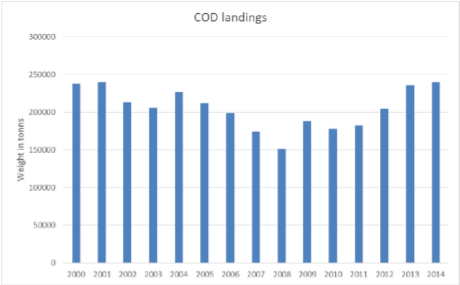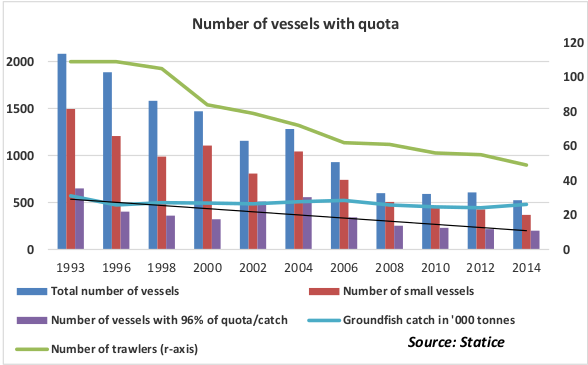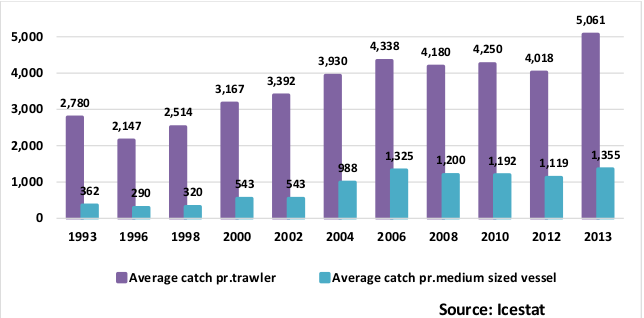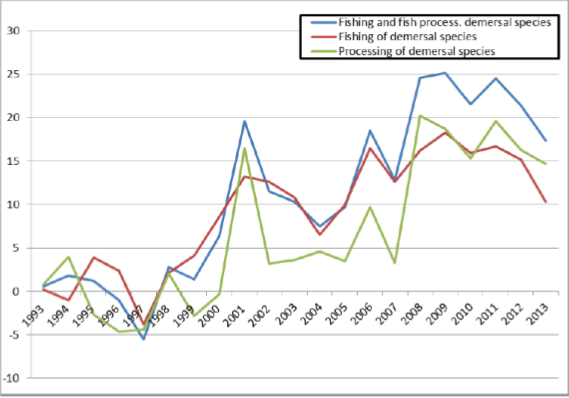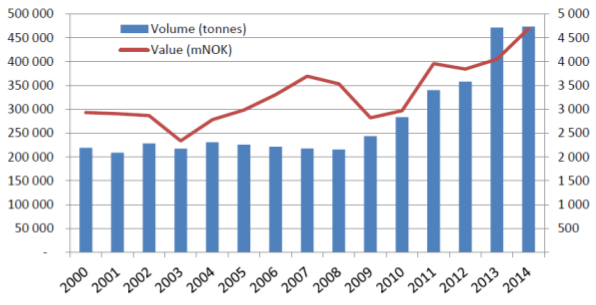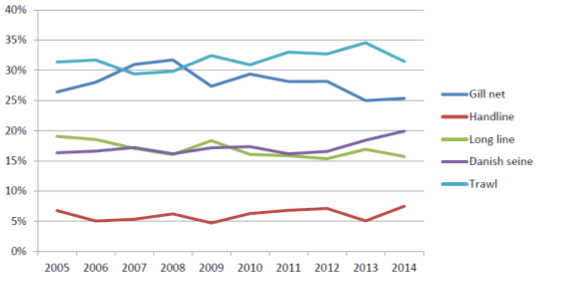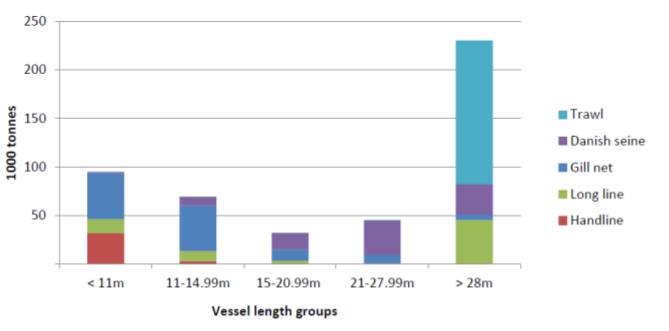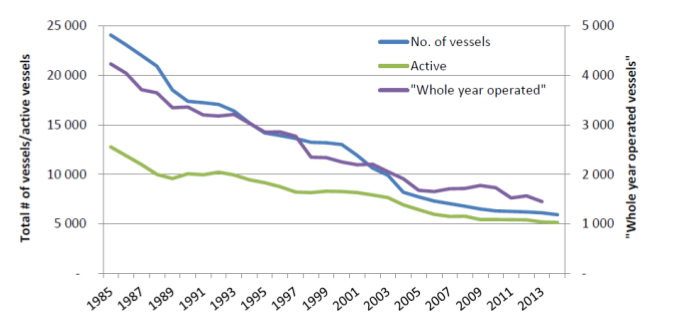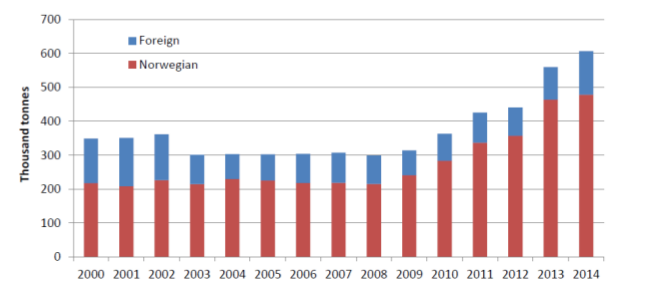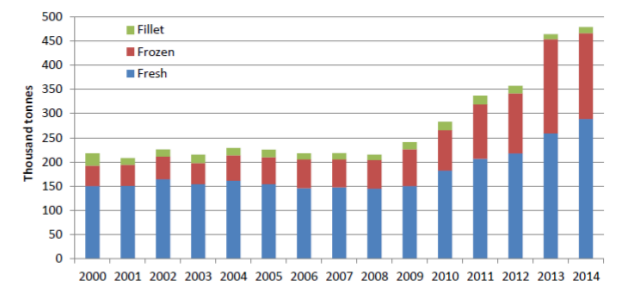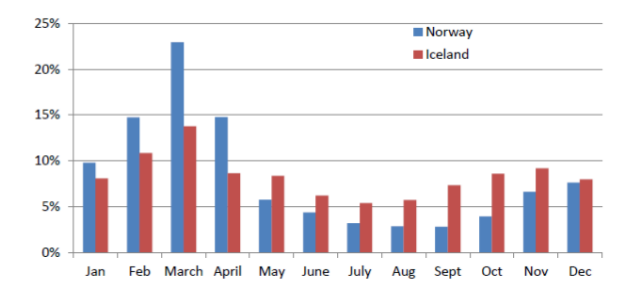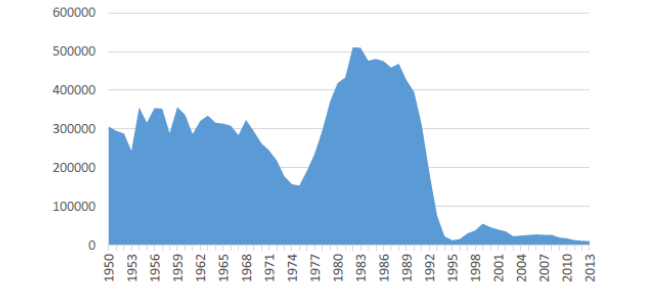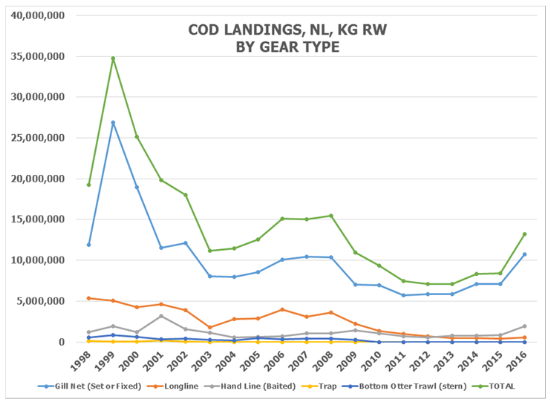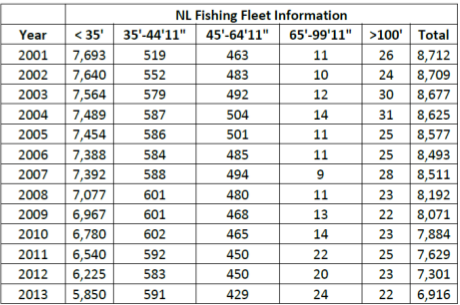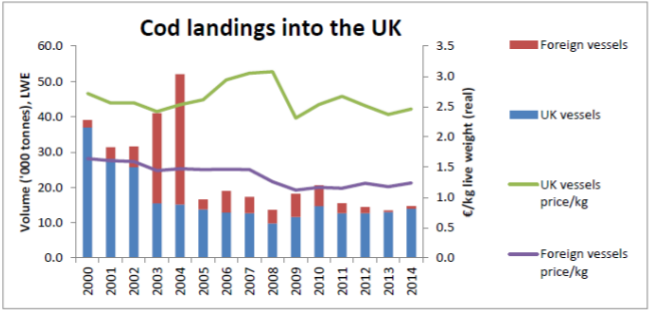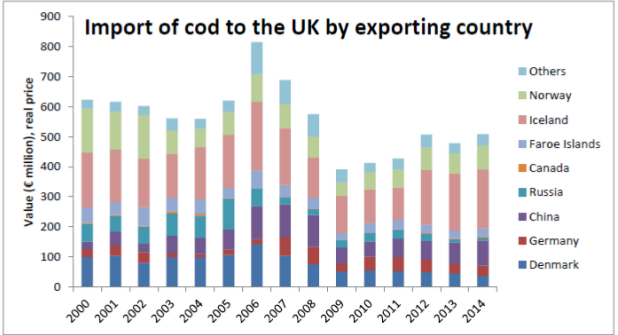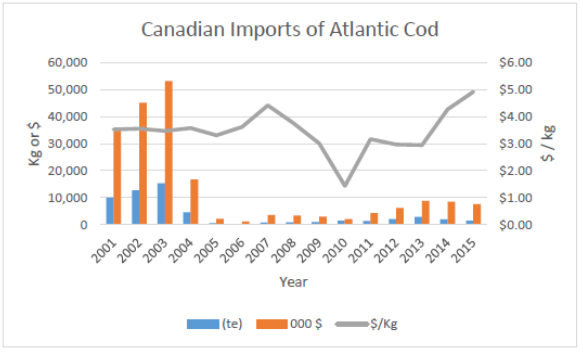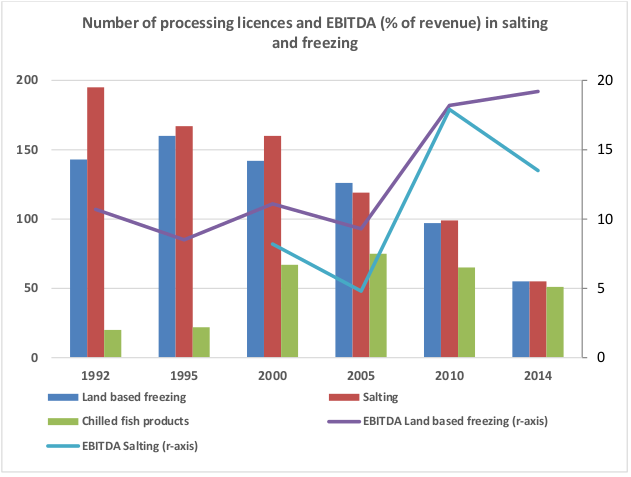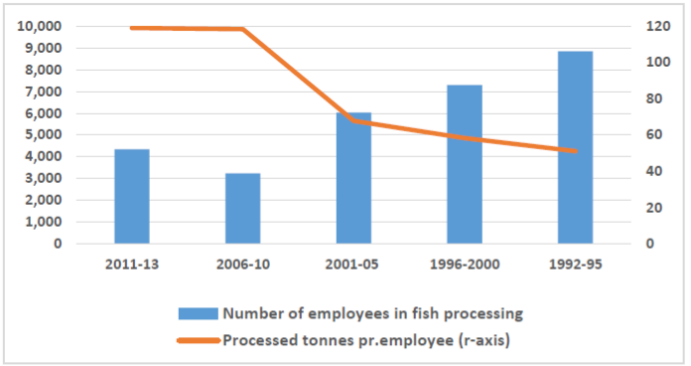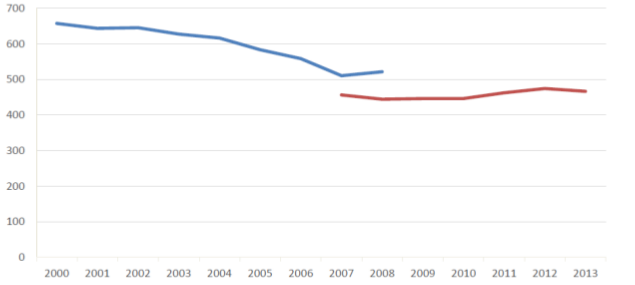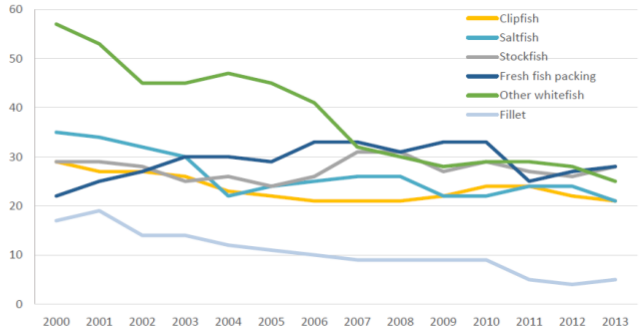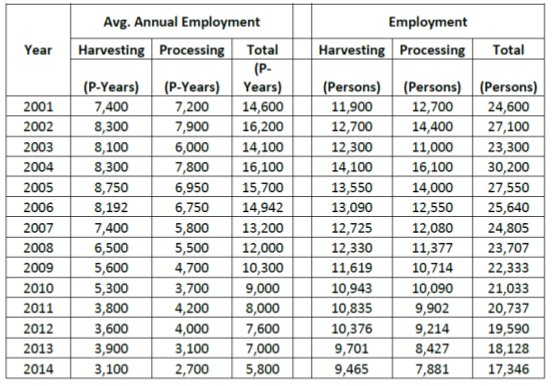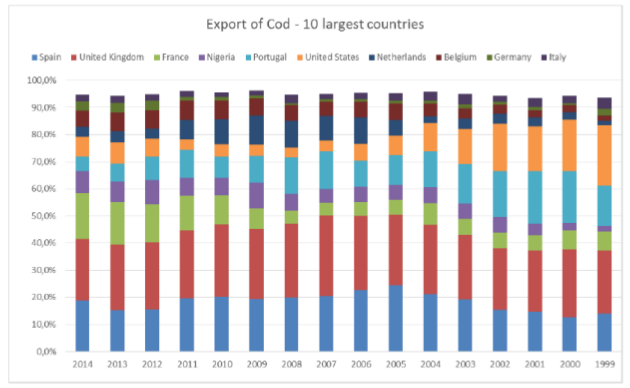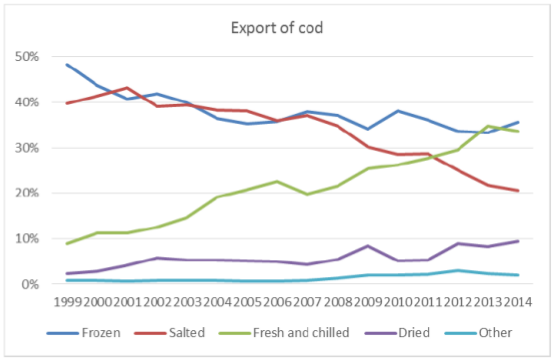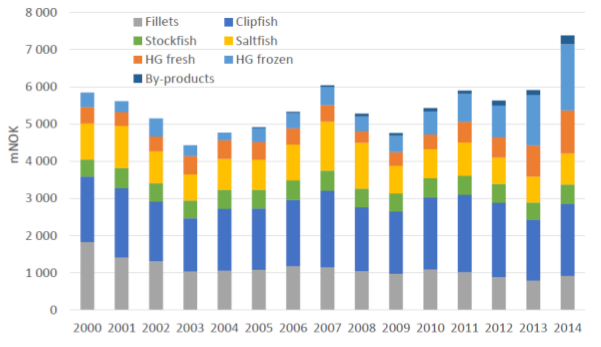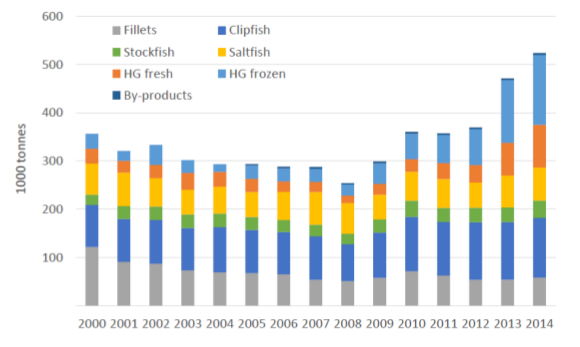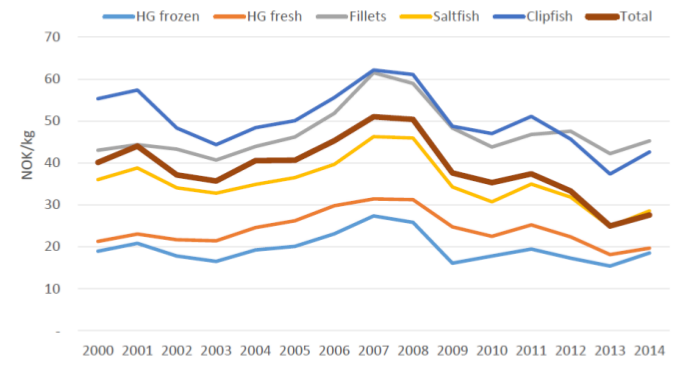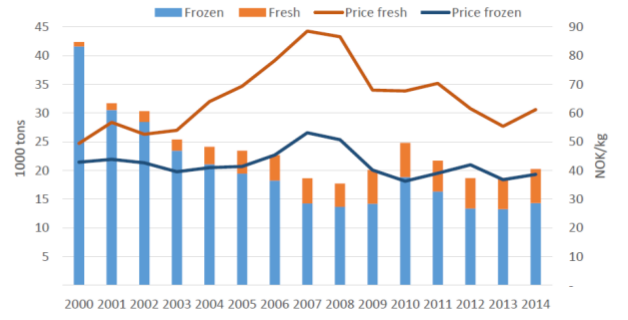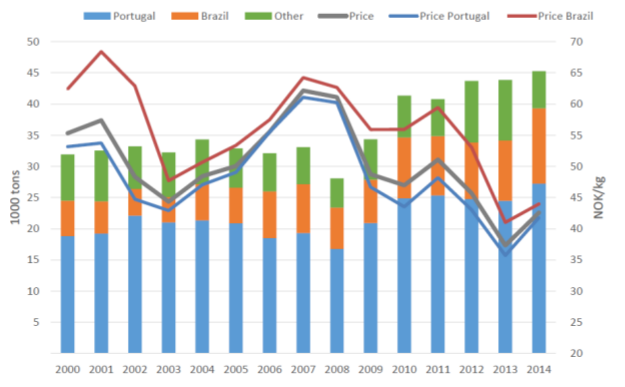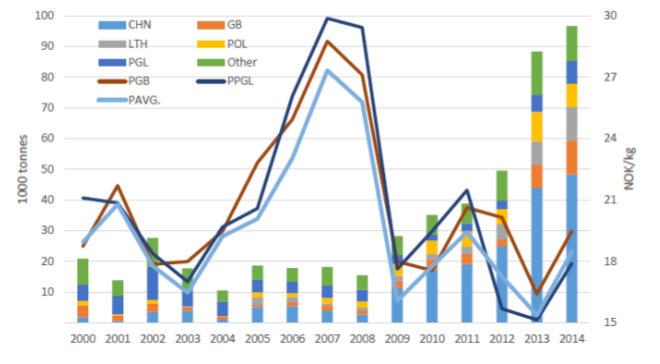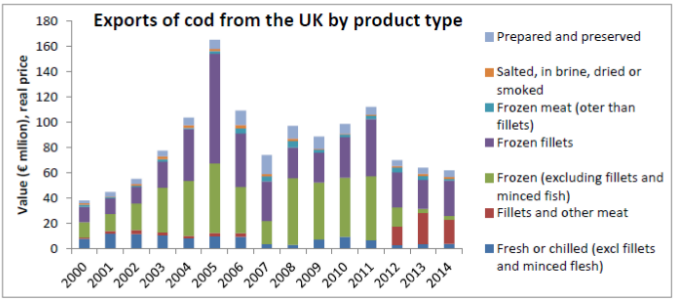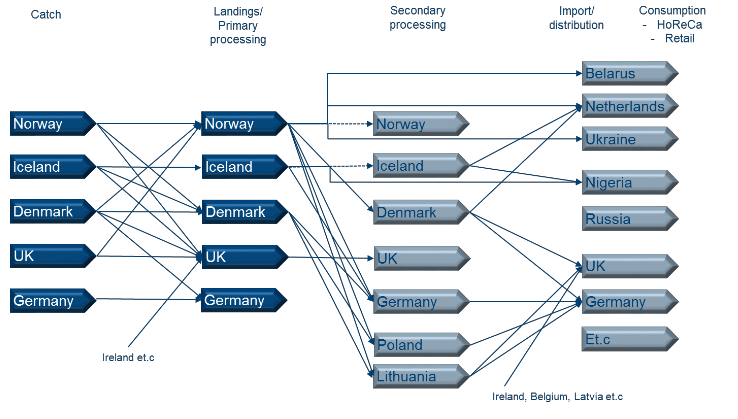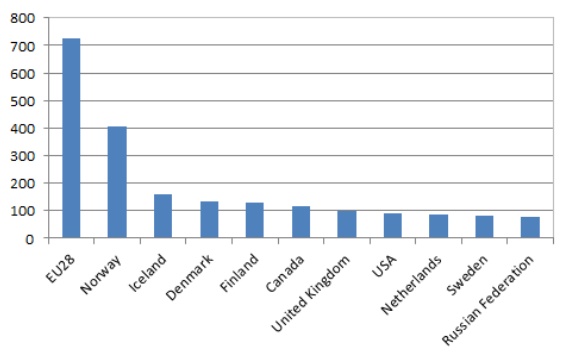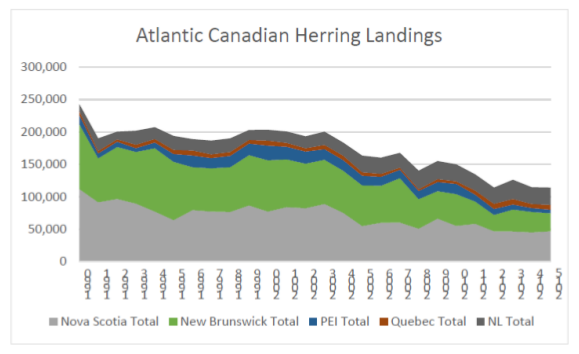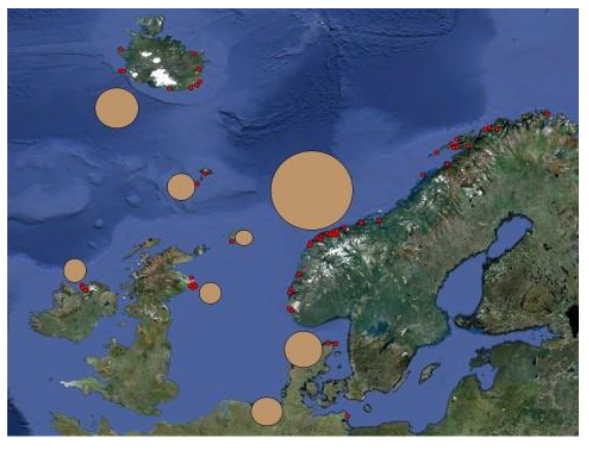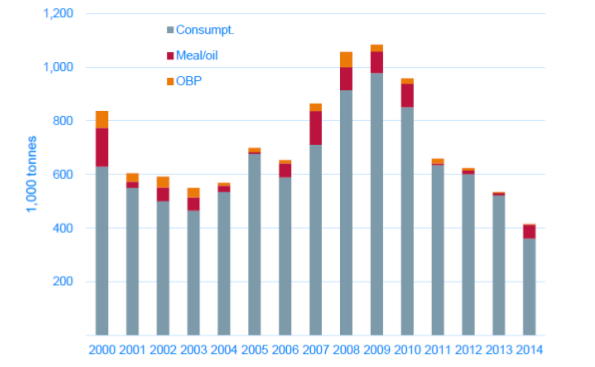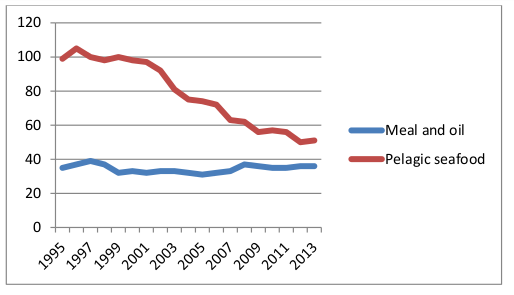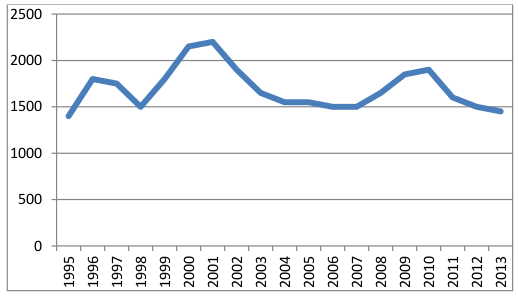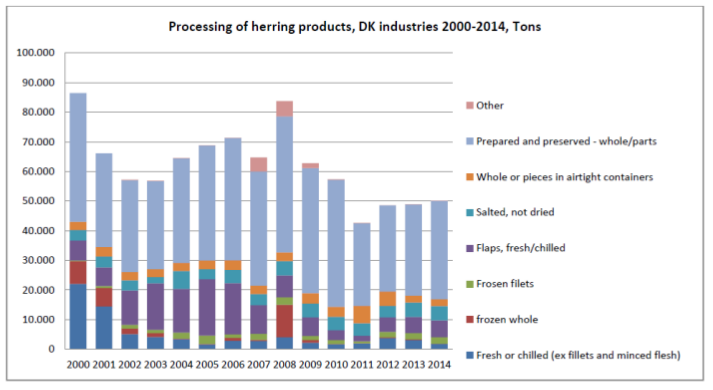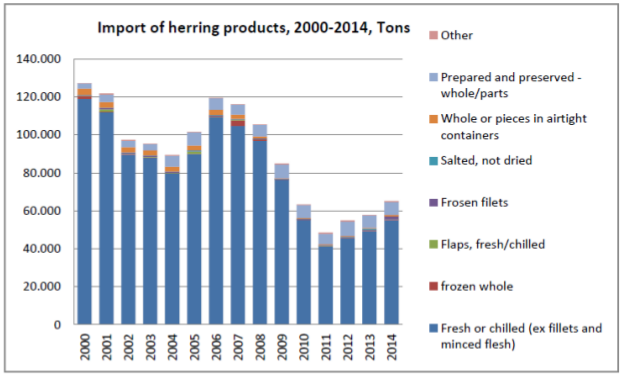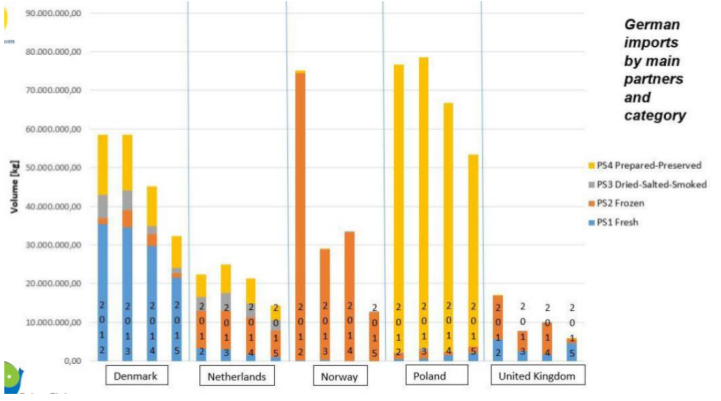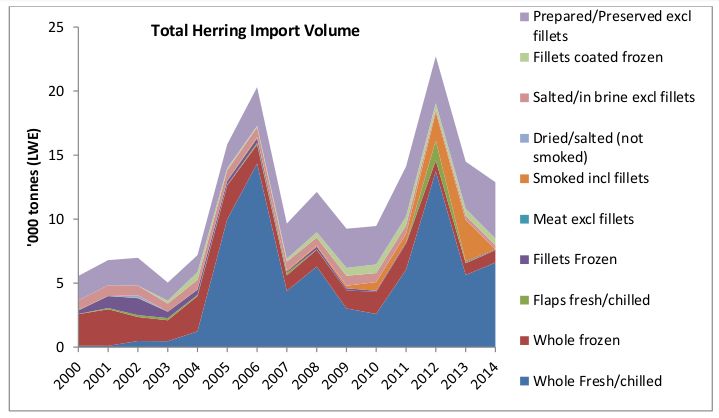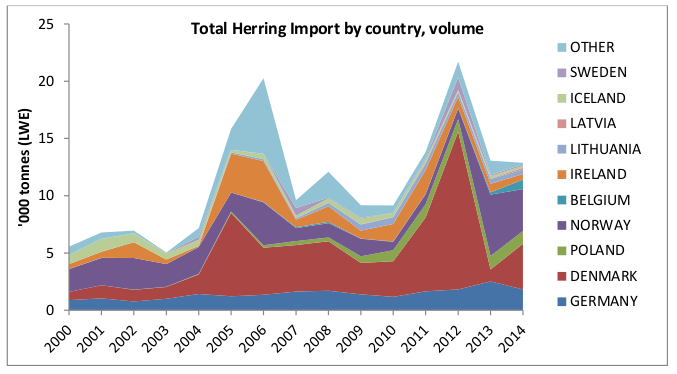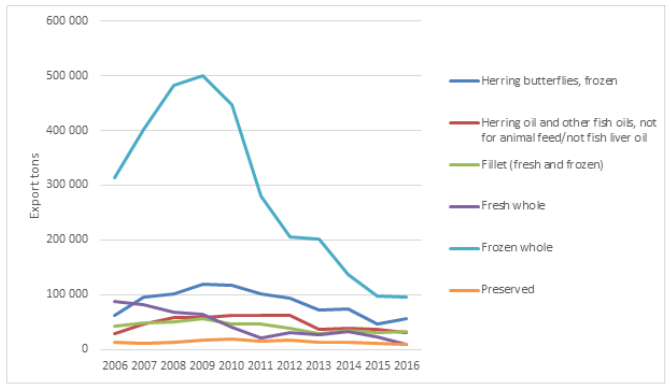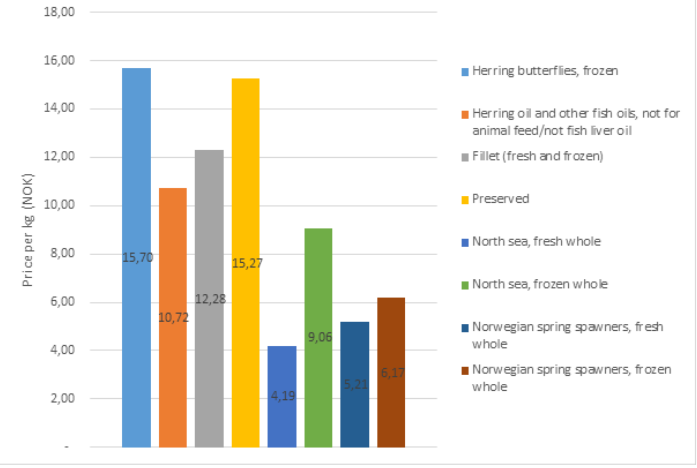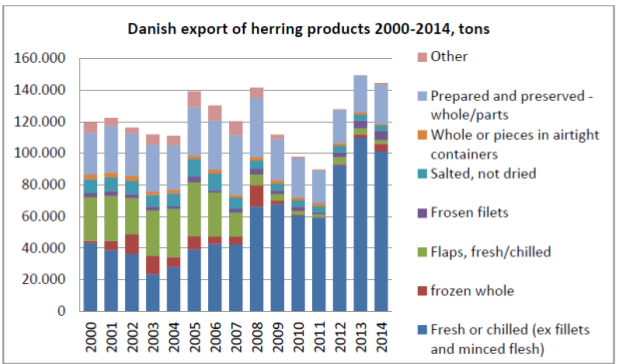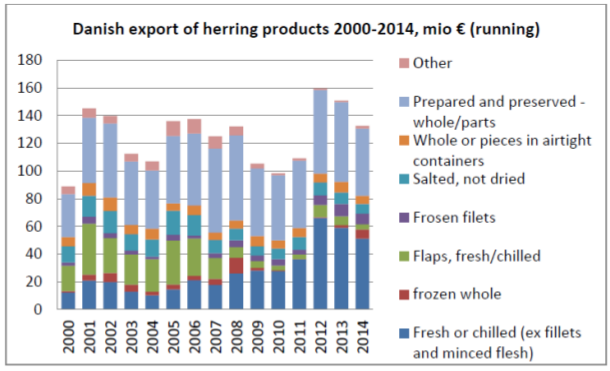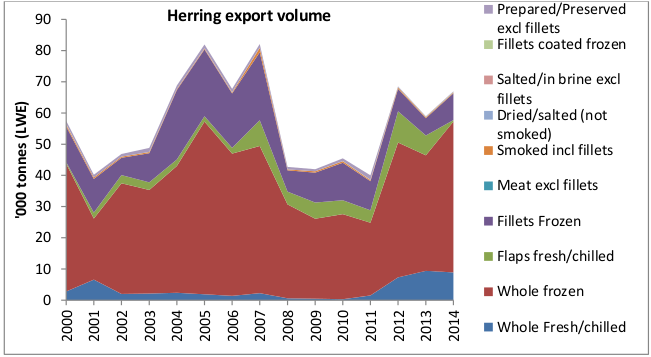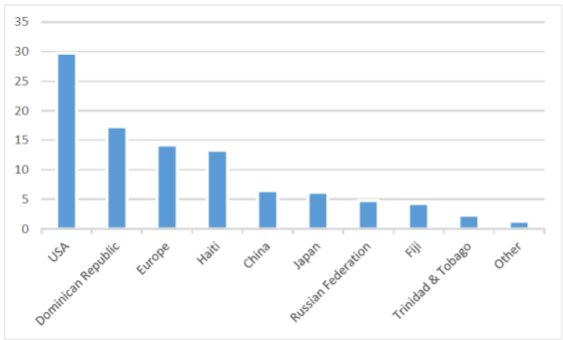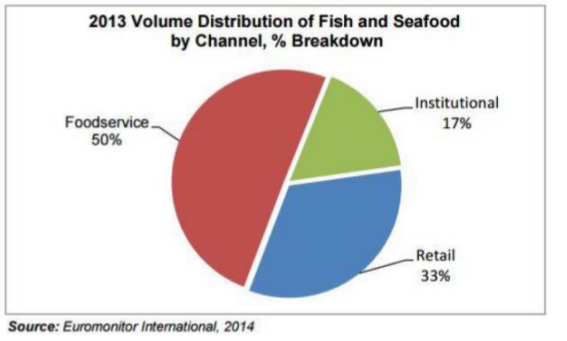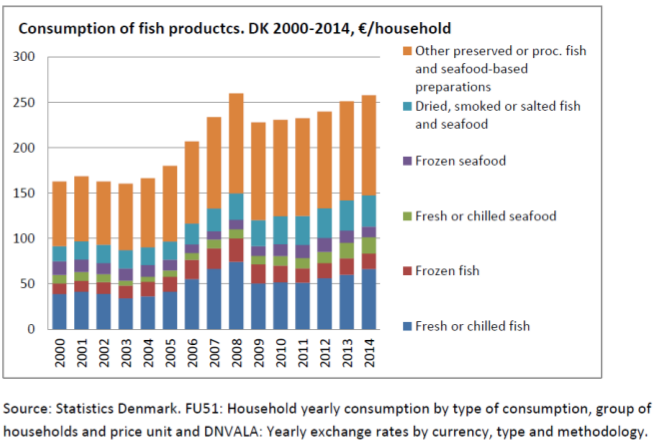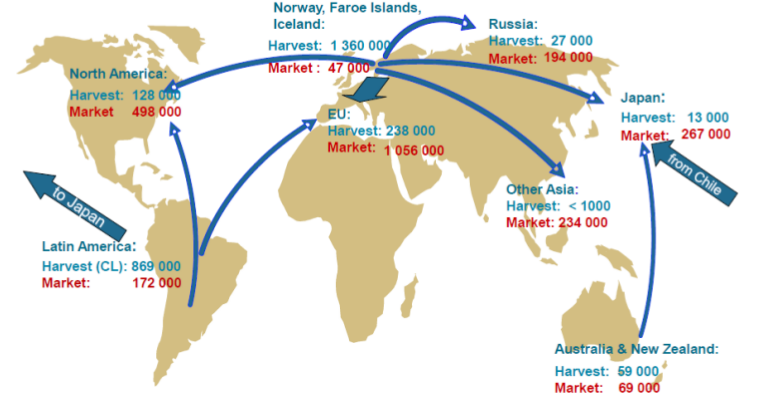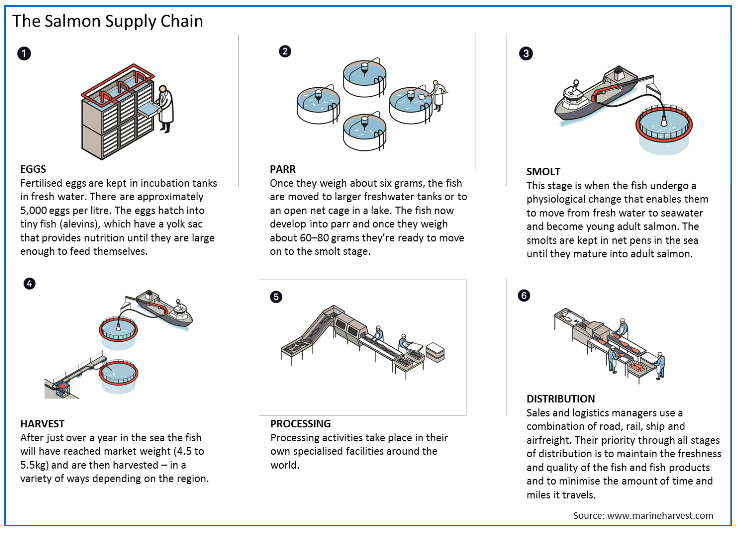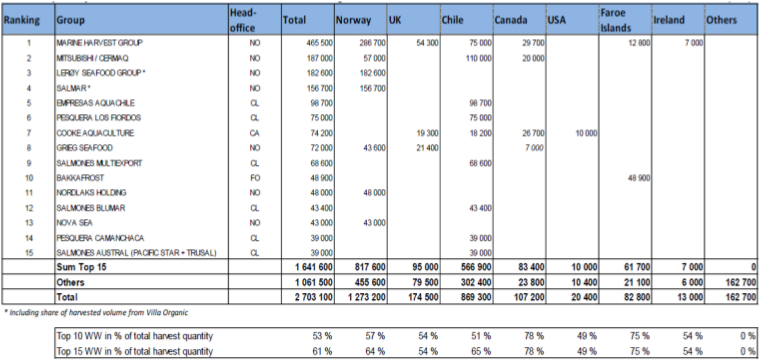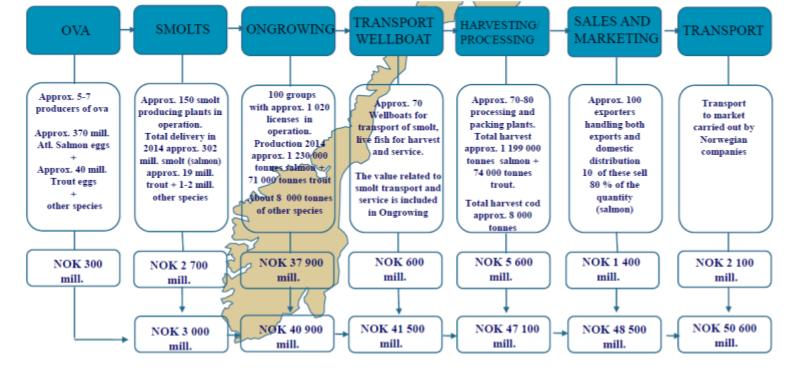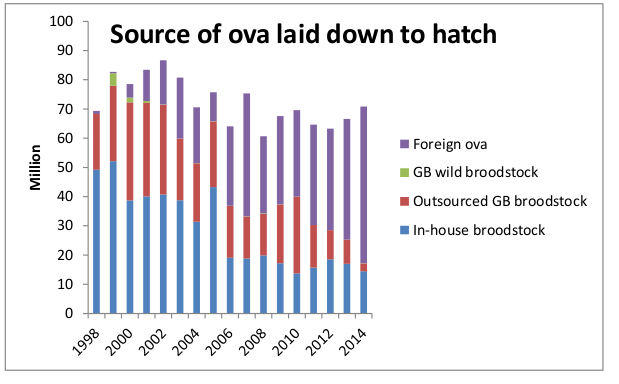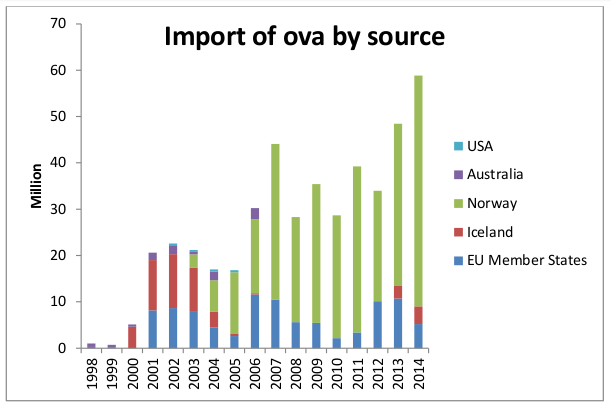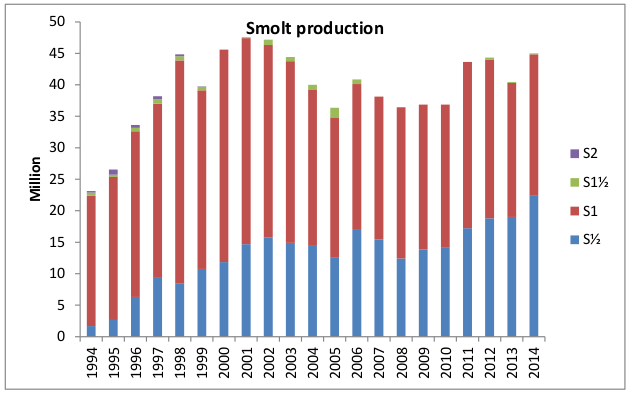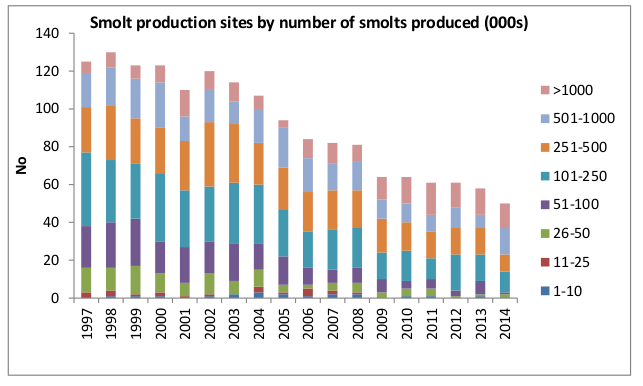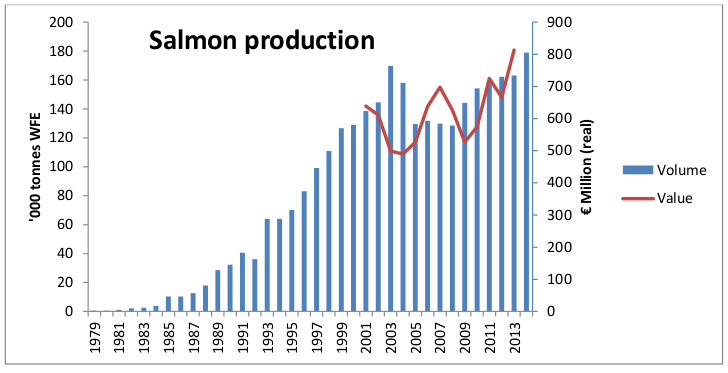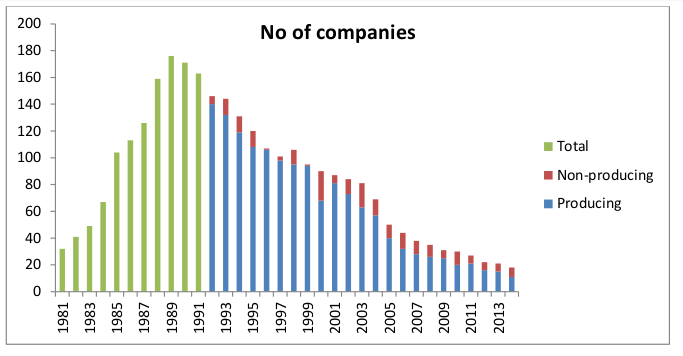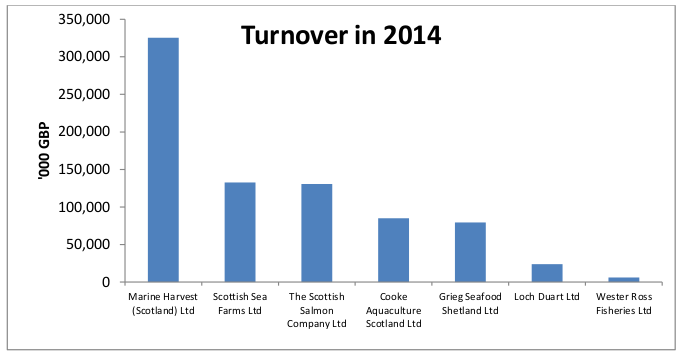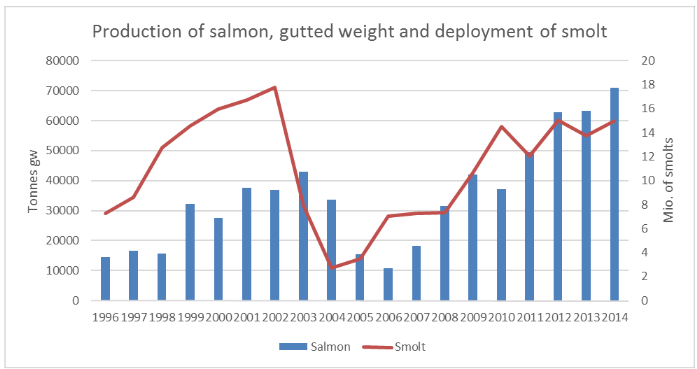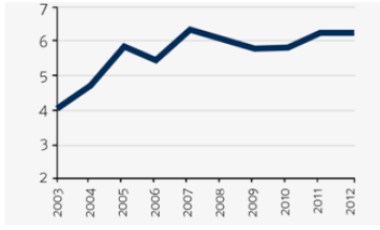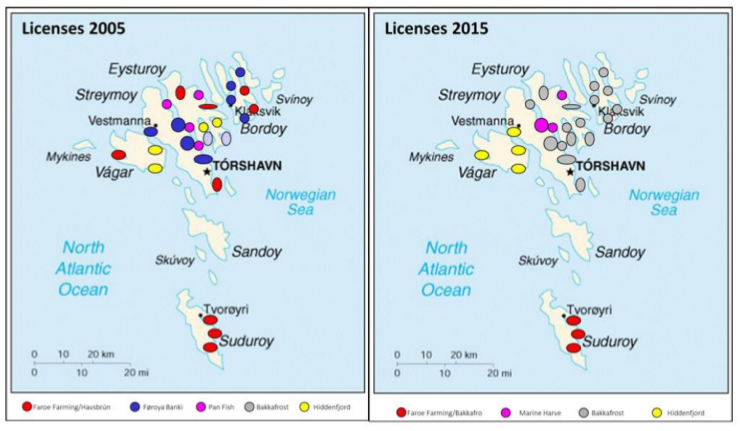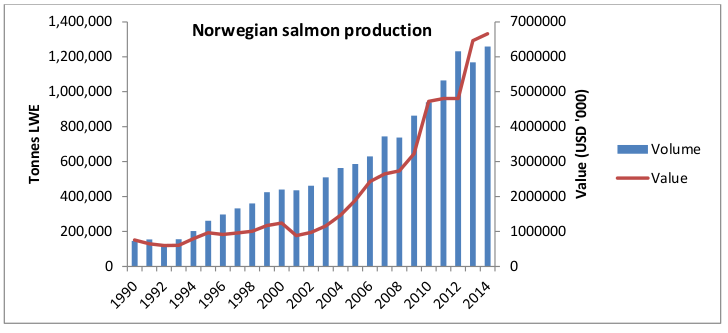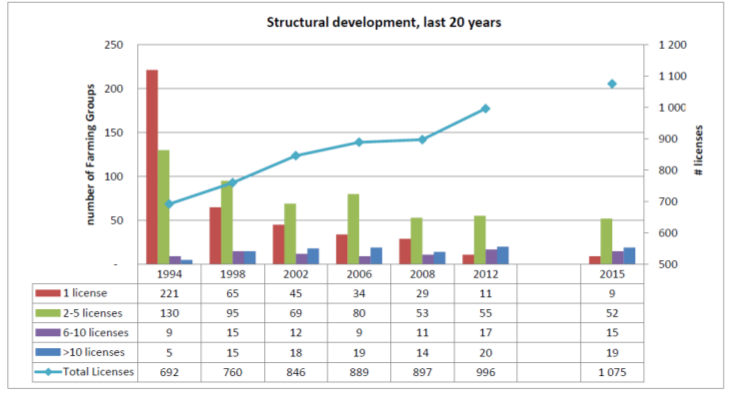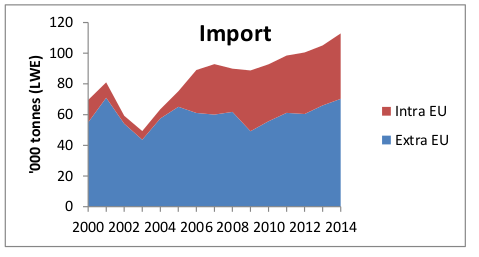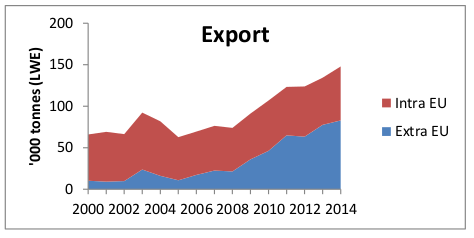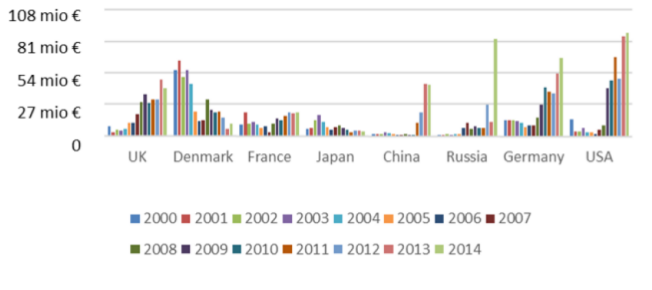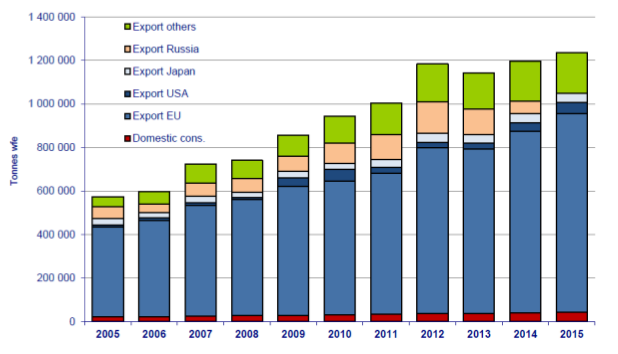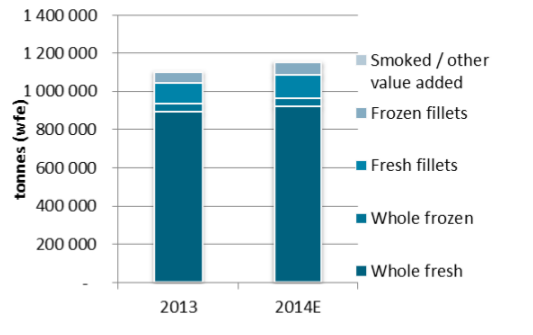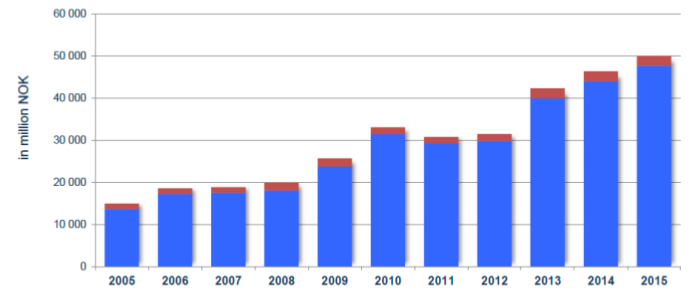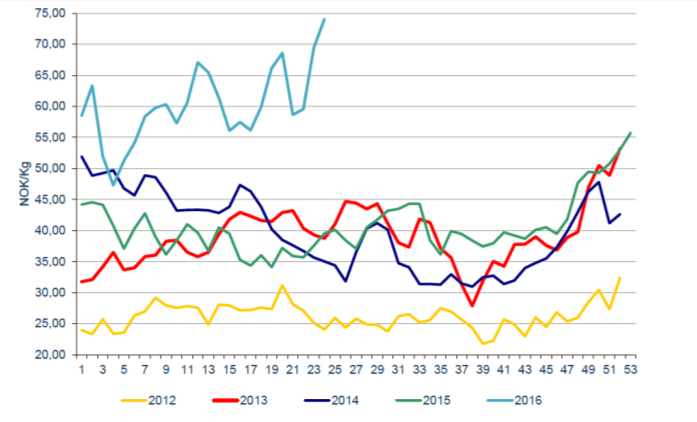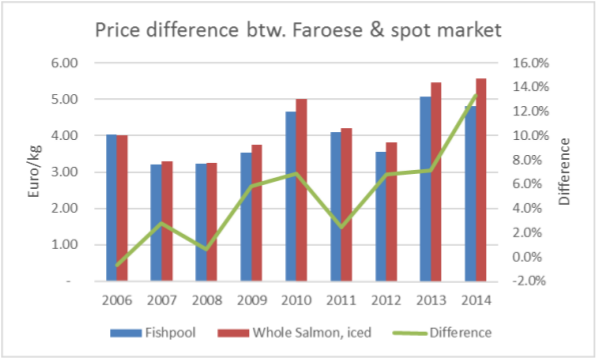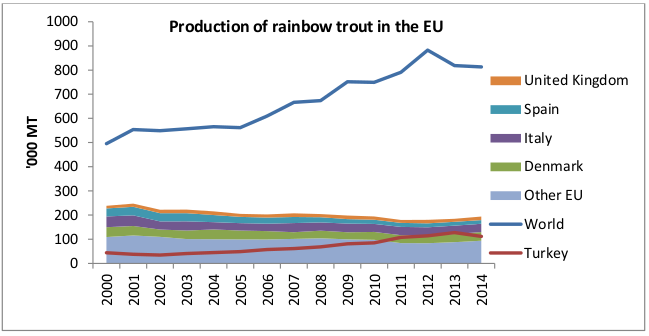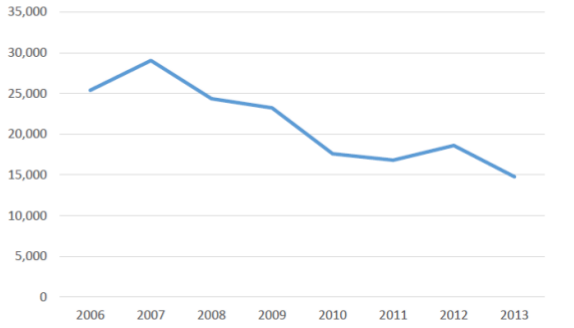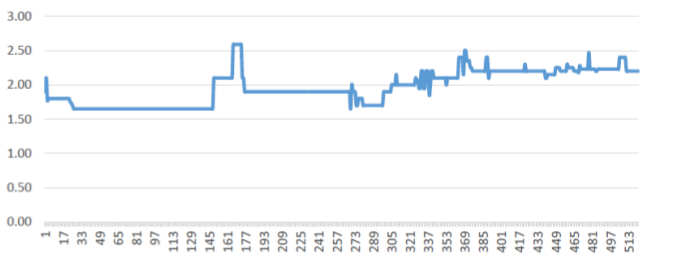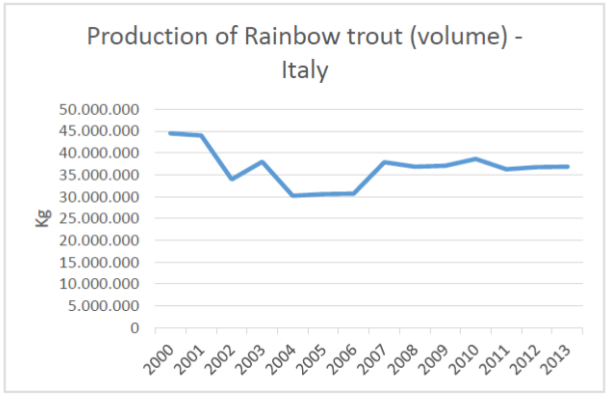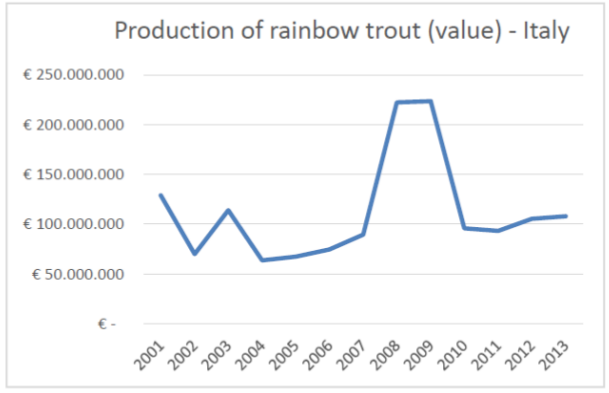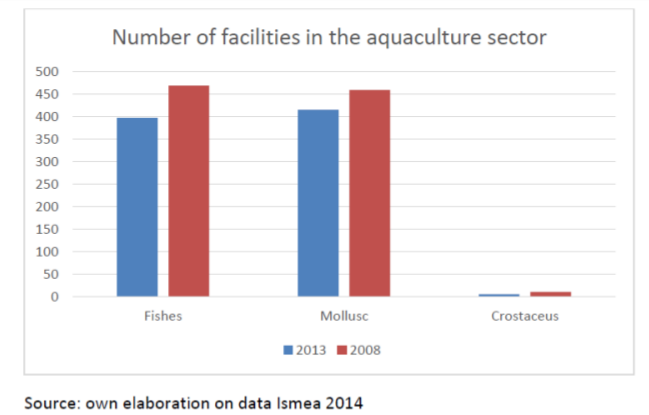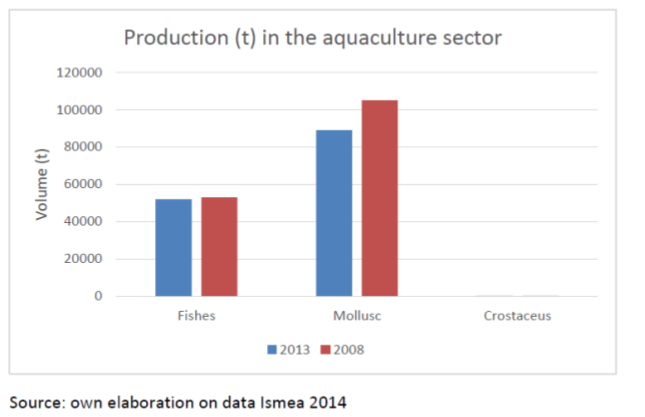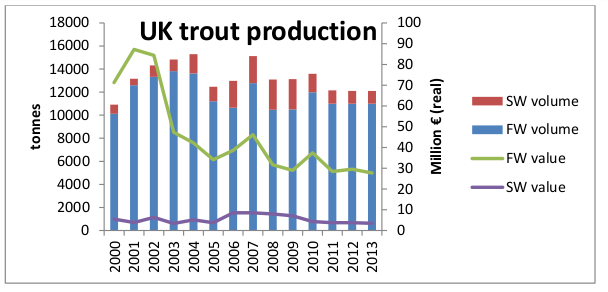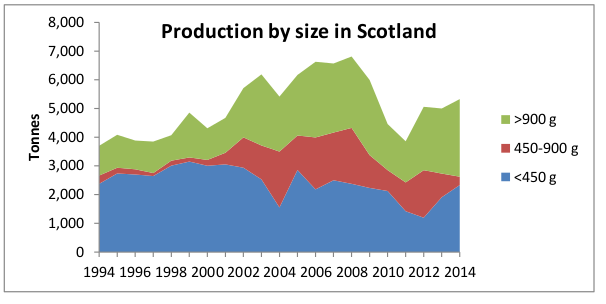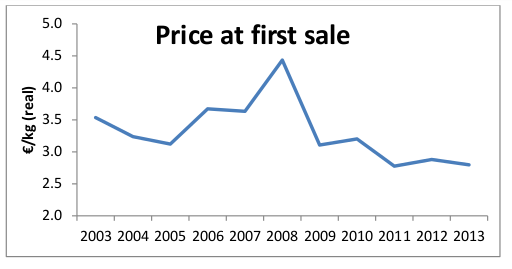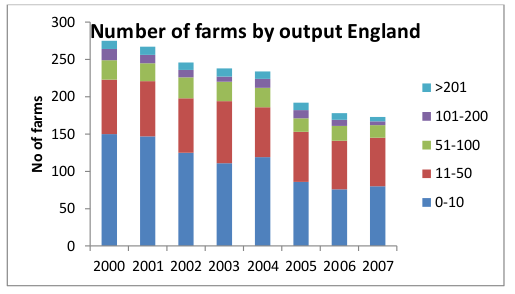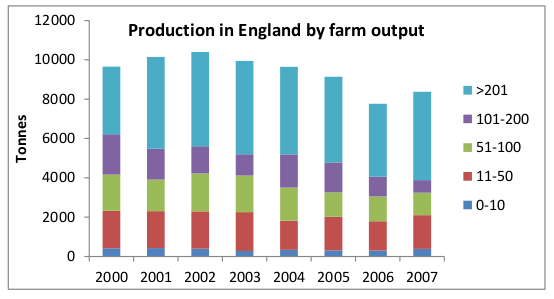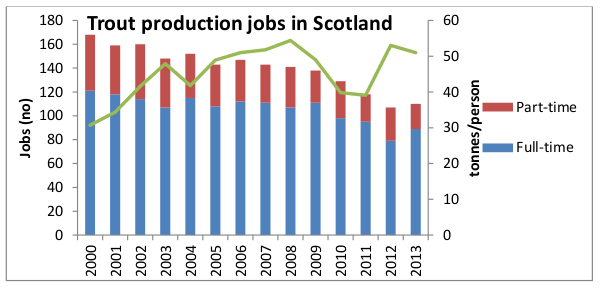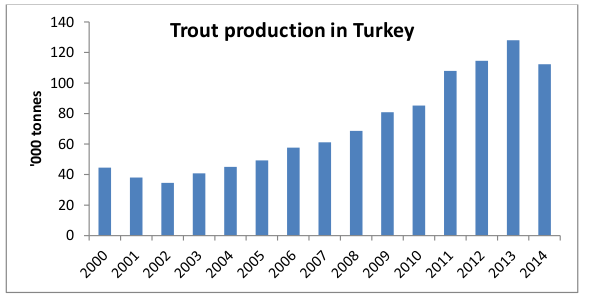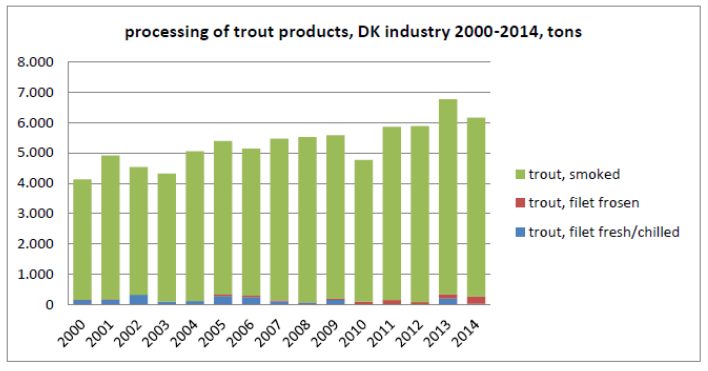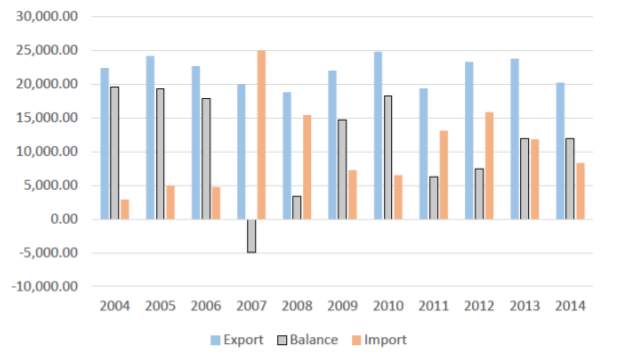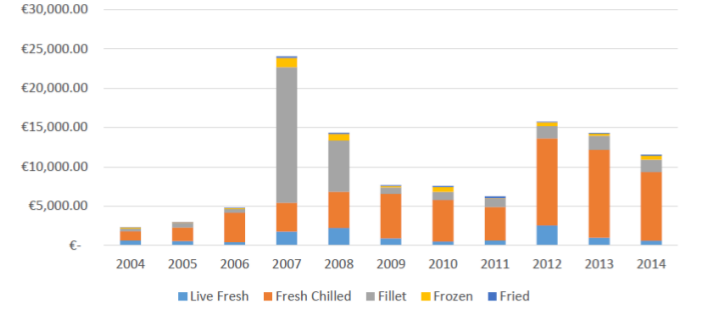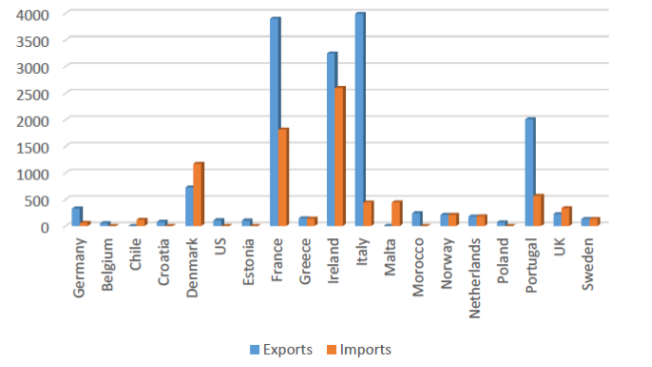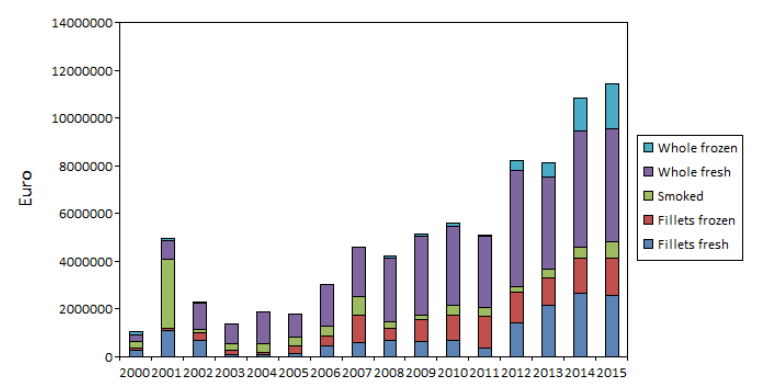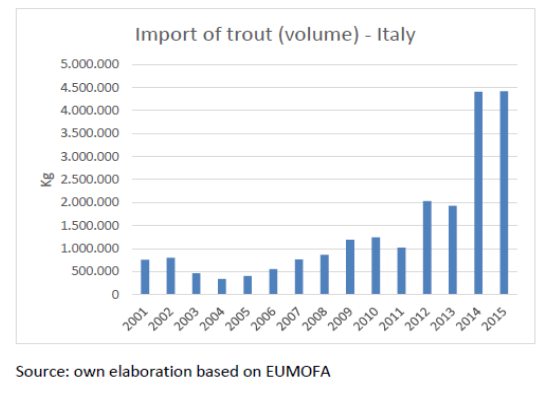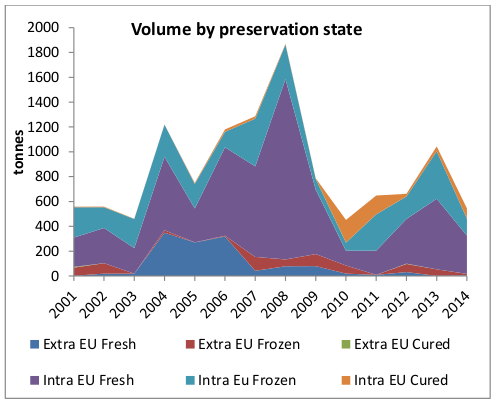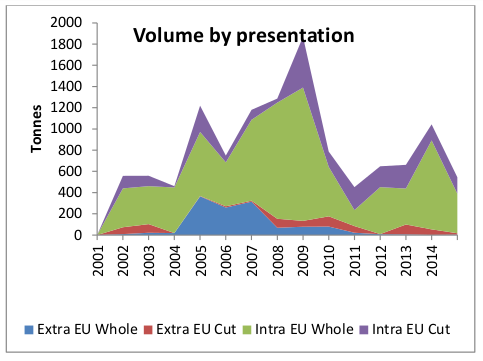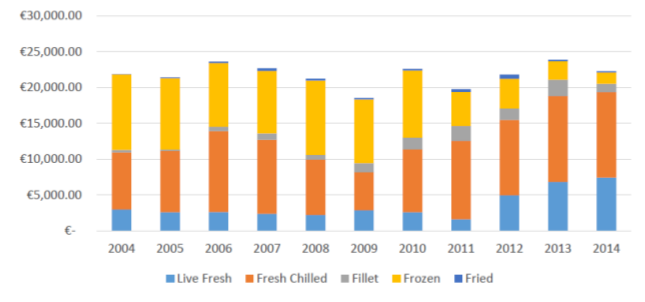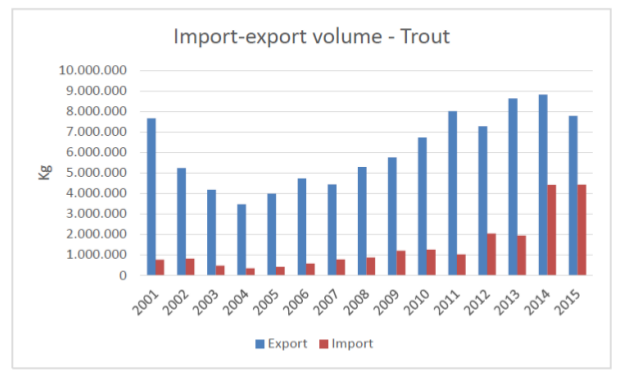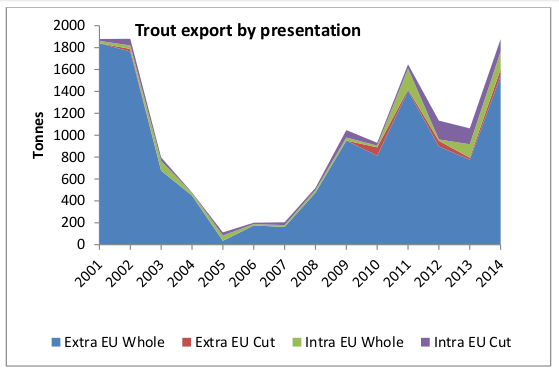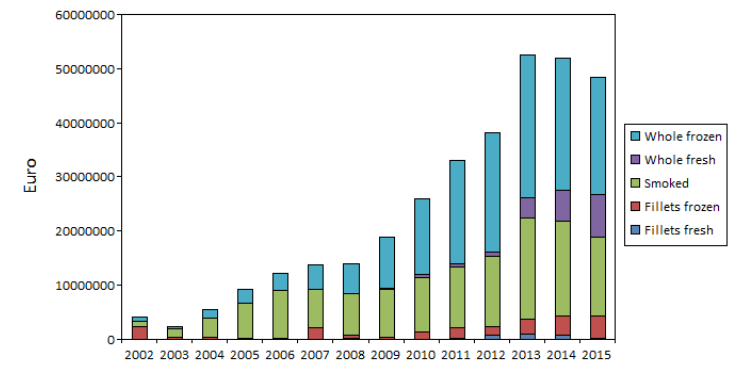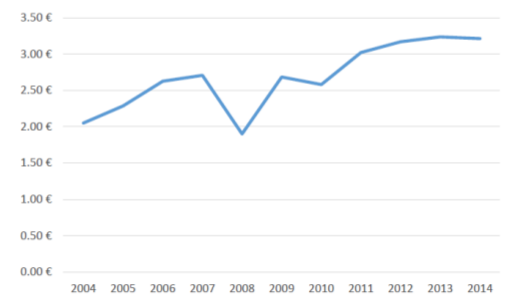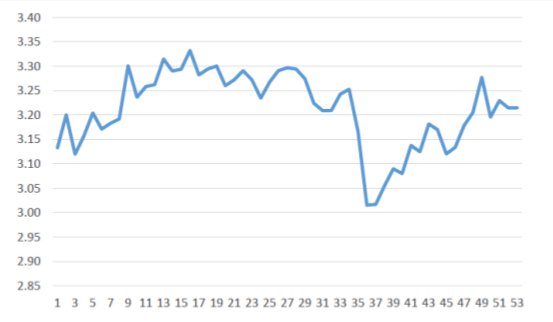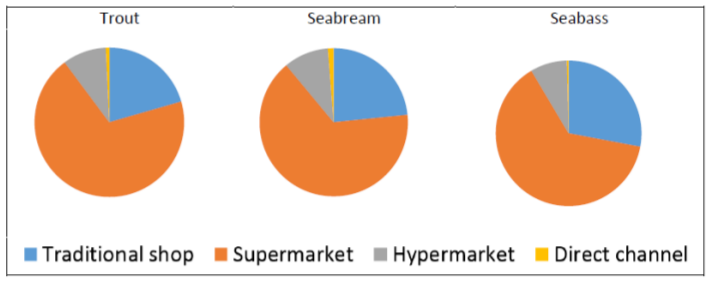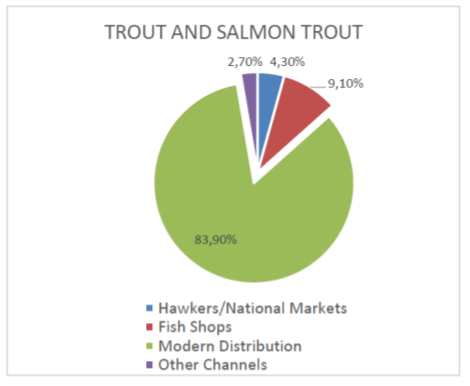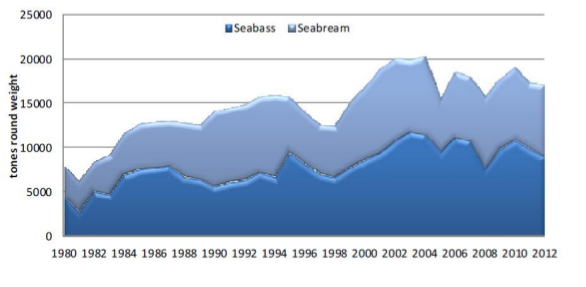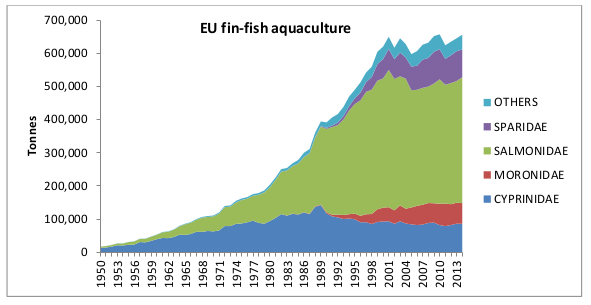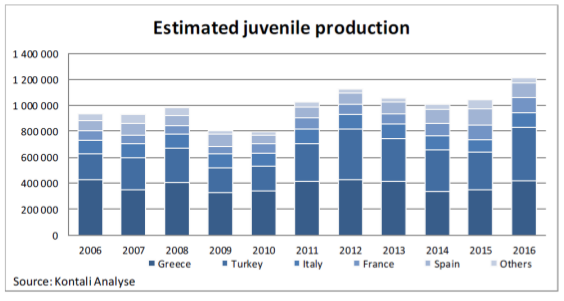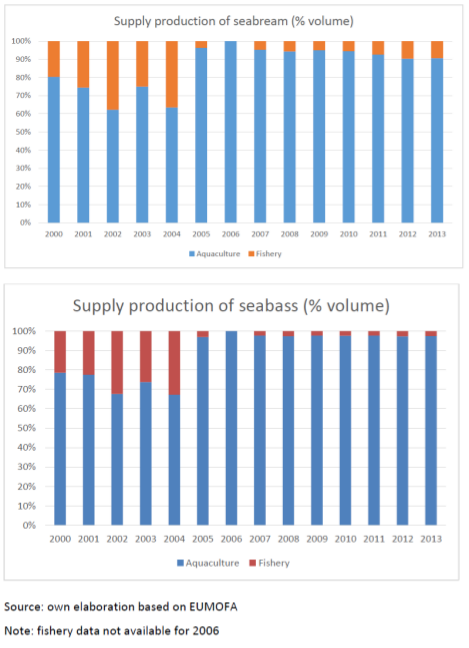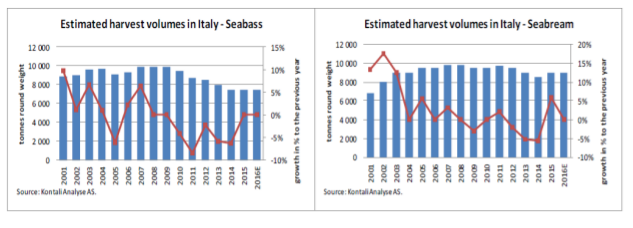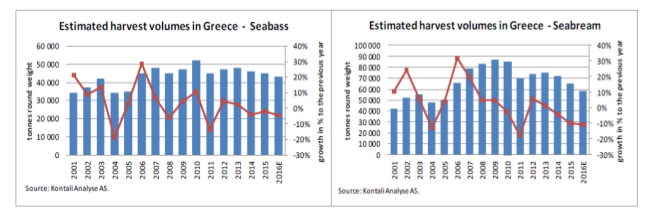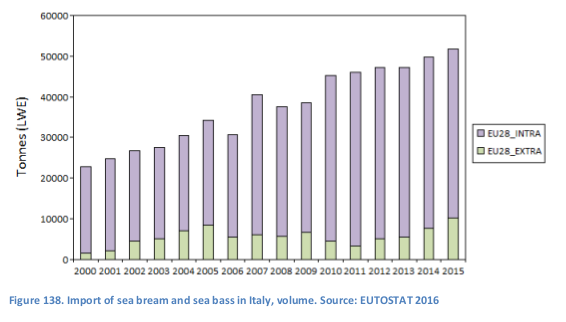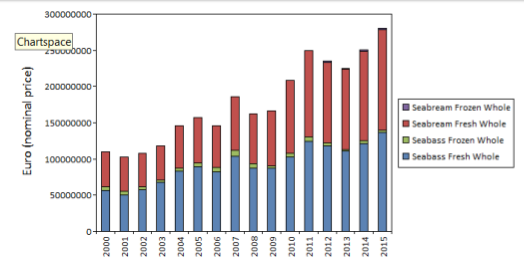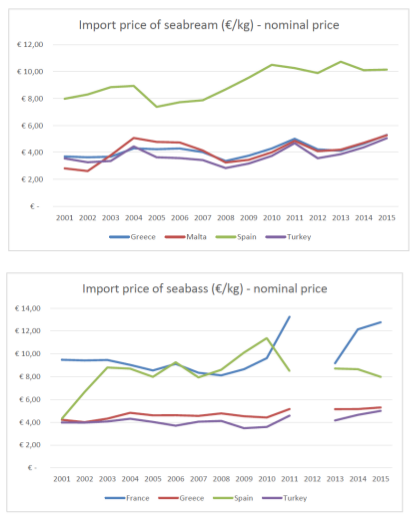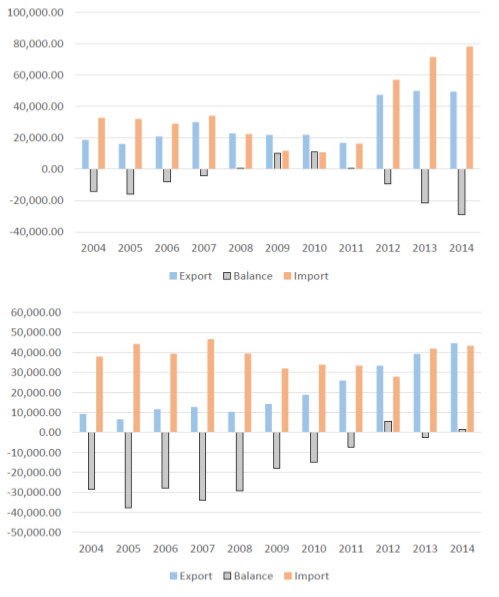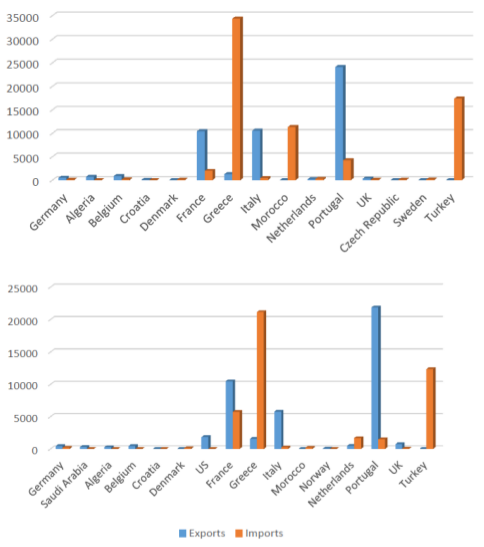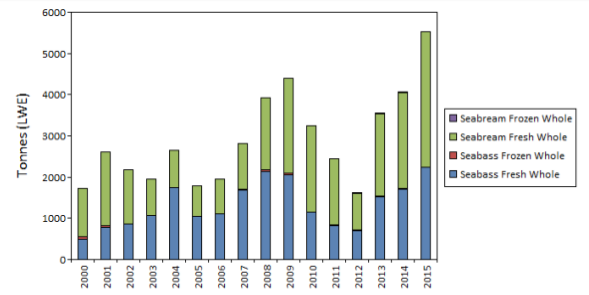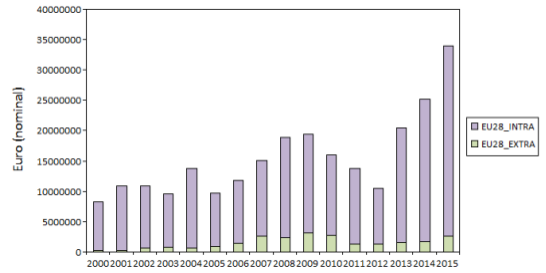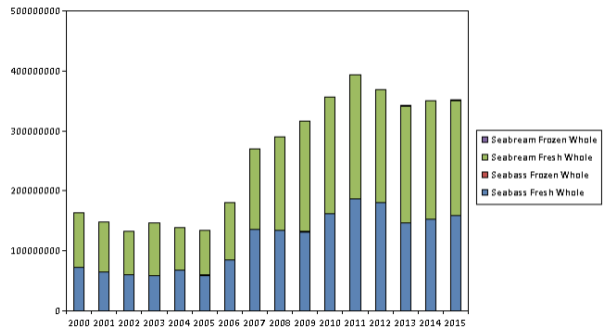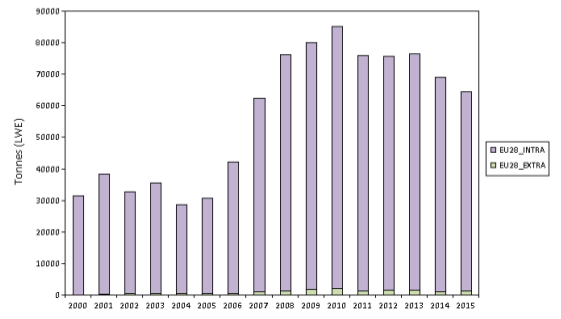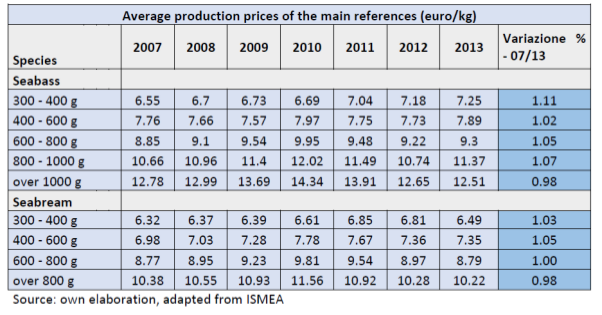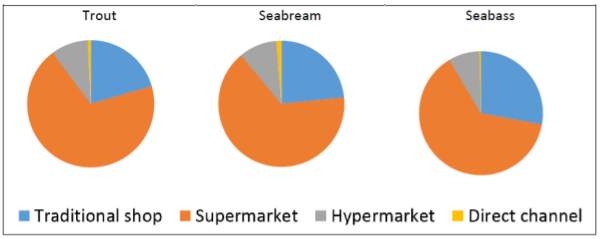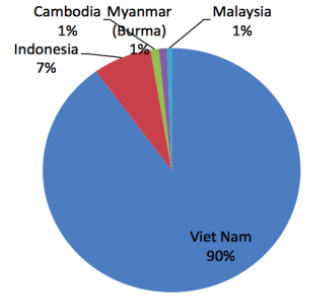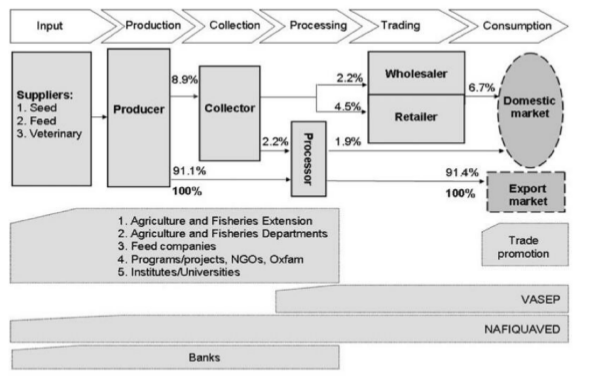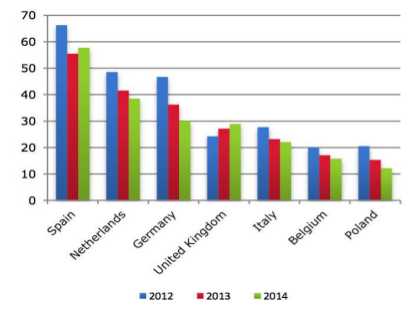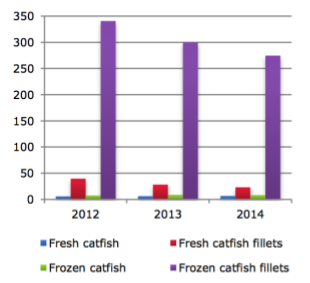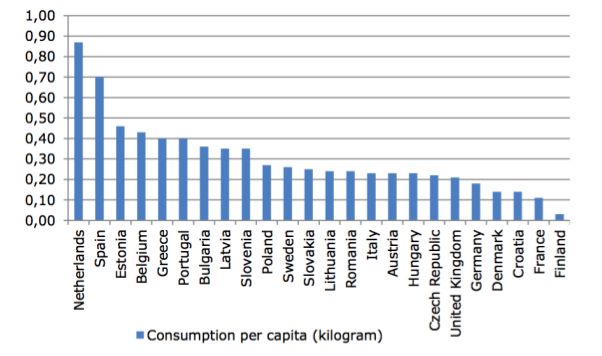Difference between revisions of "Deliverable 3.1"
Jacandrade (talk | contribs) |
Jacandrade (talk | contribs) |
||
| Line 3,662: | Line 3,662: | ||
Yordanova, T., Milliken, K., Cameron, A., Curtis, H., 2014. Uk seafood processing industry report. | Yordanova, T., Milliken, K., Cameron, A., Curtis, H., 2014. Uk seafood processing industry report. | ||
| − | == Appendix | + | == Appendix == |
---- | ---- | ||
Revision as of 17:24, 3 June 2018
Contents
- 1 Deliverable D3.1 - Report on description of value chains and input-output structure
- 1.1 Summary
- 1.2 Introduction
- 1.3 Atlantic cod
- 1.4 Atlantic Herring
- 1.5 Salmon
- 1.6 Rainbow trout
- 1.7 Sea bass & bream
- 1.8 Pangasius
- 1.9 Bibliography
- 1.10 Appendix
Deliverable D3.1 - Report on description of value chains and input-output structure
Summary
This report describes the main material flow in the supply chain (input-output structure) for the six commodity species (or species groups) that are the focus of PrimeFish; four farmed and two capture: (i) Atlantic Salmon, (ii) Rainbow Trout, (iii) European Sea bass (Dicentrarchus labrax) and gilthead sea bream (Sparus aurata) (iv) Pangasius catfish (Pangasius hypophthalmus) (v) Atlantic Cod (Gadus morhua) (vi) Atlantic Herring (Clupea herrengus). The latter two species are selected as examples of demersal and pelagic fisheries. Sea bass and sea bass are treated as a single group as almost perfect substitutes, sharing very similar production and post-harvest value-chain characteristics. The report is a synthesis of 17 individual value-chain reports. The report is based on publicly available data, and for each species covers (a) farmed production or landings (b) imports (c) processing (d) export (e) consumption.
Atlantic cod
Iceland and Norway are two of the world’s largest suppliers of cod, having access to abundant cod stocks in Norwegian and Icelandic waters. The catches have been growing over the last few years in in both Iceland and Norway. On the other hand, the UK has a small contribution to global catches even though quotas are slightly increasing. Since the collapse of the Canadian stocks of cod in early ‘90’s Canada has lost its global presence and its current landings represent a minor share of the global production of cod. There are indications that cod stocks in Canada may be recovering. In all countries there is a trend to consolidation in the industry towards fewer and larger vessels and companies. The bulk of the cod landings in Norway, Iceland and the UK are delivered by relatively large vessels in contrast Canada where boat of less than 10m in length still predominate. In Iceland there has been a shift from use of gillnets to trawl and long line. This can be explained to some extent by the better quality of product resulting from the latter methods of fishing. Consistent with this change, over recent years Iceland has specialised in production and export of fresh fillets with high quality assurance.
A large and increasing proportion of the Norwegian catch is landed frozen, while in Iceland the number of freeze trawlers have declined with a concomitant shift towards fresh landings and processing on land. The UK fleet lands its catches of cod whole fresh or gutted and a significant proportion of landings originate from third-country vessels. Canadian catches of cod are landed exclusively as fresh fish, destined primarily for primary processing and local retailing. Compared to Norway, Iceland benefits from lower variability in landings throughout the year which is an advantage when it comes to supplying multiple retail chains requiring continuity and predictability of supply.
With the exception of some foreign vessel landings in Norway, there is negligible import of cod to Iceland or Norway associated with their successful management of well-endowed fisheries. The UK on the other hand is a major market and importer of cod products, particularly frozen fillets which represent the highest share of imports. The main exporting countries to the UK are Iceland, China and Norway. Due to limited domestic supply, Atlantic cod is also imported into Canada for further processing and re-export and to supplement domestic markets though imports have declined over the last decade.
Cod processing in Norway, Iceland and the UK has undergone significant consolidation resulting in fewer but larger companies. In Iceland the consolidation process has been accompanied by increased investment and modernisation resulting in increased productivity, product quality and profitability.
In Iceland cod is predominantly processed into fresh fillets for export and the share of salted and dried products has declined over time. In Norway, by contrast a significant proportion of cod is still processed into dried and/or salted fish as well as frozen whole. The majority of UK companies processing cod specialise in secondary processing, primarily of imported frozen fillets into value added products. The Canadian processing sector consists of mainly small-scale primary processing companies, reliant partly on imports and partly on domestic landings.
The vast majority of the cod landed and processed in Iceland and Norway is exported. The main export markets for cod from Iceland are within the EU. Similarly, large proportion of the Norwegian exports target EU countries. In Norway the share of unprocessed whole gutted cod has increased in the last few years, particularly to China and Lithuania, where the fish undergoes further processing. Norway is also a main supplier of salted and dried fish to Portugal, which represents the largest market for these products. Exports from the UK are minor compared to Iceland and Norway and target mainly other EU member states. Canadian exports are also small and declining with the US and UK the major destinations.
Detailed publicly available data on retail and consumption is most readily accessible in the UK, where cod is one of the three most consumed species, along with salmon and tuna. The majority of cod sales in the UK are in the retail sector as fresh or frozen products. A large proportion of cod is also sold through food service outlets including traditional ‘fish and chip’ shops. In Iceland cod for the domestic market is mainly retailed through fishmongers and Horeca.
Atlantic herring
In all study countries catches of herring declined over the last decade reflected in lower quotas. Herring is currently targeted by the largest vessels in the national fleets of the countries examined here (>40m length). A trend of consolidation of vessel and quota ownership for pelagic species occurred across all main producer countries. This trend is likely driven by economies of scale which fishing for pelagic species benefits from together with the relatively low market prices commanded by pelagic species. Purse seine was the main gear type used in Norway, Denmark and the UK, while Iceland relied mostly on trawling gears.
The great majority of landings across countries was destined for human consumption and this share has been growing over time. In all countries most herring was processed by a few large companies, often vertically integrated; also owning multi-species pelagic fishing vessels. Thus the level of concentration in processing has been mirrored in the capture sector. Denmark and Germany undertook most of the secondary processing, while main producer countries (Iceland and Norway) exported unprocessed or minimally processed herring products. The share of value added herring products from Iceland has declined in favour of low value added, filets and frozen fish, the production of which benefits from economies of scale.
Germany and Denmark with large consumer markets and processing capacity import substantial amounts of herring. Imports to Norway and the UK were mostly low value fresh fish landed in those countries by foreign vessels. A small quantity of value-added herring imports in Iceland is directed to the domestic consumption market.
Almost the entire landings of herring in Iceland and Norway were destined for export. The main markets have historically been Eastern Europe and Russia. However, these markets have recently become less important due to political reasons. Denmark supplies Central and Northern European countries while the UK supplies Western Europe and African countries.
Atlantic salmon
Salmon production around the world has steadily matured into an industry dominated by vertically and horizontally integrated multinational companies. Among the three countries examined here, the Faroese salmon industry is by far the most consolidated followed by Scotland and Norway.
Consolidation has been accompanied increased investment and consequent improvements in productivity and competitiveness. Mergers and acquisitions have played a central role in sector consolidation as increasingly stringent environmental regulations have limited ‘organic’ expansion in more sheltered inshore sites European and other countries.
Environmental conditions in the Faroes, notably water temperature are more stable throughout the year than in Norway or Scotland. Norwegian and Scottish production has stabilised following 3 decades of rapid growth, while in the Faroes, growth continues. In all three countries 'Boom and bust cycles', linked to overproduction and falling prices appear to have moderated with industry consolidation.
Most processing is limited to gutting, freezing and filleting in the Faroes and Norway due to export tariffs for value-added products linked to the countries membership of the EAA but not the EU. A large share of UK production is processed into value-added goods where a large domestic market exists, salmon being the top retail seafood. The UK also imports significant amounts of salmon from Non-EU countries especially the Faroes and Norway which is mainly farmed for export.
Although the UK has seen significant export growth, most export production originates from non-EU countries. Faroese exports have recorded strong growth in the German, UK, USA, Chinese and particularly Russian market (the Faroes were excluded from the ban on imports from western countries introduced in 2014). Norway has achieved strong growth in exports to the EU, which also accounts for the vast majority of its exports. The Faroes specialise in production of ‘above-average’ sized salmon commanding a better price than typical Norwegian and Scottish salmon. However, Scotland achieves a premium for its ‘Label Rouge’ certified premium quality salmon (around 8% of production) further enhanced by ‘Scottish’ origin branding.
Rainbow trout
Production of rainbow trout in Spain and the UK has declined in the period 2000-2014 to reach similar volumes of around 15,000 t in both countries. UK production is predominantly of table-size trout. Only the largest company is progressively transitioning to marine cage farming. Production in Spain is also mainly of table-size trout. Denmark and Italy both exhibit relatively stable production trends, though Denmark has increased the share of production originating from modern recirculation systems (RAS). Around one quarter of Danish output also originates from marine cages where fish are grown to a larger size. Turkey farms more trout than the other four study countries combined and only here has output increased substantively over the last decade, though growth has also flattened here over the last few years. Most output comes from land-based pond and raceway systems where fish are grown to around 300g. Larger export-orientated companies are attempting to farm larger sizes in order to avoid tariffs on import of table size trout into the EU. The number of companies involved in trout production in all EU countries has been decreasing. This is part of an overall European-wide trend for consolidation in aquaculture. In the UK less than 10 companies account for more than half of the domestic trout production, while the Danish sector has shown an increased output per farm due to growing productivity and increased capacity. In Turkey trout aquaculture is still composed of a large number of small owner-operated companies, however with increasing presence of integrated export-oriented companies.
Limited data on trout processing indicates that in the Spain and the UK trout undergoes small amounts of processing, being marketed mostly as a fresh whole fish on the domestic market. Larger size trout from the UK however is processed into a variety of value-added products. Denmark shows the highest level of value-addition where smoked trout products occupy the largest share of trout processing and export. In Italy, where the market has traditionally been for whole fresh fish, value- added trout products increasingly gain prominence on the domestic market but exports continue to be composed of whole fresh fish or fresh fillets. Turkey has focused on a combination of lower value frozen whole fish and higher value smoked trout. Limited international trade with trout was recorded in the UK in the period 2000-2014. Slightly higher but more stable levels of export were present in Spain. Of all countries, Denmark recorded the highest level of exports in terms of value, around half of which represented by smoked trout products.
Exports from Italy and Denmark are mainly to the EU whilst Spanish exports fresh trout are more limited to neighbouring countries. Turkey mainly exports whole frozen and smoked trout with Germany being as its largest market where it competes directly with significant amounts of smoked trout produced and exported from Denmark.
Sea bass and sea bream
Sea bass and sea bream form a significant proportion of EU aquaculture output. Production and market demand is concentrated around the Mediterranean. Greece is the world’s largest producer of sea bream and second largest in sea bass after Turkey. However its production has stabilised and even slightly declined over recent years, likely due to market saturation. The same can be said about the Italian sector. The only growth in production was for sea bass in Spain. Spain grows fish to a larger size than Greece and achieves a better price on the international market.
Value chains for these species are less vertically integrated ‘upstream’ because of technical requirements in the reproduction and on-growing stages, resulting in the formation of specialised firms dealing with brood stock and juvenile production. However, the exact number of establishments in each link of the value chain for sea bass and sea bream could not be confirmed.
In Mediterranean markets sea bass and sea bream are mostly sold whole fresh with only limited processing, mainly filleting. This lack of specialisation means value chains are shorter than for other aquaculture species such as salmon. Thus there is little differentiation on product attributes apart from size, and there is a higher tendency for price swings due to overproduction. The largest share of production reaches consumers through modern retail supermarkets and hypermarkets purchasing directly from farms.
Consumption of sea bream and sea bass produced in the EU is also largely confined to the EU. Italy, which produces relatively little sea bass and sea bream is the main market for Greek exports. Spain has closed its trade gap for sea bass in recent years steadily growing its production for domestic consumption and export.
Pangasius
Commercial output of Vietnamese Pangasius catfish increased from 22,500 MT to more than 1 million MT between 1998 and 2007 whilst export values rose from $19.7 million to $0.98 billion. Total Vietnamese Pangasius production in 2008 (all of which originated from just nine Mekong Delta provinces) was estimated at 1.2 million MT, with an export value of approximately $1.45 billon. Although most farms are still smaller than 1ha, consolidation of the pangasius sector over the last decade has resulted in increasing domination by large-scale producers with concomitant shedding of small-scale producers. The remaining smaller operations are likely to contract-farm for lager vertically integrated farms. Most of the large-scale commercial farms are owned and operated by export companies while most of the small-scale are operated by individual households. International markets continue to pressure pangasius farmers to move towards more sustainable production practices. More than half of all production now originates from larger farms certified against third- party audit environmental and social standards (e.g. ASC, GLOBALgap, GAA).
There are currently more than 140 processing establishments certified to export to the EU, whilst in 2010 there were 291 pangasius exporters two-thirds of which had exports volumes of less than 1,000. The remaining larger exporters contribute almost 75% of the total export volume. The EU and USA are the most important markets for pangasius. Nearly all pangasius is exported as IQF and block-frozen fillets; less than 1% of export volume are value-added products. Controversially some EU supermarkets are known to retail de-frosted frozen as fresh fillets! The value of pangasius exports to the EU have decreased since 2008, possibly as a result of stronger competitiveness in the European whitefish market during the past few years, whilst negative perceptions of the product among certain buyers and consumers also present a challenge to the sector.
Introduction
This report constitutes Deliverable 3.1 ‘Description of value chains & input-output structure’ of the EU Horizon 2020 funded ‘Primefish’ Project (2015-2019; [www.primefish.eu] ) assessing competitiveness of European fisheries and aquaculture in global markets. Task 3.1 (Box 1) lead by the University of Stirling, is conceived as the first of four inter-linked elements of a competitiveness assessment based on the Global Value Chain Analysis Framework (see T3.4 Deliverable Protocol). The other linked WP3 tasks are T3.1 value chain descriptions, T3.2 value chain governance, T3.3 market based governance, T3.4 Industry dynamics, opportunities and threats and WP4 T4.1 product innovation case studies.
Task 3.1: Description of value chains for species/country systems (see Table 1) from point-of-production to sale covering channel intermediaries to major European consumer markets (supply, processing distribution). Assessment of market dynamics i.e. form dominance of processing, wholesale and retail outlets, concentration and capitalization of the industry at various nodes. The input-output structures assessed for specified value-chains.
The report is a synthesis of 17 individual value-chain reports,
Table 1. Species-country value chain case studies and responsible institution
| SN | Species | Country | Institution | SN | Species | Country | Institution |
|---|---|---|---|---|---|---|---|
| 1 | Salmon | Norway | Kontali | 10 | Cod | Canada | Memorial |
| 2 | UK | UoS | 11 | UK | UoS | ||
| 3 | Faroes | Syntesa | 12 | Norway | Nofima | ||
| 4 | Trout | Denmark | Alborg | 13 | Iceland | U. Iceland | |
| 5 | Italy | Parma | 14 | Herring | Iceland | MATIS/ U.Ice | |
| 6 | Turkey | Kontali | 15 | Norway | Nofima | ||
| 7 | Sea bass/bream | Spain | CETMAR | 16 | Germany | TTZ | |
| 8 | Greece | Kontali | 17 | Denmark | Alborg | ||
| 9 | Pangasius | Viet Nam | Nha Trang |
All reports are based on publicly available data, including European catch/production as well as import and export to and from the EU. The original source reports are available on the PrimeFish website ( [1] ).
This report separately describes the main material flow in the supply chain (input-output structure) for the six commodity species (or species groups) that are the focus of PrimeFish; four farmed and two capture: (i) Atlantic Salmon, (ii) Rainbow Trout, (iii) European Sea bass (Dicentrarchus labrax) and gilthead sea bream (Sparus aurata) (iv) Pangasius catfish (Pangasius hypophthalmus) (v) Atllantic Cod (Gadus morhua) (vi) Atlantic Herring (Clupea herrengus). The latter two species are selected as examples of demersal and pelagic fisheries. Sea bass and sea bass are treated as a single group as almost perfect substitutes, sharing very similar production and post-harvest value-chain characteristics.
The value chain mapping for each species covers catch and harvesting as well as value-addition through the various stages of processing, distribution, retail and food-service, where data was available. Results for each species (group) are synthesised across the following value-chain headings: (a) farmed production or landings (b) imports (c) processing (d) export (e) consumption. Each species-section then concludes with a summary of the main VC attributes with findings contrasted between countries.
Results will form the sample frame/design for the subsequent micro level mapping of different product categories of the chosen species for key market segments (niche and commodity, local, European/international).
Atlantic cod
Introduction
Four countries with particular relevance to Atlantic cod supply in Europe – Norway, Iceland, the UK and Canada – will be analysed in the sections below. While Norway and Iceland are major global suppliers of cod (see Table 2), the UK is a main consumer country in the EU, where significant level of value addition also occurs.
Table 2. Top 10 producers in 2014 (quantity). Source: FAOSTAT 2016
| Top 10 producers | Quantity (t) | Share of global production (%) | |
|---|---|---|---|
| 1 | Norway | 473.6 | 34.5 |
| 2 | Russian Federation | 438.0 | 31.9 |
| 3 | Iceland | 237.8 | 17.3 |
| 4 | Faroe Islands | 36.4 | 2.7 |
| 5 | United Kingdom | 30.6 | 2.2 |
| 6 | Greenland | 30.5 | 2.2 |
| 7 | Denmark | 22.3 | 1.6 |
| 8 | Spain | 18.7 | 1.4 |
| 9 | Poland | 18.3 | 1.3 |
| 10 | Germany | 15.2 | 1.1 |
| 11 | Canada | 13.0 | 0.9 |
| EU28 | 140.3 | 10.2 | |
| World | 1373.5 | 100.0 | |
In general, the EU is a small producer of cod, reliant on imports from main producer countries. As Table 3 reveals, the combined share of the EU20 in harvesting of cod only amounted to 10.2% in 2014, while Norway and Iceland together produced more than half of the world production. Currently, the influence of Canada on the EU market is very limited due to the small volume of cod harvest. However, there is indication that the cod stocks may be exploitable again in the near future which may mean that Canada could become a more significant supplier of cod to the EU in the future.
Table 3. Production in PF countries (000 t). Source: FAOSTAT 2016
| 2000 | 2001 | 2002 | 2003 | 2004 | 2005 | 2006 | 2007 | 2008 | 2009 | 2010 | 2011 | 2012 | 2013 | 2014 | Change 2000 - 2014 | |
|---|---|---|---|---|---|---|---|---|---|---|---|---|---|---|---|---|
| World | 940 | 945 | 903 | 849 | 899 | 850 | 834 | 784 | 771 | 868 | 952 | 1052 | 1114 | 1359 | 1373 | 433 |
| EU28 | 214 | 204 | 163 | 141 | 151 | 125 | 125 | 117 | 119 | 127 | 140 | 142 | 150 | 142 | 140 | -74 |
| Norway | 219 | 209 | 228 | 217 | 231 | 226 | 221 | 218 | 215 | 244 | 283 | 340 | 358 | 471 | 474 | 254 |
| Iceland | 238 | 240 | 213 | 206 | 227 | 212 | 199 | 174 | 151 | 189 | 179 | 182 | 205 | 236 | 238 | -1 |
| UK | 42 | 33 | 32 | 22 | 21 | 20 | 21 | 19 | 19 | 23 | 26 | 23 | 26 | 29 | 31 | -11 |
| Canada | 46 | 40 | 35 | 23 | 25 | 26 | 27 | 27 | 27 | 20 | 17 | 13 | 11 | 11 | 13 | -33 |
Landings/supply
Iceland
Supply of materials is mainly landings from Icelandic boats fished within the Icelandic exclusive fisheries zone. There have been some fluctuations in cod catches for the period 2000-2014, but the stock is quite strong now and catches in Icelandic waters have been over 200 thousand tonnes in recent years. In 2014, cod landings totalled 237,455 t, 6.7% from the Barents Sea and 93.3% from Icelandic waters, (see Figure 1).
Figure 1. Cod landings in Iceland, LWE. Source: Statistics IcelandIn 2014, the majority of cod was landed by Icelandic owned trawlers (45%), long-liners (33%), gill- netters (8%) operating in Icelandic Exclusive fisheries zone and small proportion from the Barents Sea. The proportion of cod landed by long line and gillnet has increased and declined to 33% and 8% respectively from having equal shares of about 20% in 2000, Figure 2. This is due to an increase in the demand for line caught fish as well as fresh fillets, which are of better quality when the fish is line caught and command a higher market price.
Figure 2. The total catch of cod by Icelandic boats by major fishing gear since 1982. Source: Statistics IcelandThe number of freeze trawlers has declined from 35 in 2000 to 15 in 2014, because of better economic viability for fresh products, processed on land, high labour cost for freeze trawlers, higher levy for freeze trawlers compared to fresh fish trawlers. Figure 3 present the development in the Icelandic fleet from 1993 to 2014. Between early 1990s and 2014 the number of all vessels has fallen by 60% - the number of trawler by half and medium sized vessel by three quarters.
Figure 3. Development in the Icelandic fleetFrom the introduction of the quota system the profitability of the sector has increased. The trend has been that the companies are getting bigger and fewer. The 50 biggest companies in this sector have around 87% of the total quota while ten the biggest have around half the quota. At the beginning of the fishing year 2016/2017, which runs from September 1 st to August 31 st , the biggest companies were HB Grandi with 10.9% of the combined catch share in all species, Samherji Iceland with 6.2% and Thorbjorn with 5.1%.
In the same time as the number of vessel have declined the average catch per vessel have increased as can been seen from Figure 4. Average catch per trawler have more than double from early 1990 to 2013. In the category of medium size vessel, the average catch was nearly three times larger in 2013 than in the 90s.
Figure 4. Average catch per vessel (tonnes)Figure 5 shows the profitability of the consolidated industry, on average net profit of the industry has been 6.1% of total revenues. Only in 1997 and 1999 did the industry lose money, 1.4% in 1997 and 1.3% in 1999. The figure indicates as well, that the profitability of the industry has been improving in recent years. Every year since 2001 the profit of the fishing industry as a whole has been above 5% of revenues, but between 1993 and 2000 the profitability of the industry was never above 5%. The best years were 2001, when the profit of the industry was 18.1% of revenues, and 2006, when the profit was 16.9%. The reasons for the increased profitability of the industry are mainly twofold, increased productivity and higher prices.
Figure 5. Net profit in fishing and fish processing, 1993-2013. MatisNorway
Cod is the most important species in Norwegian commercial fisheries, with about 1/3-of total catch value. The fleet fishing for cod is also the most numerous, with about 3 500 vessels. The Norwegian catch of cod has been steadily increasing since 2008 and reached about 470,000 t in 2014, due to favourable resource situation and TACs reaching all time high levels, Figure 6. Of this 98% of was caught in the Barents Sea (ICES I) and the Norwegian Sea (ICES IIa) and within the waters of Spitzbergen and bear Island (ICES IIb) and 78% of which from within the Norwegian EEZ.
Figure 6. Norwegian catch of cod (tonnes) and corresponding ex-vessel value (mNOK, in nominal prices), 2000-2014. Source: Norwegian Directorate of Fisheries and Statistics NorwayEven though most demersal vessel catch cod as their main species (except for off shore conventional vessels) most of them are involved in multispecies fisheries most often including saithe and haddock as well. For many trawlers also shrimp is targeted. The most common gears used in this fishery in 2014 is trawl (30 %), gill net (25 %), Danish seine (20 %), long line (16 %) and hand line (7 %), with relatively stable development in the shares latter ten years, despite the mentioned doubling of the catch from 2005-2014, Figure 7.
Figure 7. Gear use development in Norwegian cod catches, 2005-2014. Source: Norwegian Directorate of fisheries.The distribution of gears in fleet segments of different length – in which the division between off- shore and coastal vessels traditionally have been 28 meters. Gill nets are the most employed gear among smaller vessels (<15m) while trawl and long line (auto) dominate among the largest (off- shore) vessels (>28m). Danish seine is the main gear among the larger coastal vessels (15-28m), Figure 8.
Figure 8. Norwegian cod catch in 2014 by vessel length and gear use. Source: Norwegian Directorate of fisheriesThe Norwegian fishing fleet has undergone vast changes in size the later 100 years, a development pacing speed in recent years as resources have become more scarce, technology more effective and – therefore – authorities have been forced to phase in regulations to secure it’s sustainability. Since 1985 the fishing fleet (number of registered fishing vessels) is reduced by more than 3/4, and since the start of the millennium by more than the half (- 54 %), Figure 9. While the quantities of cod landed by the Norwegian fleet have been increasing, the fishing fleet has contracted during the last 15 years, indicating increased productivity.
Figure 9. The Norwegian fishing fleet, 1985 – 2014; number of registered fishing vessels, active fishing vessels and whole year operated vessel. Source: Directorate of Fisheries, NorwayThe Norwegian first hand market does not only include cod landed by Norwegian vessel. The figure below displays the Norwegian cod landings in the period 2000–2014, together with the cod landings in Norway from foreign vessels, Figure 10.
Figure 10. Cod landings in Norway (LWE) from Norwegian and foreign vessels – 2000-2014. Source: Directorate of Fisheries, NorwayThe cod landings from Norwegian vessels in the period 2000–2014 are displayed with respect to the state of the raw material; fresh or frozen or on-board processed (i.e. cod fillets). This has of course great significance for which value chains the raw material can enter (and which processing facilities can utilise the cod), Figure 11. Until 2009, with stable quotas, the share of landings landed frozen was stable at about 27–33 per cent (fillets included) of the total. In later years (after 2008) the share of frozen landings has increased considerably. While total landings increased with 120% in the period 2008–2014, frozen landings increased by 200 per cent, fillets increased by 15 per cent while the volume of fresh cod landings were doubled.
Figure 11. Norwegian cod landings – fresh, frozen and fillets – 2000-2014, LWE. Source: Directorate of Fisheries.One striking characteristic with Norwegian cod landings is the seasonality of landings, especially when comparing with Iceland, Figure 12 . Large quantities of the cod are caught during the first months of the year. In general, this is explained by the spawning migration of the cod, where it migrates from the Barents Sea to the Lofoten islands. In addition the fleet composition and quota distribution, where large quantities are reserved for the coastal vessels, vouches for this result. Below, the monthly catch shares of cod are illustrated for the period 2000–2014, and highlighted against the same in Iceland. With a value chain that demand a high degree of continuity in supply, too big seasonality in supply will represent a great obstacle for the chain. It can be argued that the global trade of fish today, led by multinational retail chains, is characterised by the need for continuous supply.
Figure 12. Seasonality in landings – monthly catches as share of total – Norway and Iceland, weighted average. Source: Directorate of Fisheries and Statistics IcelandCanada
Historically, the Canadian cod fishery has played a major role in the global supply of white fish. Landings peaked at 810,000 t in 1968, 80% of which by harvested by foreign vessels. Landings of cod in Canada by the Canadian fleet have historically been above 300,000 t /year. However, due to overfishing the fishery collapsed in early 1990s and moratorium was announced on the commercial northern cod fishery. Since then landings have been below 50,000 t/ year, Figure 13. Canadian landings of cod in 2012 were 12,263 t or 1.1% of the global landings of cod for the same year.
Figure 13. Atlantic cod landings in Canada, tonnes LWE. Source: FAO 2014Between 2001 and 2014 total landings and value have decreased from 40,913 t (€41 million) to 14,261 t (€12 million). Despite that the average price has remained relatively stable at about €0.90/kg over the same period, Figure 14.
Figure 14. Total landings and value (in Canadian $) of Atlantic cod in Canada (DFO 2015)About 70% of Atlantic cod currently harvested in Canada is captured in Newfoundland and Labrador. In 2015, 71% (6,493 t) of the total cod harvest was landed by boats of length <35’ (10 m), underlining the current small-scale nature of the fishery (Table 4).
Table 4. Newfoundland Atlantic cod landings by vessel length. Source: Fisheries and Oceans Canada.
| Vessel length | Landed RW Cod (Kg) | % Landed by Vessel type (Length) | # of Vessels | Kg/Vessel |
|---|---|---|---|---|
| < 35' | 6,493,372 | 71% | 2,212 | 2,936 |
| 35-44' | 1,877,298 | 20% | 300 | 6,258 |
| 45-54' | 427,566 | 5% | 38 | 11,252 |
| 55-64' | 394,399 | 4% | 50 | 7,888 |
| Total | 9,192,635 | 100% | 2600 | 3,536 |
Correspondingly, the vast majority of fish were caught using gillnet, followed by hand line and longline, Figure 15.
Figure 15. Atlantic cod landings in Newfoundland by gear type. Source: MemUCanadian catches of cod are landed primarily as fresh fish by the inshore/nearshore fleet destined primarily for primary processing, local retailing and export. However, there is a small by-catch of cod harvested by the offshore fleet which is landed frozen. There is an indication that the cod stock may be recovering, and a significant investment in the fishing fleet may be required in order to be able to exploit it. Employment in the harvesting sector in NL has declined by about 60% in the period 2001-2014 and reached 3,100 full-time equivalent jobs in 2014, complicated by aging workforce. Canada’s fishing fleet is divided into two regions, Atlantic and Pacific representing the east and west coasts of the country, respectively. The fleet is further categorized by overall vessel length. Since 2001, the national fleet has decreased by 21% (4,909 vessels) from 23,361 vessels (2001) to 18,452 vessels (2013). The majority of the fleet reduction has occurred in the Atlantic fishing fleet, Table 5, which decreased by 4088 vessels (83% of the national decrease) with Newfoundland and Labrador (Table 6), accounting for 37% (1796 vessels) of the total decrease in the national fleet size. The reduction in the fleet size has mainly occurred in the <35’ and 45’64’11” fleet segments. The fleet is predominantly composed of vessels <35’ vessels (9854 in 2013) followed by vessels in the 35’-44’11” (7119 in 2013) category, which together make-up 92% of the national fleet.
Table 5. Atlantic region Fishing Fleet Information. Source: Fisheries and Oceans Canada, Regional Offices, Licensing Units Table 6. Newfoundland and Labrador Fishing fleet Information. Source: Fisheries and Oceans Canada, Regional Offices, Licensing UnitsUK
The majority of cod landed into the UK by British vessels was captured in the North Sea (ICES area IV). The total landings of cod into the UK amounted to 14,700 tonnes LWE, of which foreign vessels landed 700 tonnes (considered import). For comparison, in 2000 the total quantity of cod landed in the UK was 39,100 tonnes LWE, Figure 16. The decline in landings of demersal fish has a number of causes, including reductions in fleet size, declining fish stocks and restricted fishing opportunities. EU and UK regulation has limited demersal fishing activity in recent decades, through decommissioning of fishing vessels, reductions in quotas and fishing effort limits and other provisions of stock management plans. The cod quota for UK vessels was 28,988 tonnes for 2014 with UK vessels landing 14,900 tonnes of cod abroad (which is roughly equivalent to the landings in the UK) with a value of €25 million. The largest amounts of demersal fish (incl cod) landed abroad by the UK fleet were into the Netherlands and Norway (17 and 10 thousand tonnes respectively).
Figure 16. Cod landings into the UK by UK and foreign vessels and prices achieved. Source: DEFRAThe average price of cod landed by UK vessels was €2.47/kg whereas foreign vessels achieved an average price of €2.12/kg. France tops the list of foreign vessels landing into the UK, with 17 thousand tonnes of demersal fish. A large majority of demersal fish landed by UK vessels in 2014 were caught using demersal trawls and seines. Price differentials are also observed between different gears of the same class. This variation in prices partly reflects the different species caught by different gears. There can also be a premium attached to the method by which the fish are captured.'
Imports
UK
The UK is a net importer of cod. For the period 2000 -2014, UK imports of cod ranged between about 100,000 and 140,000 tonnes product weight per year, with a total value of between €400 and €800 million. In 2014 the imports of cod to the UK was 116,300 tonnes product weight (16% of all fish imports by volume) equivalent to around 295,000 tonnes live weight. In 2014, arrivals from EU member states comprised 20% of the total cod import by volume. Of those, Germany and Denmark accounted for about 70%. For the period 2000-2014 the share of those two countries has ranged between 54% and 86%. In 2014, of the non-EU exporter countries Iceland alone accounted for more than a quarter of all cod imports by volume and value in 2014. Other major countries were China and Norway, Figure 17. In 2014, 78% and 73% of the volume and value of imported cod products into the UK were frozen products, Figure 18. Of those, 64% and 65% of the volume and value respectively of total cod imports were frozen fillets. Frozen fillets have remained the top cod import product by volume for the period 2000- 2014. In 2014 the average price of imported frozen fillets was €4.38/kg, similar to 2000. Fresh fillets achieved the highest average price of €8.39/kg.
Figure 17. Value of cod Imported to the UK by exporting country 2000-2014. Source; HM Revenue & Customs Figure 18. Value of cod imported to the UK by type of product: 2000-2014. Source: HM revenue and CustomsCanada
Due to limited domestic supply, Atlantic cod is also imported into Canada for further processing (and re-export) and to supplement domestic markets. Imports of Atlantic Canada decreased from over 15,000 tons valued at $53 million CDN (€33 million) in 2003 to 1,989 tons worth $8.5 million CDN (€5.6 million) in 2014 (Statistics Canada, International Trade Division, 2015), Figure 19. The import price has fluctuated from as low as $1.44/Kg (€1.02/Kg) in 2010 up to $4.92/Kg (€3.49/Kg) in 2015.
Figure 19. Canadian imports of Atlantic cod. Source: Statistics Canada, International Trade DivisionProcessing
Iceland
Fish processing has undergone significant consolidation in the last two and a half decades, resulting in greater economy of scale and scope. Together with investment in modern equipment and processing technologies, this trend has improved productivity and the overall competitiveness of the industry. Productivity in the seafood industry has been increasing and in 2013, each job in the industry accounted for double the value it did in 1997, measured in fixed prices. Overall productivity has gone up by 130% since the early 1990s. Productivity growth can be attributed to increased automation, both in the fishing and processing sectors, increased share of value added products in the exports and a change to processing on land where a better utilisation of the raw material can be achieved.
In 2014, there were slightly more than 200 processing licenses, but they were twice as many in the early 1990s, Figure 20. The development towards fewer processors has been most pronounced in salt-fish processing, where the number of active firms has decreased by nearly 75%. Similarly, the number of freezing plants was down by 60%. Only fresh fish processing plants experienced an increase, of about 150%. The average size of the remaining plants, however, is larger than what it was 25 years ago.
The workforce employed in fish processing declined by 60% from mid-1990s to latter half of 2000s. However, employment has started to rise again in recent years, driven by increasing share of processing of fresh fish products and increasing volume of pelagic species being processed, Figure 21.
Figure 20. Number of processing companies in Iceland. Source: Statistics Iceland and Mast Figure 21. Number of employees in processing and productivity 1992- 2013.Traditionally nearly all demersal wet fish was allocated to freezing, salting or iced whole for export. This changed with the emergence of freezing trawlers in the 1980s. Since mid-1990s, around one- third of wet ground fish has been frozen at sea but land based freezing fell from 45% in 1990 to about 35% on average in 2010-13. These changes in processing of demersal fish in Iceland occur in the allocation to salting that was increased temporally to 25% in 1996-2000 but has fallen to 16%- 20% in the recent years. Another significant change since mid-1990s has been the rapid increase in allocation to chilled products to near one-fifth in 2014 up from a very low level in the 1990s.
Processing in chilled products has increased in accordance to decreasing production of frozen and salted products. Chilled products are now the most important export category of processed demersal in Iceland or 30% in value in 2014 (this reflects the high value added level of fresh fish that 20% of wet-fish is processed fresh but generates 30% in export value).
Norway
Naturally, the Norwegian cod processing industry, caretaking volumes in levels up to 450 000 tonnes annually throughout a long coastline, is one consisting of many units. We find 152 companies in the whole whitefish processing industry in 2013. The size of companies are varying to a large degree. From large whitefish filleting companies, to smaller companies in other branches employing just a few persons out of the season.
From Figure 22 we see that the total number of establishments have been reduced by nearly 200 in the period, from about 660 establishments in 2000. The largest reductions came prior to 2007 (holding the break in the time series outside) while in later years there has been a small increase in number of fish processors. The reduction in number of establishments in the whole period is 29 %.
Figure 22. Number of establishments “Processing and preserving of fish and fish products” (blue line) and enterprises in “Processing and preserving of fish, crustaceans and mollusc” (red line) in the period 2000-2013. Source: Statistics NorwayIn Figure 23 the number of firms within the different branches of the whitefish processing industry is depicted over the 2000–2015 period. We only include the six traditionally largest branches, constituting the lion’s share of the industry. By doing so we leave out multi sectorial companies (also caretaking other fish than whitefish), companies who is hired to produce for others, landing stations (packing and transporting fish to other purchasers) and minced seafood production.
Figure 23. Development in the number of companies within different whitefish sectors, 2000-2015Notably, all sectors/branches have undergone reductions in number of companies. The reduction in single branches need not be due to closure or bankruptcy among companies, but can also stem from a change in the companies’ product mix, redefining them into another branch. However, the overall reduction in companies – from 213 in 2000 to 142 in 2013 – indicates fewer and larger companies, especially by the increase in the cod quota.
The largest reduction – in absolute figures – is within the branch “Other whitefish producers” indicating a trend of specialisation in the population. This specialisation assumption is supported by the development in number of multi sectorial companies which has gone down with 56 per cent (from 16 to two companies), constituting the lion’s share of the light blue line in the period. The largest relative decrease takes place among the fillet freezing plants, which is reduced by 70 per cent – from 17 in 2000 (19 in 2001) to 5 in 2005. One reason is that one of the largest whitefish companies in Norway – Norway Seafood ASA – merged all their firms, including four filleting firms, into one company in 2011. This branch has struggled with low profitability over years. One reason has been the exposure of new competition from Chinese producers among others. To some degree, the filleting branch has surpassed this increased competitive pressure by shifting the product mix from frozen to fresh fillets. However, high Norwegian labour costs level creates severe problems for a highly labour intensive production like this. New technological developments are present in this branch but have not kept the pace with the increase in labour costs the latter decades. The number of conventional product companies – clipfish, saltfish and stockfish – is down by 1⁄4 in the period – from 93 to 70 companies, which is a relatively small decrease, compared with the other branches. The decrease among stockfish companies is the smallest (- 10 %), while the number of clipfish and saltfish companies are reduced by 24 and 31 per cent, respectively. The clipfish and stockfish branches are those most often mentioned as sectors with satisficing long-term profitability in this industry – opposite of for instance the whitefish fillet branch – but with large inter-year variations. While the stockfish branch follow an ancient recipe for their production, serving traditional markets with few product innovations, the clipfish industry has undergone rather huge technological developments where technology has replaced labour later years. Moreover, this is perhaps the only (at least most successful) Norwegian fish-processing branch that has implemented sea-frozen raw material in their production. By doing so they have enabled an input-throughput-output paradigm that is isolated from the supply uncertainty surrounding fresh fish supply (due to seasonality, weather and other causes), and become a highly efficient industry resting on economies of scale.
Saltfish producers seems to operate under more fierce completion, not safeguarded from the severities in the first hand market. This branch has experienced lower profitability over time and also greater downsizing of the company population. The only branch of companies that have increased in numbers throughout this period are the fresh fish packers. In 2000, there were 22 companies, increasing to roughly 33 in 2006–2010, before falling back to 28 in 2013. The latter increase can be due to the ‘extreme’ increase in the cod quota, while the period with the most companies can possibly be explained by the quota stability.
One persisting disadvantage for the Norwegian fish processing industry in Norway in the last 20 years, relative to competitor countries, is the extra-Norwegian labour cost level. The hourly wage in the Norwegian industry is at a level that is 6 times higher than in Poland, 61 % above UK and 37 % above France. With capital costs at a historical low level, automatization has become a necessity and a possibility. One efficiency increasing innovation, which has taken place in this industry in later years, is the establishing of dedicated gutting and grading lines for fresh fish landings from the coastal fleet. This has led to a great relief in the workload for the fishers, who no longer need to gut the fish – neither on board nor on land.
Canada
The processing capacity in NL has been decreasing, from 148 in 2001 to 94 in 2014 (Table 7). Error! Reference source not found.Most plants are multi-species and have dedicated processing lines per species. The majority of the processing capacity is in the primary processing sector, accounting for about 80% of the total production in NL. Secondary processing contributes only 2% of the total processing capacity in the province. In order to ensure that fish landings benefit not only harvesters but also processors, a minimum processing requirement has been applied by regulation to all fish intended for sale outside the province. For ground fish (including cod), the minimum requirement is that it must be filleted or split and salted.
Table 7. Licensed processing plants in NL. Source: Fisheries and Oceans CanadaEquivalently, the employment in the processing sector has declined by about 60% in the period 2001-2014, reaching 2,700 full-time equivalent jobs in 2014, Table 8.
Table 8. NL fishing industry employment. Source: Department of fisheries and Aquaculture.UK
In 2014, there were 403 fish processing units in the UK providing a total of 19,511 FTE (full time equivalent) jobs, of which the sea fish (i.e. saltwater or seafood) units were 83% (333) providing 73% (14,305) of the FTE jobs.
The sector has contracted in recent years, with a 34% reduction in the number of units and a 12% reduction in the number of FTE jobs between 2008 and 2014. Average unit size, in terms of employment, grew by 33% over the period, to 43 FTEs per unit in 2014.
In 2014 47% of sea fish processing units were small (each providing between 1 and 10 FTE jobs) and these processors provided 6% of industry employment. 60% of FTE jobs were concentrated in the 11% of units with 101+ FTEs each. In the same year 56% of sea fish units were mixed processors (i.e. undertaking both primary and secondary processing); 29% were primary processors and 15% were secondary processors. There is evidence of a recent rebound in the number of units undertaking secondary and mixed processing, while the number of primary processors has continued to decline. The composition of units by fish type category has remained relatively stable: 48% mixed species; 24% shellfish; 23% demersal (whitefish) and 5% pelagic (2014 figures).
The regional distribution of the industry since 2008 shows signs of further industry concentration in the two largest centres of Humberside and Grampian, which together accounted for 38% of units and 52% of FTE jobs in the industry in 2014.
The level of market share concentration in the UK seafood processing industry is considered low, as the top two players in the industry account for only 28.1% of total industry revenue in 2013. While the industry remains fragmented for now, the present trend is towards consolidation, and market share concentration is increasing year on year.
Between 2008 and 2012 industry turnover increased by 16%, while operating costs increased by 20%, resulting in a 24% drop in operating profit. Industry operating profit margin was an estimated 7% in 2012. The reduced profitability of the seafood processing industry in 2012 appears to have been driven by higher raw material costs, which were not fully passed on to customers
Export
Iceland
In 2014 the total export of the Icelandic seafood industry is around about 245 billion Icelandic krónur (ISK), roughly equal to 1.57 billion Euros. The export of cod products is around 578 million euro or 37.6% of the total value of the export of seafood products from Iceland.
The ten largest countries for cod products accounts for over 93% of the total export value for cod from Iceland. The most important export countries for cod product before 1999 were US markets for frozen products, Figure 24. After the EEA agreement in 1994 the importance of EU markets has increased. As can been seen the most important country for cod export is UK with around 22.3% of the total values. Nigerian markets have been increasingly important for cod by-products such as dried heads and bones, but that market is now struggling because of low oil prices and unstable infrastructure. Britain is getting less important, whereas Belgium has been a growing market. The French market is dominating the export of fresh cod loins.
Figure 24. Export value of cod from Iceland by 10 major countries. Source: Statistics IcelandAs can be seen from Figure 25 the export of cod products has changed a lot since 1999 when frozen products accounted for 48.3% of the total value of cod products. In 2014, frozen products is down to 35.6%. In the same time fresh and chilled products has gone from 9% in 1999 to 33.6% in 2014. In 1999 the export was mainly whole fish while in 2014 it is more or less loin cuts and fillets. The share of salt fish export decreased from 39.7% in 2014 to 20.6% in 2014.
Figure 25. Export of cod according to production methods, % of value.The increase of dried cod is interesting as it share has increased form 2.3% in 1999 to 8.4% in 2014. This increase can be traced to increase in production of dried cod head and bones or what is often counted as by-products.
In Figure 26 the price development for the main cod production is demonstrated as index were the price of 2005 is equal to 100. Figure for fresh Cod are not available for 2006 and 2007 so they are not shown here. As can been seen the price index start to rice in 2009 and rice fast until 2010 for salted and frozen products. The trend from 2010 has been slow decrease in price but the fresh cod is starting to go up in 2014.
Figure 26. Price index of cod products, 2008 to 2015. Reference 4 quarter 2005 =100Norway
Figure 27 shows how Norwegian cod exports have been relatively stable in the period 2000 to 2013 – between 4.3 and 6 bNOK – while peaking in 2014 with 7.4 bNOK. In the “saltfish” product group saltfish fillets are included, constituting about 6 per cent of the total export value in the period (showing a negative trend). The product category “fillets” include both fresh and frozen fillets. The export value from frozen fillets is reduced by 2/3 in the period, while fresh fillets is 10 times as big in 2014 as in 2000. Hence the fresh share of fillets have increased from 2% to 40%.
Figure 27. Export value of different cod product categories, 2000-2012. Source: Statistics Norway Figure 28. Norwegian exports of cod products, LWE, 2000-2014. Source: Statistics NorwayFigure 28 shows exports volume of cod. The reduction between 2000 and 2008 can be explained by Norway receives landings from foreign vessels. In 2014 foreign vessels landed 126 000 tonnes cod in Norway (Russian vessels responsible for 3⁄4). Second, warehousing of frozen fish can imply differences between exports and quotas each year. Third, a growing domestic market (relative to export) can explain some differences. Forth, and perhaps the most important factor, the crude conversion factors from product to live weight, can be too coarse for the different products, and technological improvements during the period can have rendered these factors misrepresentative. The most striking feature in the composition of the Norwegian export trade of cod is the increase in export of unprocessed goods. A more than doubled cod quota from 2008–2013 has led to a fivefold increase in the export headed and gutted (HG) cod.
For traditional product categories from cod (clipfish, salt fish, dried fish and fillets) the export volume increase has been more modest, in the range of 15–65 %. Prices have fallen with about 1/3. Below we will look more into detail on the development of the different product categories within the cod export. Before doing that we present in Figure 29 the development in export product prices on the different cod export products. Price variations are to some extent easily observable during 2000–2014. The broad brown line represents the average price of all cod export, including stockfish and by-products, and reveals not only the price changes in exports but to some degree also the composition of the total export.
Figure 29. Export prices for main categories of Norwegian cod products (stockfish excl), 2000-2014. Statistics NorwayThe general development shown in Figure 28 is relatively stable prices from 2000 to 2005, then an increase until 2008, before a decrease – with the financial crisis and increased quotas – until 2013, and an increase again until 2014 (which has prolonged Medio 2015). The graph above only draws the coarse picture regarding export prices. More details will be treated below when for each product. In 2014, the export of cod fillets was constituted of roughly 30% fresh fillet, 30% block frozen fillets and 40% of other frozen fillets. The price differences are great between the products. Block frozen fillets received NOK 29 per kg, other frozen fillets NOK 46 per kg, while the export price of fresh fillets where NOK 62 per kg (more than the double of the block frozen), Figure 30. The largest market for frozen fillets are Great Britain with about 45 per cent, before France (20 %). Most fresh fillets export goes to Denmark (76 %), while 10 % goes to France and 5 % to Sweden and UK, respectively. In the graph below, the only distinction is made between frozen and fresh fillets, showing volumes and prices in the period 2000–2014.
Figure 30. Export of fresh and frozen cod fillets from Norway, volume and price (FOB), 2000-2014Clipfish have had a relative stable share of total export value until 2013, when it decreases from roughly 1/3 to 28 %, and then to 26 % in 2014. The volumes exported are relatively stable with right above 30 000 tons until 2008 when it falls back to 28 000 tons, before it increases steadily to 45 000 in 2014, Figure 31. The market for clipfish is primarily Portugal, who receives annually between 56 per cent and 2/3 of the clipfish export. Also Brazil is an important market – to a larger degree throughout the period – taking between 13 and 27 per cent.
Figure 31. Norwegian export of clipfish (volume and prices), 2000-2014The export of frozen unprocessed cod is of relative new date, triggered by the filleting industry’s supply of fresh cod from Russian vessels after the break down in the early 1990’s, which enabled them to freeze the catch from own vessels and steer them to profitable market opportunities, just like the autoliners had been doing for years. By freezing the cod on-board right after catch, quality is kept intact and the logistic restrictions, regarding the raw materials deterioration possibilities is more or less curtailed. Figure 32 shows the vast increase in the export of unprocessed frozen cod in the years after 2008. Until then the annual quantities was in the range of 10–28 000 tonnes.
Thereafter it annually grew with 10-80 per cent annually. This growth is coinciding with quota increases and corresponding price falls, and to some degree the financial crisis in 2008/2009. The largest import counties have been relative stable over time. Since 2005, China becomes a main importer at the same time as Lithuania. At the end of the period, the exported volumes have increased from 20 000 to nearly 100 000 tonnes, and frozen round cod is the largest cod export product in volume, and the second largest in value – after clipfish.
Figure 32. Norwegian export of frozen cod (headed and gutted) to largest recipientsIn the five-year period from 2008 to 2013, Norwegian cod landings rose from 200 to 450 000 tonnes, while average export price was halved, from 50 NOK/kg to 25 NOK/kg. The large increase in the export of unprocessed products can be due to both capacity reasons and the economic rationales behind. For more information on the development on the export of frozen cod, see for instance Egeness (2013).
Just as for the frozen round cod, the export of fresh round cod has gathered headway the later years. But unlike the frozen cod, fresh iced cod (“blank iset”) has always been an important high-end product directed for well-paying export markets in proximity to Norway, in order to keep the freshness of the product and its quality. Moreover, in recent years the Norwegian Seafood Council and Norges Råfisklag (the northernmost fishermen’s sales organisation) has in cooperation established an own copy-righted trademark named “SKREI”, which is exported fresh cod of good quality, caught in the spawning period (January–April) and packed on ice by in advance approved producers. This has been used since 2007 but will appear in the export statistics only from 2015. During the first half of 2015 (the main period for fresh cod export) approximately 10 per cent of the 42 000 tonnes of exported fresh cod was approved SKREI, and received a price premium of 20 per cent (NOK 30 vs. NOK 25 per kg).
Canada
Canada is a major seafood exporting nation, ranked 7 th among the major exporters worldwide in terms of value. Exports of Atlantic cod however are minor on the global market. Exports of cod have decreased from 20,385 t in 2001 (€117 million) to 6,925 t in 2014 (€31 million) (average export price (€4.45), Figure 33. Similar trend can be observed for the export of cod from NL, however, on average, the export value of NL cod is lower than the national average. In 2014 the export price dropped to €3.67/kg, the lowest in 15 years. Major exporting destinations are the USA and the UK which in 2014 accounted for 48.6% and 39.4% of NL cod exports respectively.
Figure 33. Canadian exports (in $ CND) of Atlantic cod. Source; Statistics Canada, international Trade divisionUK
In 2014, the UK exported 14,900 tonnes of cod products (equivalent to 41,200 t live weight) with a with a total value of €62.1 million, a decline of about 50% since 2011, 92% of the total cod export from the UK was to other EU member states and 8% to non-EU countries; Within the EU, exports to France, Germany, Irish Republic, Portugal and Spain comprised 91% of the 91% of the total export to EU in 2014. China was the single biggest importer of UK cod outside the EU, Figure 34. Frozen fillets were the main type of product exported from the UK by volume and value in 2014, followed by fresh fillets and other meat, Figure 35.
Figure 34. Value of exports of cod from the UK by country of destination. Source: HM Revenue & Customs Figure 35. Value of cod exports from the UK by type of product. Source: HM Revenue & CustomsConsumption
Canada
Canada’s per capita consumption of seafood has remained relatively stable since 1988 with an annual average of about 8.77kg/capita. The majority of the seafood is consumed from fresh and frozen state (47%), followed by processed fish (29%), shellfish (20%), freshwater fish (4%).
Iceland
The local consumption in Iceland is small percentage of the total cod caught. In 2013 were 3.800 tons consumed in Iceland of cod which is only a small part of the 225.000 tons caught that year. This is the official number but it is likely that the consumption is much higher of cod that does not come through documented channels. Most of the cod is sold through special fish monger shops, but big chunks are sold through the HORECA sector.
UK
The consumption of cod in 2014 represented about 23% of all fish consumed by UK households. In 2014, total retail sales of cod through the multiple retailers were worth €439 million at 43,104 tonnes.
Cod was the number one best-selling frozen seafood species, in both volume and value, selling around 16% more than the next, which was Alaskan pollack. Cod was also ranked as the second most popular species in chilled; and ranked 3 rd in total seafood sales, by both volume and value. In 2014, cod sales values were split virtually 50/50 between chilled and frozen formats. However, by volume, UK consumers purchase over twice as much frozen cod as they do chilled.
In 2014, total UK foodservice was worth €62.9 billion. This included 953 million out of home seafood servings, estimated to be worth over €3.72 billion.
Fried fish continues to dominate the foodservice sector with a 36% market share, followed by fish and seafood sandwiches that maintain their 30% share of servings.
In 2014 cod was the most popular species eaten out of home with 126 million servings, followed by haddock, prawns and salmon. Over 90% of the cod servings (€141.4 million) can be attributed to fish and chips, with the majority of sales distributed across the fish & chip and pub channels. There are approximately 10,500 takeaway fish and chip shops in the UK, collectively serving around 380 million meals per annum. Annual spend on fish and chips in the UK is around €1.36 billion.
Summary
Iceland and Norway are two of the world’s largest suppliers of cod, having access to abundant cod stocks in Norwegian and Icelandic waters. The catches have been growing over the last few years in in both Iceland and Norway. On the other hand, the UK has a small contribution to global catches even though quotas are slightly increasing. Since the collapse of the Canadian stocks of cod in early ‘90’s Canada has lost its global presence and its current landings represent a minor share of the global production of cod. There is an indication that cod stocks in Canada may be recovering, however.
In all countries a trend to consolidation in the industry towards fewer and larger vessels and companies has been observed. The bulk of the cod landings in Norway, Iceland and the UK are delivered by relatively large vessels, while in Canada – by boat of less than 10m in length. There have been changes in the gear in Iceland – a movement away from gillnets towards trawl and long line. This can be explained to some extent by the better quality of product resulting from these methods of fishing. In recent years Iceland has specialised in the production and export of fresh fillets, quality has become highly important.
A large and increasing proportion of the Norwegian catch is landed frozen, while in Iceland the number of freeze trawlers have declined in recent years, in a move towards fresh landing and processing on land. The UK fleet lands its catches of cod whole fresh or gutted and a significant proportion of its catch in other countries in foreign countries. The vast majority of Canadian catches of cod are landed as fresh fish, destined primarily for primary processing and local retailing. Compared to Norway, Iceland benefits from lower variation in landings throughout the year which is an advantage when it comes to supplying multiple retail chains requiring continuity and predictability of supply.
Besides landings by foreign vessels in Norway, imports of cod in Iceland and Norway are not present to any significant extent since these countries are more than self-sufficient in cod. The UK on the other hand is a major market and importer of cod products, particularly frozen fillets which represent the highest share of imports. The main exporting countries to the UK are Iceland, China and Norway. Due to limited domestic supply, Atlantic cod is also imported into Canada for further processing and re-export and to supplement domestic markets but imports have declined in the last decade.
Cod processing in Norway, Iceland and the UK has undergone significant consolidation resulting in fewer but larger companies. In Iceland the consolidation process has resulted in increased investment and modernisation leading to improved productivity and rising profitability. In Iceland cod is predominantly processed into fresh fillets for export and the share of salted and dried products has declined over time. In Norway, a significant proportion of cod is processed into dried and/or salted fish as well as frozen whole. The majority of UK companies processing cod specialise in secondary processing, primarily of imported frozen fillets into value added products. The Canadian processing sector consists of mainly small-scale primary processing companies, reliant partly on imports and partly on domestic landings.
The vast majority of the cod landed and processed in Iceland and Norway is exported. The main export markets for cod from Iceland are within the EU. Similarly, large proportion of the Norwegian exports target EU countries. In Norway the share of unprocessed whole gutted cod has increased in the last few years, particularly to China and Lithuania, where the fish undergoes further processing. Norway is also a main supplier of salted and dried fish to Portugal, which represents the largest market for these products. Exports from the UK are minor compared to Iceland and Norway and target mainly other EU member states. Canadian exports are also small and declining with the US and UK the major destinations.
Detailed data on retail and consumption exists only for the UK, where cod is one of the three most consumed species, along with salmon and tuna. The majority of cod sales in the UK are achieved through the retail sector and in the form of either fresh or frozen products. A large proportion of cod is also sold through food service outlets in the form the traditional ‘fish and chips. In Iceland cod in the domestic market is mainly retailed through fishmongers and Horeca.
Atlantic Herring
Introduction
This section of the Deliverable describes the structure of the value chain of Atlantic herring (Clupea harengus) focusing on the following countries: Norway, Iceland, Denmark, UK, Canada and Germany. In this section, we will describe landings, processing and consumption of herring. Figure 36 a visualization of the value chain, showing the different stages, and with arrows suggesting the most important flows through the chain. This is by no means a complete rendering of the many value chains for herring, but it illustrates some important features. The most important is probably that herring finds various ways from catch to consumption.
Figure 36. The European value chain for herring
Firstly, we have distinguished between catch and landings, as much of the herring is landed in another country, at the same time as landings from foreign vessels benefit the processing industry. That there is a certain exchange of raw material holds true for most countries, with Iceland as a notable exception. Let’s put forward some examples of flows through the value chain:
- Catch from Norwegian boats will mostly receive primary processing in Norway, with only a
small portion receiving secondary processing.
- Some herring will be exported directly from Norway to Germany, some will end up in
Germany after secondary processing in for instance Poland or Lithuania.
- Herring is exported from Norway to The Netherlands, but some of the herring going to The
Netherlands will be exported to other, mostly African, countries.
- Denmark receives much of their landings from Norwegian boats, much of the processing is
thus based on imports
- Different products categories might have different “routes” through the value chain, both
geographically and in terms of number and types of intermediary firms
Catch and Landings
The richest herring stocks in the Northeast Atlantic are found off the Norwegian coast (Norwegian spring-spawning herring, also known as Atlanto-Scandian herring), in Icelandic waters (Icelandic summer-spawning herring) and west of the Faroe Islands (Atlanto-Scandian herring). Herring is also found around the British Isles and in Skagerak. In 2014, world catches of Atlantic herring totalled 1.6 million tons. Almost 45% of those catches were registered by EU28-vessels, with Norwegian and Icelandic vessels accounting for additional 25% and 10% (see Figure 37). Catches by Danish and Finish vessels were around 130 thousand tons, vessels from the UK caught just under 100 thousand tons and Dutch and Swedish vessels registered 80-85 thousand tons. Other EU-fleets caught less.
Figure 37. Herring catches in 2014. Thousand tons
Like for many other pelagic species, herring catches can fluctuate a great deal between years. This is evident in Figure 38 and Figure 39 which shows the development of herring catches of vessels from five of the six countries included in this case study, Norway, Iceland, Denmark, the UK, and Germany, during the period 2000-2014. The figures also reveal a general downward trend during this period which is especially strong for Norway and Iceland. EU28-catches have on average been close to 700 thousand tons per year, while Norwegian catches have fluctuated between 600 thousand and 1 million tons.
Figure 38. Development of herring catches of Norway, Iceland, Denmark, the UK and Germany 2000-2014. Thousand tons
Figure 39. Landing of Atlantic herring in Canada by volume (metric tonnes live weight). Source: MemU
Modern herring vessels usually employ either purse seine or pelagic trawl. The vessels are typically also engaged in other pelagic fisheries, such as mackerel, capelin and blue whiting. The vessels are generally large (above 40 m length, often 60-70 meters, and/or larger than 1400 GRT), and most are equipped with on-board chilling facilities, some also with freezing facilities. Increasing boat size, more efficient fishing gear and fish-finding technology all contribute to a trend of consolidation of vessel and quota ownership for pelagic species across all main producer countries. This trend is thus driven by economies of scale in pelagic fisheries, as well as regulatory changes allowing for concentration. Purse seine was the main gear type used by vessels from Norway, Denmark and the UK, while Icelandic vessels more often employed pelagic trawl.
Norwegian catches have fluctuated a great deal in the last 15 years. They reached a high of more than 1 million tons in 2008 and 2009, but had in 2014 declined to 407 thousand tons. During the period 2000-2014 catches averaged 711 thousand tons. In Norway, most of the catches are registered by vessels larger than 28 m which operate purse seine. Up to quite recently, a substantial share of the herring catches was also caught by smaller vessels of the coastal fleet, for which it was an important fishery. Norwegian vessels land by far the largest share of their landings in Norway, with only a small proportion landed abroad. Some landings by foreign vessels, mainly Danish, are also registered in Norwegian ports. Norwegian vessels harvest the Norwegian Spring-spawning herring stock and North Sea herring. Icelandic herring catches have been relative stable around 240 thousand tons in the period 2000- 2014, ranging from 115 thousand tons in 2012 to 370 thousand tons in 2008. The last decade has witnessed a radical change in the composition of the Icelandic herring fleet. As late as 2003, nearly all herring was caught by relatively small vessels (50 GRT or less) employing purse seine, but catches of that fleet segment have diminished rapidly in recent years. Their place has been taken by modern large vessels (1400 GRT or larger) that can both employ pelagic trawl and purse seine. This fleet segment has in recent years registered around two thirds of all Icelandic pelagic catches, with slightly smaller vessels (1000-1400 GRT) catching additional 17% percent, and the smallest fleet registering the rest. Icelandic vessels generally land herring as fresh chilled or frozen whole (headed and gutted) or as frozen fillets. Icelandic vessels rarely land their catches in foreign ports. Icelandic vessels harvest the Norwegian Spring-spawning herring and the more local Icelandic Summer- spawning herring. Annual catches by the Danish fleet averaged 125 thousand tons during 2000-2014. Herring catches were only around 80 thousand tons in 2010-11, but have since rebounded and were around 140 thousand tons in 2013-14. The Danish herring catches are mostly registered by 11-16 vessels which are generally larger than 40 m and employ purse seine and pelagic trawls. In recent years, foreign vessels have been responsible for around half of herring catches in Denmark, while Danish vessels have landed have their catches abroad, mostly in Norway or Germany. The catch is generally landed directly to the processor, e.g. only 10 % of Danish landings in Denmark are registered at the Danish auctions the rest is landed directly to the processor (Ministry of Environment and Food, auction data). Danish vessels mainly operate in the North Sea. During the period 2000-2014, UK herring catches averaged 87 thousand tons, from a low of 53 thousand tons in 2014 and to a high of 126 thousand tons in 2005. The UK herring fleet is composed of 30 vessels larger than 40 m. Most of the herring landed by the UK fleet is captured in the North Sea. The UK fleet frequently lands its catches abroad; during the period 200-2014, 40-63% of the catches were landed in foreign ports, mostly in Norway and the Netherlands. Foreign vessels, above all from Denmark, Norway and Ireland, also often land their catches in the UK. German herring catches hovered around 60 thousand tons during 2000-2014. In 2009-2011 catches were on average around 40 thousand tons, less than half of what they had been five years earlier. The German fleet is dominated by one large pelagic trawling company (Parlevliet & van der Plas) that currently operates eight large, modern vessels, but small gillnet boats (12 m) also make up some of the herring catches. Total landings of Atlantic herring in Canada have declined by 56% since 1990 from 260,273 metric tonnes to 114,200 metric tonnes in 2015. Although the total landings of Atlantic herring have decreased since 1990, the total landed value has remained relatively stable averaging $36.3 million between 1990 and 2015. Atlantic herring in Canada is harvested from FAO Fishing Area 21 which includes the provinces of Nova Scotia, New Brunswick, Newfoundland and Labrador, Prince Edward Island and Quebec. There are eight main NAFO divisions for Atlantic herring in Canada. These include: (1) Scotia‐Fundy (4VWX) ‐ Four Areas (4Vn, 4Vs, 4W & 4X); (2) Southern Gulf of St. Lawrence (4T); West Coast Newfoundland (4R); and (4) East & South Coast Newfoundland (3KLP) ‐ One Area Three Zones (3K, 3L & 3P).In 2014 the majority (90%) of the landings were landed in Nova Scotia (39%), followed by New Brunswick (28%) and Newfoundland and Labrador (22%). Fishing gear used in Atlantic Canada for Atlantic herring include 2 types: (1) Fixed gear (traps, gillnets, weirs); and (2) Mobile gear (purse seines, tuck‐ring seines and mid‐water trawls). NAFO region 4R has MSC certification for purse seines, and the Gulf of St. Lawrence fall fishery is MSC certified for gillnets. Canada’s Atlantic herring fishery occurs mainly in the spring (April/May) and summer (July/August).
Trade in raw material/freshly caught fish
Landings often take place in a different country than the origin of the boat. The North Sea basin is to some extent a common market for landings, Figure 40. This trade sometimes takes place through an auction, like the Norwegian Norges Sildesalgslag, or through direct agreements between boats and processing facilities.
Figure 40. The North Sea basin is to some extent a common market for landings. The size of each circle reflect landings in 2014. Red dots represent pelagic processing plants
Processing of herring
The vast majority of the herring captured in the countries examined here was destined for human consumption. The share of herring for human consumption has been growing over time as can be seen as an example for the Norwegian catch, Figure 41. A small fraction is processed before landing (OBP is short for On-board Processing).
Figure 41. Landings of herring in Norway by the Norwegian fleet by designated use. Source: Nofima
In all countries, the bulk of the herring was primary processed by a few vertically integrated large companies. The companies either buy herring from vessels (as in Norway and Denmark) or catch the herring using their own vessels (and own quota, as in Iceland). They process it into the various commodities and use the rest material for fish meal and oil, also owned by the large companies. Many of them additionally sell their own products through marketing companies which they own fully or partially. The level of concentration in processing has followed suit with the concentration in the capture sector. The fish is produced mainly into fillets, butterfly fillets or headless and gutted herring; all as frozen products. Less than 10% of the overall catch is used fresh for salting or vinegar curing into fillets, fillets bits and headless and gutted fish intended for the Scandinavian and German market. Of the countries examined here, Denmark and Germany undertook most of the secondary processing, while the main producer countries (Iceland and Norway) exported unprocessed or primary processed herring products. The secondary processing in Scandinavia and Germany consists of making various marinated herring products in clear brines or sauces in jars, tins, plastic buckets or in vacuum packs Some of the herring is also canned into tins, e.g. as smoked or placed in various brines and sauces. In Norway there were around 100 primary processing plants specialising in pelagic fish in 1995, of which about 50 are left today, Figure 42. However, in this period production volumes have increased, so the explanation lies mostly in the construction of larger, more automated and efficient factories.
Figure 42. Pelagic fish processing factories in Norway according to designated use of output. Source: Nofima
Around 1500 jobs were created by the pelagic processing sector in 2013 and has reached peaks of up to 2200 jobs in the period 1995-2013, Figure 43. Employment varies according to fluctuations in quotas (reduced herring quotas is partly offset by increased mackerel quotas, but automation continues). Increasing automation is likely to result in fewer jobs in the future.
Figure 43. Number of jobs in the pelagic fish processing industry in Norway. Source: Nofima
In recent years the herring primary producing companies in Iceland have become bigger and quite
successful financially by focusing on, not only herring but additionally other pelagic fish species such
as capelin, blue whiting, and mackerel. They have become large and vertically integrated by catching
and landing fresh fish by own vessels, by primary processing and freezing the fish and finally by
producing fish meal and oil from the discards and rest materials. Necessary investments in
automation of filleting and in facilities for freezing and storage have been made. With this set up,
the companies have been able to get an excellent return on capital, efficient use of the vessels,
facilities and equipment.
The difficulty with pelagic fish species is their seasonality and the uncertainty in stock size and quota. The company’s focus on capelin for the first few months of the year (Jan-Mar) for freezing, roe production and fish meal and oil; blue whiting for fish meal and oil (Apr-June); mackerel for freezing (July-Sept) and finally herring (Oct-Dec).
Processing of herring in Iceland has changed considerably during the period under study (2001- 2014). In 2001 and the years before that, considerable part of the herring was salted and exported as salted herring, salted fillets and vinegar cured bits, but during the last few years salting has all but disappeared. The relative value of salted herring in terms of export value was about 19% in 2001 but from 2010 onwards the relative value was only about 1%. Now there is only one company salting herring in Iceland (Lodnuvinnslan). The main reasons for this is that the salting has not been streamlined and automated like the freezing and is still a manual process. Another reason is the fact that frozen herring products are uniform products that can be sold as commodities on the world market and in the last few years the demand for frozen herring and fillets has been strong and prices for the commodities high. On the other hand, production and sales of salted herring is based on producing for individual buyers using their specifications. Additionally, there may be tariffs on some of the salted products into EU. For these reason the large producers in Iceland have considered freezing to be more economical and the products easier to handle and sell long term. Seven companies in Iceland hold more than 10% of the herring quota each, and together own more than 95% of the total quota. Table 9 shows the top 8 companies holding the herring quota in Iceland, their turnover, profit and number of personnel for year 2014.
Table 9. The top 8 companies holding herring quota, their turnover, profit, number of personnel and quota share in 2014. Source: Icelandic directorate of Internal Revenue; Icelandic directorate of Fisheries
| 2014 | Turnover € | Profit € | Personnel | Iceland herring quota |
|---|---|---|---|---|
| HB Grandi | 214.911.000 | 36.320.000 | 920 | 11,10% |
| Síldarvinnslan | 138.620.691 | 39.076.764 | 288 | 15,53% |
| Samherji Iceland | 119.106.000 | 24.898.000 | 410 | 13,74% |
| Vinnslustöðin | 84.291.961 | 7.217.947 | 340 | 9,98% |
| Ísfélag Vestmannaeyja | 79.763.659 | 18.679.726 | 283 | 13,13% |
| Skinney Þinganes | 59.608.139 | 11.624.014 | 247 | 19,59% |
| Lodnuvinnslan | 47.067.380 | 6.461.496 | 175 | 4,55% |
| Gjögur ISK | 29.558.037 | 9.505.276 | 90 | 10,23% |
A handful of larger companies can be identified as the main actors in the processing of herring in Denmark, with a few minor actors existing as well. The sub-branch of processors of mackerel and herring (defined as those with 80 % of their production based on herring and mackerel) consisted of 14 companies in 2010 (last available year), Table 10.
Table 10 The herring and mackerel processing sub-branch in Denmark, 2006-2010
| 2006 | 2007 | 2008 | 2009 | 2010 | |
|---|---|---|---|---|---|
| No. Companies | 17 | 18 | 18 | 16 | 14 |
| No. employees | 672 | 732 | 746 | 593 | 518 |
Personal interviews reveal that further consolidation of the herring industry has taken place. Five companies in Northern Jutland have been merged into one very large company. It is assessed that in 2016 there were 3 large companies, and another 2 medium sized companies in the primary processing1. The largest company; Skagerrak Pelagic had in 2014 a turnover of around 70 mill. € (official accounts, Bisnote). The largest secondary processor of herring in Denmark is Launis, both with primary production of salted herring and finished consumer goods from about 18.000-30.000 tons of herring annually. Other secondary herring processors are Kattegat Seafood and Lykkeberg.
The processing of herring shows a decreasing trend from 2000 to 2014, Figure 44. The volume peaked in 2000 at 85,000 tons and seems to be temporary stabilised around 50,000 tons in the last years. The type of products processed has changed over the time and the degree of processing is increasing. The main products of herring were all years “prepared and preserved”, which in volume have increased from 50 % to 66 % from 2000 to 2014, in value a slight increase from 57 % to 61 %. The high priced product of “Herring whole or in pieces in airtight containers” increased in the same period from 3.2 % to 4.6 % in volume, and from 10.8 % to 18.5 % in value. Low valued products as fresh or chilled, frozen whole, frozen fillets and flaps made up 40 % of the volume in year 2000 and decreased to 20 % in 2014. In value these product groups decreased from 26 % to 11 % of the total value of production of herring from Danish processing industry.
Figure 44. Sales of herring-based products by the Danish fish processing industry. Source: Statistics Denmark. VARER1
Denmark imports fresh or chilled herring as direct foreign landings, though there is no exact match between registered landings from foreign vessels and import of fresh or chilled herring. Denmark also imports some prepared and preserved herring, whole or in parts, Figure 45. The main part of the import is used as input for the fish processing or is re-exported directly.
Figure 45. Import of herring to Denmark, 2000-2014, volume (tons), in product groups
No separate data exists for the pelagic fish processing sector in Germany. In general, the German fish processing industry is heavily reliant on imports. Its profitability is positive but low. There has been a decline by 20% in the jobs provided by this industry. The largest herring processor of Germany is Stuehrk. Another is Gottfried-Friedrichs. Germany is mostly an importer of herring, from Poland, Denmark, the Netherlands, Norway and the UK, Figure 46. The imports from Denmark are predominantly in the form of fresh herring, while from Norway, as frozen. Poland exports almost entirely prepared and processed products to Germany.
Figure 46 Imports of herring products into Germany from main exporting countries. Source: EUMOFA
Herring processing for the UK a seasonal industry, which takes place from July to September. Herring predominantly enters UK processing as whole fish. A significant proportion of the companies involved in herring processing are vertically integrated into catching fish. According to EUMOFA, about 3 400 tonnes of herring were processed in the UK in 2013, down from 4 200 tonnes in 2009 when volume reached a peak for the period 2008-2013 (for which data is available). The dominant herring products in the UK are whole round, deli cut (headed, gutted, tail on or off), butterfly fillet, skinless single fillet, frozen herring roe, flaps, marinated herring, splits. The majority of fish destined for export undergoes minimal processing.
The majority of the herring processing plants in Canada are small to medium sized enterprises (SMEs) and the industry mainly is not vertically integrated, with the exception of one large processor which owns its own vessels. Most plants are multi‐species plants. There are 2 major herring processors in Atlantic Canada with one focused on canned herring and the other on first stage marinades. According to the Canadian Seafood Buyer’s Guide 2017 the number of herring processers in Atlantic Canada by province was 26 (NB), 15 (NL), 26 (NS), 3 (PEI), 7 (QE).
Trade with intermediate products
Tracing the herring through the value chain, one will find that there is an immense trade with a diverse range of intermediate products. One country’s export of intermediate products is another country’s imports. In this section, we will describe some of this trade. The volume of herring (LWE) imported in the UK in 2014 reached 13,000 tonnes of which more than 50% was whole fresh/chilled or frozen herring – directly landed by foreign fishing vessels, Figure 45.
About 30% of the LWE volume imported belonged to prepared or preserved (coated with batter or breadcrumbs, frozen, in airtight containers). About 70% of the total value of imports belonged to the latter group, being entirely supplied from countries within the EU, Figure 47. Outside the EU, over 90% of the import of herring by volume (LWE) came from Norwegian vessels landing their catch in the UK. In 2014 the highest share of the value of imports of herring was held by Germany, Denmark, Poland, Norway, Belgium, and Ireland, Figure 48. The disparity between volumes of import regarding Norway and Denmark as presented in (landings by foreign vessels) and 44 (imports by country) can be attributed to the different sources from which the data was gathered.
Figure 47. Imports of herring into the UK by type of product. Source: EUROSTAT
Figure 48. Herring imports into the UK by exporting country. Source: EUROSTAT
Almost the entire landings of herring in Iceland and Norway were destined for exports. The main markets have historically been Eastern Europe and Russia. However, these markets have recently become less important due to political reasons. Denmark supplies Central and Northern European countries while the UK – Western Europe and African countries. Figure 49 shows the main export markets for Norwegian herring products in terms of value. Eastern European countries account for a significant share of the market. However, the largest market, Russia, was closed in 2014, while Ukraine is in a special political situation resulting in declining imports. Similarly, trade to Nigeria has stopped, partly due to currency restrictions.
Currently, Germany is the largest market for processing, with Poland and Lithuania also growing. Export to the Netherlands is directed mostly to African countries.
Figure 49. Exports of Norwegian herring by main Destination country. Source: Nofima
Due to reduction in the quotas, the export has also decreased, Figure 50. The decrease is highest for the frozen whole herring that historically has been the most important export product. From a peak in 2009 with around 500 000 tons of frozen whole herring exported, the export was decreased by 81 % in 2016. At the same period the fresh whole decreased by 76 %. The other products has decreased by around 50 % since they peaked in the middle of the period of study. This means that the share of the frozen whole herring, that has been the most important product, has decreased from around 60 % in the beginning of the period to 40 % of the total export of herring in 2016.
Figure 50. Norwegian export of herring products 2006-2016. Source: Nofima
The most important market for the frozen whole herring used to be Russia, with a share of 20-30 % before the market was closed in August 2014. This was the situation for the Norwegian spring spawning, Icelandic summer spawning and the North Sea herring. Nigeria also had a significant market share for the frozen herring in the years 2008-2011. In the last two years, Ukraine has been the biggest market for the frozen whole Spring spawning herring. However, this market has been relatively stable throughout the period of study. The Russian share seems to have spread to Belarus, Egypt and other countries. For the frozen whole North Sea herring, Netherlands was the biggest market in 2016. At the same time, Germany increased its share from 3 % to 24 % and became the second biggest market.
As the export of the frozen whole herring has declined more than the reduction in the total export, other products has been more stable throughout the period, so that they have increased their share of the total export. The share of frozen butterflies has increased from 10-15 % to 40 % by the end of the period. The share of fillet has also increased. One of the reasons for this change might be the closing of the Russian marketplace. The importance of markets, like Germany, Poland and Turkey that buy fillet and seems to increase. As the Norwegian export has decreased, the average price per kg has increased, Figure 51. The average price is highest for the frozen butterflies and lowest for the fresh whole from the North Sea. There is a difference in the price between the North Sea herring and the Norwegian spring spawning herring even if it is the same product. The difference is biggest between the two categories of frozen whole.
Figure 51. Average price per kg (NOK) 2006-2016. Source: Nofima
In Iceland almost all the landed herring is processed into export products. The domestic market is small and considerable amount of the herring consumed in Iceland is imported. Figure 52 shows the volume of export of herring products from 2001-2014. Export value, Figure 53, reached a peak in 2012, €160,000, but a peak in volume in 2010 (160,000 tons). The reasons for these peaks is that the Spring spawning stock was at its peak in 2008 and the quotas were becoming smaller in the years following but at the same time the demand for frozen herring commodities was high and new buyers (e.g. Nigeria) were entering the market thus leading to increasing prices especially for fillets. The prices reached a peak in 2012 thus leading to a peak in the export value for herring from Iceland.
Figure 52. Export of herring products (tons), Iceland 2001-2014. Source: Statistics Iceland4
Figure 53. Export of herring products from Iceland, value. Source: Statistics Iceland5
4 - Harmonised codes * Fresh whole 2001-2006: 03024000, * Fresh fillets 2013: 3044921 * Herring meal 2001-2013: 23012014 * Herring oil: * Frozen whole: 2001-2014: 03035000 * Butterfly fillets 2006: 03049026; 2010-2014; 03049931 * Frozen fillets: 2001 & 2006: 03042001 & 03042041; 2010-2014: 03042911 &03042961 * Salted fillets: 3053931 - Salted herring: 3056102 * Prepared and preserved: 1604 - various
5 - Conversion from ISK to € is based on the yearly average exchange rate from the Central Bank of Iceland Sedlabanki Islands, February 2016.
The average price (in €/kg) was higher both for salted (and/or vinegar cured) but as said earlier the industry in Iceland has invested in freezing facilities and focusses on frozen herring. Average prices for preserved herring (consumer goods) were also considerably higher than that of frozen herring but tariffs, minimum 10% and long distances from final markets affect the amount of final goods produced and exported from in Iceland. In 2014 the total exported amount of preserved goods was 320 tons. Most of the Icelandic herring export goes into Russia or Eastern part of Europe, Table 11. The salted fish is however mainly sold to Scandinavia and Canada. Fish meal is mainly sold to Norway but some may go into UK and/or Denmark. Russia was in 2014 the most important customer for frozen Icelandic herring. In 2015 Russia banned import of Icelandic food, including that of herring.
Table 11. Icelandic exports of frozen herring commodities in 2006, 2010 and 2014. Source: Statistics Iceland
| 2006 | 2010 | 2014 | |||
|---|---|---|---|---|---|
| Country | % of value | Country | % of value | Country | % of value |
| Lithuania | 28% | Poland | 36% | Russia | 64% |
| Poland | 23% | Lithuania | 26% | Lithuania | 15% |
| Russia | 14% | Russia | 20% | Poland | 9% |
| Faroe Islands | 9% | Nigeria | 1% | Holland | 3% |
| Germany | 9% | Ukraine | 1% | Japan | 2% |
The registered export from Denmark consists of (large) parts of the production from the national industry (as described above). Further re-export with no processing in Denmark is registered here. Denmark has historically functioned as the port to the EU market for non-EU member states in the North Atlantic area2. Finally, direct landings abroad of herring caught at Danish vessels under the Danish quotas are registered as export.
In more details, the most important product group in the Danish export of herring products is fresh or chilled herring, Figure 54. This low processed group has increased from 40,000 t in 2000 to over 100,000 t in 2013 and 2014. In the same period, export volumes of other low processed products as frozen whole, flaps and filets has decreased from 30,000 t to slightly over 10,000 t the last years. Despite of this the volume of low processed products has increased over the period in absolute terms and in relative share; from 60% of the volume in 2000 to almost 80% in 2014. The higher processed herring product; prepared or conserved in whole or parts has decreased from 22% of the total export volume to 17% in the same years. Looking at value Figure 55, the processed values makes a considerable higher share of the total export value. The main product in value, prepared or preserved, has made up between 33 and 50 % of the total value, but the increase in fresh and chilled result in the value of higher processed products (prepared and preserved, salted, whole and whole or parts in airtight containers and other) has decreased from around 60 % of export value to a level of 50 % of the export value in the last years.
Apparently the there is a tendency to move down the value chain with an increasing level of export volume (and value) from low processed products of herring. This is though contradicted by data from the Danish industry´s own production which shows an increasing processing level of herring. Apparently in increased level of direct landings of herring in other countries is the main reason for this pattern in the export data.
Figure 54. Danish export of herring products, volume. Source; Statistics Denmark, KN8Y
Figure 55. Danish export of herring products, value. Source; Statistics Denmark, KN8Y and DNVALA
The Danish export of herring products is focussed at a minor group of Northern European countries, Table 12. From 2006 to 2014 Germany has gained in importance to be the dominant export country with more than 60 % of the export volume and slightly lower share in value. The export to Germany has a higher share of low-priced products compared to Poland. It is very high (70 %) for the low processed products fresh and chilled herrings and 60 % for the flaps of herrings. Poland is the most important country of “Herrings, prepared or preserved, whole or in pieces (not in airtight containers),” which is the most important product in economic terms, though with Germany as almost as important (both in 2010 and 2014).
Table 12 Danish exports of all herring products. Top 5 importing countries in volume. Source: Statistics Denmark
| 2006 | 2010 | 2014 | |||
|---|---|---|---|---|---|
| Country | % of value | Country | % of value | Country | % of value |
| Germany | 43,9% | Germany | 58,6% | Germany | 60,5% |
| Poland | 15,7% | Poland | 12,4% | Poland | 11,3% |
| Netherlands | 11,4% | Sweden | 10,7% | Netherlands | 7,1% |
| Norway | 7,2% | Netherlands | 6,1% | Norway | 6,3% |
| Sweden | 4,9% | UK | 4,8% | Sweden | 5.1% |
The main export markets of German herring products in terms of value were the Netherlands, Poland, and the UK, dominated by frozen and prepared products, Figure 56.
Figure 56. Export of herring products from Germany by main destination country, value (€). Source: EUMOFA
Export of herring from the UK reached nearly 70,000 tonnes (LWE) in 2014, valued at about €50 million. Total export quantities have ranged between 40,000 and 80,000 tonnes per year for the period 2000-2014 with a total value between €25 and €60 million per year, Figure 57.
More than 70% of the herring exports in volume and value have been realized within the EU. The primary export product (>80% in volume and value) has been fresh or frozen whole herring. Frozen fillets have been the only significant value added herring product (10% in volume and value in 2014), exported primarily to other EU countries.
The main export destinations for UK herring are the Netherlands, Nigeria and Germany, together accounting for more than 60% of the volume and value of exports, Figure 58. The Nigerian market has expanded in the last several years and China has also emerged as an export market in 2014.
Figure 57. Exports of herring products from the UK by type of product, volume. Source: EUROSTAT
Figure 58. Exports of herring products from the UK by country of destination, volume. Source: EUROSTAT
The main product categories for exports of Atlantic herring for 2007 are presented in Table 13.
Table 13. Canadian exports of Atlantic herring by product category 2007.
| Product category | Quantity | Value |
|---|---|---|
| Smoked | 28% | 28% |
| Canned | 14% | 25% |
| Whole, dressed, fresh | 12% | 3% |
| Fillets, frozen | 10% | 6% |
| Whole, dressed, frozen | 8% | 3% |
| Live & roes | 7% | 18% |
| Pickled, cured | 6% | 7% |
| Salted and/or dried | 1% | 3% |
Canada’ total fishmeal production has been stagnant since 1993 at 65,000 tonnes, Figure 59.
Atlantic herring accounts for ~28,000 tonnes (43%) of the total fishmeal production and contributes ~6000 tonnes of fish oil annually based on average production volumes reported (by FAO and IFFO) between 2001 and 2006.
Figure 59. Canadian fish meal production by year. Source: Peron et al (2010).
In 2007, the top 3 export destinations for Atlantic herring from Canada were: USA (51%), Caribbean (23%) and Europe (15%). The major destinations of Canadian exports of herring (includes Atlantic and Pacific herring) reported for 2014 are presented in Figure 60 and include the USA > Caribbean >Europe > Asia.
Figure 60. Destination of Canadian exports of herring (Pacific and Atlantic) in Volume for 2014.
The average export price of herring ranged from $1.45/kg for frozen (round and fillets) products to $4.00/kg for prepared herring, whole in in pieces, but not minced, Table 14.
Table 14. Average export prices of Canadian herring (Pacific and Atlantic).
| Commodity | Average price ($/kg) |
|---|---|
| 030351 Frozen, round | $ 1.45 |
| 030486 Herring fillets, frozen | $ 1.45 |
| 030542 Smoked Herring, including fillets | $ 2.51 |
| 030542 Herring, salted or in brine, not dried/smoked | $ 1.93 |
| 030542 Herring, prepared or preserved, whole or in pieces, but not minced | $ 4.00 |
Consumption
In Germany the most important marketing channel of seafood in 2014 was that of foodservice industry with 50% of the total volume of sales. Retail held 33% of the sales volume, Figure 61. Fish retailing in Germany is dominated by five chains: Metro Group, Edeka/AVA Group, Rewe Group, Aldi Group, Schwarz Group.
Figure 61. Distribution of fish and seafood products by channel in Germany in 2013
Iglo Foods was the leading producer of processed fish and seafood products in Germany in 2014, accounting for 2.7% of the volume of retail sales in the country, Table 15. A large proportion of the seafood products were marketed under retailers’ private labels.
Table 15. Market shares by company for processed fish and seafood in Germany in 2014, % breakdown based on retail volume sales
| Company name | Market share |
|---|---|
| Iglo FOods Group | 2.7 |
| Nadier Vertriebs GmbH (Unternehmensgruppe Theo Müller S.e.c.s) | 1.5 |
| Ostsew Fisch GmbH & Co. Produktions-und Vertiebs KG | 1.5 |
| B. Paulus GmbH | 1.4 |
| Homann Feinkost GmbH (Unternehmensgruppe Theo Müller S.e.c.s) | 1.4 |
| Gottfried Friedrichs KG | 0.6 |
| Popp Feikost GmbH | 0.6 |
| Bofrost Dienstleistungs GmbH & Co. KG | 0.5 |
| Stührk Delikatessen Import GmbH & Co. KG | 0.3 |
| Own label | 67.7 |
| Others | 21.8 |
The registration of consumption of fish in Denmark is generated into types of fish products, not in species. It is therefore not possible to assess the consumption of herring products in Denmark. In product groups the processed fish and seafood in the group “Other preserved or processed fish and seafood-based preparations” dominates the household costs of fish, followed by fresh or chilled fish, Figure 62.
Figure 62. Consumption of fish products in Danish households. 2000-2014, (€/household). Running prices
Consumption of herring in the UK is relatively low. According to UK retail ScanTrack data from December 2015 (which however, does not include the discounters) provided by Seafish, herring as a species was ranked 27 in terms of value of sales at the end of 2015 amounting to £8.8 (€13) million, down 8.8% from the same point a year ago. Similarly, volumes have declined 6.5% to 1,309 t from 1,401 t in 2014. Average prices have gone down 0.8% to £6.74 (€10.24) /kg relative to 2014. Herring is available through the retailers as whole chilled at fish counters, fresh fillets, smoked fillets/splits (kippers), marinated fillets (rollmops), salted/in brine fillets and canned.
Ambient (canned) herring was ranked 9 th in terms of sales of ambient fish/seafood products, representing about a quarter of the value of all herring product sales. In September 2015 sales of ambient herring amounted to £2.2 (€3.3) million, down 11.4% relative to the same point in 2014. Corresponding volumes declined 16.9% to 300 tonnes.
Smoked kipper and smoked herring accounted for £10 (€15.2) million and £0.4 (€0.61) million respectively, with sales being stable or declining relative to 2014.
Conclusions
This chapter have described the value chain for herring from Norway, Iceland, Denmark, UK, Canada and Germany. The value chains share both similarities and differences, with a clear difference between the main fishing nations, Iceland and Norway, mainly being involved in the first stages of the value chain (catch and primary processing), and Denmark and Germany importing herring from these countries for secondary processing, where processing capacity and large consumer markets exist. Location of processing is also a matter of trade policy. For Non-EU members, there are import duties on processed products (with a duty-free quota). These matters will bed discussed in Deliverable 3.2.
In all countries, we see a decline in the catches of herring the last decade, due to lower quotas. A trend of consolidation of vessel and quota ownership for pelagic species was observed across all main producer countries. This trend is likely driven by the economies of scale which fishing for pelagic species benefits from and the low market prices of pelagic species. The vast majority of the herring captured in the countries examined here was destined for human consumption. The share of herring for human consumption has been growing over time. In all countries, the bulk of the herring was landed and being primary processed by a few large companies, often owning the fishing vessels capturing pelagic species. The level of concentration in processing has followed suit with the concentration in the capture sector. Vessels generally land their catches in national ports, but we also see that landings often take place in a different country than the origin of the boat. The North Sea basin is to some extent a common market for landings. Almost the entire landings of herring in Iceland and Norway were destined for exports. The main markets have historically been Eastern Europe and Russia. However, these markets have recently become less important due to political reasons. Denmark supplies Central and Northern European countries while the UK – Western Europe and African countries. With regards to Canada, while the majority of Atlantic herring is exported, a small volume is sold/used within Canada as bait or for fishmeal. Food exports are typically in the form of primary or secondary processed products (e.g. whole fresh/chilled/frozen, frozen fillets, smoked, salted or in brine [not dried or smoked], prepared or preserved whole or in pieces). Some of these products (e.g. first stage marinades) are further processed in the United States and then re‐imported back into Canada.
The analysis showed big variation in the value chains of different product categories, the main categories being frozen whole, frozen filets and frozen butterflies from the primary processors. Only a very small fraction is sold fresh. Tracing the herring through the value chain, one will find that there is an immense trade with a diverse range of intermediate products. One country’s export of intermediate products is another country’s imports. Correspondingly, we also see that the market for the different product categories varies a great deal, hence also the competition. The market dynamic for the different product categories are therefore very different. This will be analysed further in Deliverable 3.4, where we will evaluate industry dynamics and implications for competitiveness.
Salmon
Introduction
The global supply of salmonids comes from two sources –capture fisheries and aquaculture. Total supply of salmonids in 2014 reached more than 3 million tonnes WFE, an overall 1 % decrease compared to 2013. Wild catch showed a decrease of 21%, totalling about 840,000 tonnes WFE. Farmed salmon species increased by 7 % amounting to more than 3 million tonnes WFE. Atlantic salmon maintained and strengthened its position as the most important farmed species by far, representing 73% of total harvest quantity of farmed salmonids. Total harvest of Atlantic salmon in 2014 was approximately 2,226,000 tonnes WFE. Norway was by far the largest producer of Atlantic salmon,Table 16.
Table 16. Total harvest quantities of all farmed salmonid species in 2014, tonnes WFE. Source: Kontali
| Norway | UK | Chile | Canada | USA | Faroe Islands | Ireland | Australia | Others | Total | |
|---|---|---|---|---|---|---|---|---|---|---|
| Atlantic Salmon | 1198900 | 171500 | 582900 | 101000 | 20400 | 82800 | 12300 | 39000 | 18100 | 2226900 |
| Large Trout | 74300 | 3000 | 131 00 | 2200 | 700 | 3200 | 66900 | 282100 | ||
| Coho | 154400 | 2000 | 12500 | 168900 | ||||||
| Small trout | 10000 | 10000 | 27000 | 302900 | 349900 | |||||
| Chinook | 200 | 2000 | 17000 | 19200 | ||||||
| Total | 1273200 | 184500 | 869300 | 117200 | 47400 | 82800 | 13000 | 42200 | 417400 | 3047000 |
Many salmonid species are globally traded commodities. As seen in Figure 63, the EU is the largest market for farmed salmonid species exceeding 1 million tonnes WFE in 2014, of which the supply of Atlantic salmon in 2014 totalled about 990,000 tonnes WFE. Norwegian Atlantic salmon accounted for 84% of all supply of Atlantic salmon to the EU in 2014, followed by the UK, Chile and the Faroe Islands, Figure 64.
Figure 63. Global trade of farmed salmonids (Atlantic salmon, large trout, coho and chinook) in 2014, tonnes WFE. Source: Kontali
Figure 64. Supply of Atlantic salmon to the EU by main producer countries. Source: Kontali
The focus of this section will be on value chains for Atlantic salmon arising from Norway, the UK and the Faroe Islands, a large proportion of whose production ends up in the EU. A generic value chain for farmed Atlantic salmon is presented in Figure 65. The activities comprising the value chain can be performed either by individual firms or integrated in the value chain of a single firm.
Figure 65. Generic salmon value chain
As seen in Figure 66, ova production comprises the smallest contribution to value addition in the supply chain for salmon in Norway. However this is true for all countries producing salmon products. By far the most value is added in the on-growing step in the value chain, where fish are grown from smolts to a market size. The following analysis will focus mostly on this step. From its origin in the 1980s up until mid ‘90s salmon aquaculture was mainly composed of small scale, family owned farms (Asche and Bjørndal, 2011a; Olson and Criddle, 2008). However, since then it has steadily evolved into an industry dominated by vertically and horizontally integrated multinational companies. This trend has been driven by economies of scale and scope at each link in the value chain (Olson and Criddle, 2008).
Salmon production is the most ‘mature’ of all aquaculture value chains examined here. In all major producer countries it is dominated by a several large scale companies, headquartered in Norway and Chile and with assets in all major producer countries, Table 17. The world’s 15 largest salmon farming companies’ harvested more than 1.6 million tonnes of Salmonids (Atlantic salmon, Coho salmon, Chinook, Big trout), representing more than 60% of the total harvest quantity in 2015. The Faroese salmon industry is by far the most consolidated, followed by Scotland and Norway (Asche et al., 2013).
Table 17. Harvest quantity of Atlantic salmon, coho, chinook and large trout in 2014E (tonnes WFE)by top 15 companies. Source: Kontali
Egg production
The value chain for salmon starts with the production of eggs from broodstock (parent) fish. Since the genetic constituency of broodstock fish is critical for the performance of the generation grown out for the table, genetic selection for a set of traits (e.g. growth rate, disease resistance) tend to increase the productivity and the competitiveness of the producer. Since genetic selection is highly specialised task it is usually done by companies with main focus on genetic selection, including companies operating within a diverse range of livestock industries, as well as large-scale salmon producing companies who can afford building capacity in this regard.
Norway
In Norway, there were only 5 to 7 producers of ova, with combined output of 370 million Atlantic salmon eggs, Figure 66.
Figure 66 Value chain for salmon in Norway. Source: Kontali Analyse AS
UK
In the UK the share of imported ova has increased significantly since early 2000s, in 2014 reaching about 75% of the total number of ova laid down to hatch, Figure 67. The growth of imports of ova has been due to a growing share of imports of Norwegian origin, reaching about 80% of all imports of ova to Scotland in 2014, Figure 68. This is likely due to the presence of Norwegian companies operating in both locations and using the same production capacities.
Figure 67. Number and sources of Atlantic salmon ova laid down to hatch in Scotland. Source: Marine Scotland
Figure 68. Import of ova by source. Source: Marine Scotland.
Faroes
In the Faroes, Marine Harvest Faroes imports eggs from the mother company in Norway or from the Faroese Aquaculture Research Station. Bakkafrost purchases salmon eggs from different external suppliers based in the Faroe Islands and Iceland. In order to ensure access to high-quality eggs, Bakkafrost’s strategy is to buy eggs from selected external suppliers that invest significant efforts and resources to improve product quality and performance.
Smolts
Norway
In Norway there were approximately 150 smolt producers in 2014, with a combined output of approximately 302 million smolts.
UK
In the UK, the total number of smolts produced in 2014 was at roughly at the same level as in 2000, but has increased by 11.2% v 2013. There was an increase in the production of S1/2 smolts reaching 50% of the total in 2014. This can be explained by the increased need for continuity of supply throughout the year, Figure 69.
In 2014 the number of companies involved in freshwater production of Atlantic salmon was 26, operating 96 active sites, a decline from 60 and 184 respectively in 2000.
Figure 70 shows that the number of smolt production sites in all sizes except the largest (>1 million/year) has declined, particularly so in size bands of <250,000 smolts/year.
Figure 69. Scottish production of Atlantic salmon smolts by type. Source: Marine Scotland.
Figure 70. Atlantic salmon smolt production sites grouped by number of smolts (‘000) produced per annum. Source: Marine Scotland.
The total number of staff involved in smolt production has declined since 2000 to about 300 but the productivity per person has increased by about 50% over the same period, Figure 71. This is part of a value chain-wide trend for increasing productivity in the salmon industry and concentration of production into the hands and fewer larger firms (Asche et al., 2013).
Figure 71. Employment in Atlantic salmon smolt production in Scotland. Source: Marine Scotland.
In the Faroes, historically Bakkafrost has released smolts into the sea when the weight was between 50–60g. Over the last years, Bakkafrost has changed its strategy and waits until the size of the smolts has reached 100g before releasing them into the sea. Bakkafrost believes this has had a positive effect when measuring productivity and mortality, and hence contributed to improving its results. Bakkafrost has a long-term goal of increasing the size of the smolts further the coming years to 200- 300g each (Bakkafrost Annual Report, 2014).
Grow-out
On-growing is the main activity in salmon production. Since the production systems are ‘open’ (i.e. in exchange with the external environment) the suitability of environmental conditions play an important role in the competitiveness of the enterprise and eventually a country. Temperature is one of the most important water quality parameters in aquaculture. As seen in Figure 72, water temperature variation is lower in the Faroe Islands than in Scotland or Norway. This provides a more stable environment, with a fluctuation of only 6°C during the year. The lowest temperatures, approximately 5.5°C, are usually reached in February, and the highest temperatures, approximately 11.5°C, are reached in the late summer months.
Figure 72. Comparison of ocean water temperature (°C) in Norway, Scotland and the Faroe Islands
UK
In the production of Atlantic salmon has steadily increased since 1994 reaching a peak of nearly 170,000 tonnes in 2003 which had declined to 130,000 tonnes in the next five years, due to problems with overproduction and profitability, but has grown steadily again to nearly 180,000 tonnes in 2014, Figure 73. The value of the production reached its highest in 2013 at €800 million.
Figure 73. Volume and value of Scottish salmon aquaculture output. . Source: Scottish Fish Farms Annual production Surveys 1981-2015
In the UK, only 7 companies operate currently, four of which are foreign owned subsidiaries of large MNEs, Figure 74. Only two independent locally owned companies have survived to date: Wester Ross Fisheries and Loch Duart, which are also the two smallest companies in the sector in terms of turnover, Figure 75, holding 0.8% and 3.1% of the Scottish turnover respectively, Table 18.
Figure 74. Number of salmon farming companies in Scotland. Source: Scottish Fish Farms Annual production Surveys 1981-2015
Figure 75. Turnover of salmon producing companies in Scotland for 2014. Source: FAME
Table 18. Market share of salmon producing companies in Scotland for 2014. Source: FAME
| Company | % |
|---|---|
| 1. Marine Harvest (Scotland) Ltd | 41.5 |
| 2. Scottish Sea Farms Ltd | 16.9 |
| 3. The Scottish Salmon Company Ltd | 16.7 |
| 4. Cooke Aquaculture Scotland Ltd | 10.9 |
| 5. Grieg Seafood Shetland Ltd | 10.1 |
| 6. Loch Duart Ltd | 3.1 |
| 7. Wester Ross Fisheries Ltd | 0.8 |
Faroe Islands
In the Faroes, over the last 8 years, the average annual harvest growth rate of Atlantic salmon has been 26%, reaching a record high of about 70,000 tonnes gutted weight in 2014, Figure 76.
Figure 76. Production of salmon in the Faroes, gutted weight and deployment of smolts
Bakkafrost ́s share of the salmon production in the Faroe Islands is 62% and the company is one of the most vertically integrated salmon farming groups in the industry. Controlling the value chain from raw material, intake for fish oil, fishmeal and fish feed to value added processing, is essential for Bakkafrost’s position as high quality salmon producer. The Group’s sheer size and numerous crossing points with several parts of society, makes Bakkafrost an important player in the Faroese industry.
The Faroese aquaculture industry produces the largest Atlantic salmon in the world. The average weight of Faroese salmon in 2014 was 5.3 kg, Figure 77. The price difference between the different sizes of salmon has been historically big during the last years, where especially the 6+ kg salmon sizes have received a considerable price premium. This is due to a lack of supply of larger size salmon, as it requires good environmental conditions to produce large salmon. The longer the salmon is at sea, the more it is exposed to different complications. Bakkafrost aims at producing salmon with an average weight of around 5.2 kg, which is possible due to the Group’s favourable environmental situation.
Figure 77. Average harvest weight kg WFE. Source: FarmControl
According to an analysis by Kontali in comparison with Norwegian farmers, the average cost of production was 6-7% lower for Faroese farmers – a result of better biological performance, favourable environmental conditions, but also due to higher cost level in Norway in general. The strong biological performance has provided the possibility of harvesting larger fish. The Faroese salmon industry has experienced two “boom and bust cycles” in the period from 1990 to 2014. The first “bust” was in the period from 1993-1998, followed by a “boom” period from 1999- 2003, and then a new “bust” period swiped through the industry in the period from 2004-2008. The consequences can been seen in number of companies active in the salmon industry: In the early 1990’s more than 70 companies had fish farming or hatchery licenses. In 2005 this number was down to 15, and in 2015 the number was 4, Table 19.
Table 19. Capacity of salmon producers in the Faroe Islands end of 2015.
| Company | Hatcheries | Farming sites | Well Boats | Harvesting | VAP |
|---|---|---|---|---|---|
| Bakkafrost | 6 | 8 | 5 | 6 | 2 |
| Faroe Farming | 0 | 3 | 0 | 3 | 0 |
| Marine Harvest | 1 | 2 | 0 | 1 | 0 |
| Hiddenfjord | 1 | 3 | 1 | 0 | 0 |
| In total | 19 | 26 | 1 | 5 | 2 |
Since in the Faroe Islands, one company – Bakkafrost - produces more than 60% of all Atlantic salmon in the country, the analysis below will focus on this company. Bakkafrost controls the entire value chain from own production of fishmeal, fish oil and fish feed to sales and marketing of finished VAP products, Figure 78. Control of the entire value chain is considered important to ensure availability, traceability and to be able to control the product flow on a daily basis.
Figure 78. Vertical integration in the Faroese salmon value chain by company. Source: Syntesa
The stabilizing impact on the EBIT of whole fish, gutted weight and VAPs is very clear in the period with EBIT of VAP increasing when market prices on whole fish is reduced. The strategy of diversifying Bakkafrost’s product mix has thus clear benefits for the Bakkafrost Group, Figure 79. It increases the revenue stability as salmon portions (VAPs) are sold on 3-18 month contract prices and whole fresh salmon on spot prices.
Figure 79. EBIT at different links in Bakkafrost’s value chain. Source: Syntesa
An important factor in minimizing the risks of diseases is the geographical location of the individual fish farming entity. As a consequence of merger and acquisition during the last 10 years synergy effects of operations and licenses have been obtained in the same geographical area, Figure 80.
Figure 80. Map of licenses operated in the Faroes in 2005 and 2015 with regard to shareholder ownership. Source: Syntesa
Norway
According to (Asche and Bjørndal, 2011b) the availability of many fjords, stable water temperature (4-15°C) and good infrastructure have been instrumental in allowing Norway to become a world leader in salmon production. The growth in output through the 90s in Norway was due mainly to increases in productivity through improved FCRs and disease prevention, as no new licences have been issued between 1985 and 2002. Also a movement from sheltered to more exposed locations has accompanied those changes. This has led to a continuous decrease in the average production costs per kg.
In Norway the harvest quantity in 2015 was approximately 1,234,000 tonnes WFE of Atlantic salmon, Figure 81, an increase of 35,300 tonnes on 2014. The temperatures conditions during 2015 gave good growing conditions, but the biological potential for increased harvest was hampered due to challenges related to the biological situation, including sea lice, and harvest volumes ended up by 3%. The average harvest weight was down in 2015, ended at 4.96 kg, down by 3% compared to year before . The Norwegian production of "Large Norwegian companies", contributed to approximately 36% of the global harvest quantity of ocean-farmed salmon and trout in 2015 (Norwegian production only).
Figure 81. Harvest quantity and value of Atlantic salmon Norway (1990-2015). Source: FAOSTAT
The consolidation in the Norwegian farming industry has been very fast. Since 1994 the number of groups is reduced by nearly 75%, from approximately 362 in 1994 to approximately 95 today. The consolidation trend can be illustrated in Figure 82 which shows development in number of farming groups/companies in different categories/allocation of licenses. Twenty years ago there were five companies/groups running 10 or more licenses, controlling approximately 75 licenses all together. Today, there are approximately 20 companies in the same category, controlling nearly 790 licenses in total.
Figure 82. Structural development of the Norwegian salmon industry. Source: Kontali
Import
UK
Of the tree producer countries only the UK recorded significant import of salmon. The total volume of salmon import into the UK has been growing after a dip in 2003-2004 (when domestic production reached a peak) reaching a total of 113,000 tonnes LWE in 2014 valued at €550 million. However, international trade statistics do not distinguish between wild and farmed salmon. Thus import statistics include pacific salmon of the species Oncorhynchus.
More than 60% of the import in both volume and value came from outwith the EU and head-on gutted fresh fish accounted for more than 50% of the volume and value of imports in 2014, Figure 83.
Figure 83. Volume of UK salmon imports. Source: EUROSTAT.
Frozen fillets of salmon and prepared/preserved were there other main import product categories. Imports from within the EU were dominated by head-on gutted fresh fish which accounted for 50% of the volume and value of imports in 2014. The main import countries (not necessarily the countries of origin) have been Faroe Islands, Sweden and the USA, together comprising more than 70% of the volume and value of imports. Since Sweden does not produce salmon to any significant extent, this likely represents Norwegian salmon re- exported from Sweden.
Processing
UK
Significant level of processing was only observed in the UK, where also a large domestic market exists and, being member of the EU, no tariffs for exports of value-added products to other member states exist, unlike for Norway and the Faroes.
In 2014 there were 62 were dedicated salmon processing units, which were owned by 55 companies, most of which (52 companies) operating a single site each in the UK, Figure 84. The total number of jobs provided by the salmon processing industry were 4,648 FTEs. In 2014 77% of salmon processing employment was concentrated in 15 units with more than 100 FTEs each (24% of units), while the 39% of units with 1-10 FTEs each provided 2% of employment.
Figure 84. Distribution of salmon processing units and jobs by size of processing unit as measured by FTE jobs provided. Source: Yordanova et al. (2014)
Norway
In Norway there were approximately 70-80 processing and packaging plants specialising in salmon in 2014, adding around NOK 5,600 million to the total value of the salmon industry.
Faroes
Processing, mainly primary, is undertaken by the companies growing salmon.
Export
UK
The export of salmon from the UK is significant and has been growing steadily since 2008, reaching 150,000 tonnes (LWE) and value of €757 million in 2014. 56% of the export volume (LWE) and 58% of the value were due to exports destined to countries outside the EU. The growth in exports has come entirely from exports to countries outside the EU, Figure 85.
Figure 85. Volume of UK salmon exports. Source: EUROSTAT.
The main export product has been fresh gutted fish accounting for more than 90% and about 65% of the export value to non-EU and EU countries respectively. Value added products, including fresh and smoked fillets, occupy a larger share of the exports to EU countries than non-EU countries. The US, France and China were the main markets for British salmon exports, together accounting for more than 60% of the total volume and value of exports. The US and Chinese markets have been the primary drivers for the expansion of the UK salmon exports, while the French market, although significant, has remained stable of the period 2000-2014.
Faroe Islands
Virtually all of the salmon produced in the Faroes is exported. There are two main export products: whole fish (iced or frozen) and salmon fillet portions, also referred to as Value Added Products (VAP). Figure 86 illustrate clearly the increased importance of VAP or “Salmon, portion, frozen”. Similarly, “Salmon proteins etc.” has grown and in 2014 represented approximately 10% of the export volume, but only 3% of the export value.
Figure 86. Exports of salmon products from the Faroe Islands, tonnes WFE. Source: Syntesa. [[File:D31_fig_86.png|center|Figure 846]
Bakkafrost is one of the leading processors of frozen salmon portions in the Faroes. It produces approximately 45% of its total gutted weight into portions, which are sold by leading European and US retailers. Another market segment important for the VAP products is industrial customers buying whole fillets for further processing and by-products. The most important markets are the European, US, Chinese and Russian markets, in which Bakkafrost mainly sells VAP products and whole fish, Figure 87. As a rule, VAP products are sold on long-term contracts and the whole fish is sold on the spot market. The current distribution network is based on transportation by ship to Europe and Russia and by plane to the US and China from the UK. The Group is able to distribute both fresh and frozen fish to the market. With the existing distribution network, Faroese salmon exporters are able to ship products to the UK within 20 hours by ship. From the UK, the products are distributed by plane to major airports in the US and China within 24 hours, with a total cost of DKK 8–14 per kg from factory to customer. Products planned for the European and Russian markets are transported by ship to Denmark or the UK within 2 days for further distribution on trucks.
Figure 87. Export of Faroese salmon by country, value. Source: Syntesa.
Norway
Similarly, in Norway, only a small proportion of the total harvest is consumed domestically, (less than 3%), with the rest being destined to export markets, Figure 88. The EU market is still the most important market for Norwegian salmon, and during 2014 its importance increased as Russia fell out. Approximately 74% of the total export from Norway was exported to EU in 2015, an increase from 70% the year before. Exports to USA, Japan and other markets similarly increased in 2015 compared to 2014.
Figure 88. Norwegian exports of Atlantic salmon by export market: quantity. Source: Kontali
The main export products are whole fresh salmon (representing 80% of total export) and fresh fillets (10%), Figure 89.
Figure 89. Norwegian exports of Atlantic salmon by type of product: quantity. Source: Kontali
While the volume of Norwegian exports has been relatively stable in the last four years, the total value of salmon exports has shown a stable increase, Figure 90. The value is linked to price and it can be seen on Figure 91 that prices have grown since a low point in 2012.
Figure 90. Norwegian exports of Atlantic salmon (blue) and large trout (red): value. Source: Kontali
Figure 91. Weighted average price of Norwegian Atlantic gutted salmon, superior quality, FCA Oslo. Source: Kontali
As can be seen on Figure 92, prices of Norwegian and Scottish salmon follow the same trend but Scottish salmon price was slightly higher than Norwegian for most of the year. This can be attributed to the presence of ‘Label Rouge’ certified salmon as well as a premium based on origin.
Figure 92. Prices of Norwegian and Scottish Atlantic salmon on the French market. Source: Kontali
Similarly, Faroese salmon achieves a premium on the spot market, since 2011 this difference has been up from 6% to 14%, Figure 93, because or origin and larger size. According to the producers the relatively higher increase in value compared to volume is due to increased market demand and relatively high increase in market prices.
Figure 93. Price difference between Faroese and salmon of other origins on the spot market. Source: Syntesa.
Consumption
UK
Of the three countries examined here, only in the UK there was a significant amount of Atlantic salmon consumed within the domestic market.
Salmon is the number one seafood item in the UK in terms of value and volume of sales realized through multiple retailers (excluding discounters).
At the end of 2015, the value of salmon sales reached £871 million (€1.32 billion), up 1.2% from the same point the previous year. That represented about 30% of the value of all fish sales through multiple retailers. By far the highest value of salmon sales was that of salmon in the chilled sector £758 million (€1.15 billion) or 87% of the total salmon sales in 2015.
In 2015 the total number of salmon serving out of home on the UK reached nearly 40 million, a decline of 5 million from the previous year.
Summary
Salmon production around the world has steadily evolved into an industry dominated by vertically and horizontally integrated multinational companies. Among the three countries examined above, the Faroese salmon industry is currently by far the most consolidated, followed by Scotland and Norway. One of the outcomes of consolidation is the increased flow of investment and the consequent improvements in the productivity and competitiveness of the sector. The process has been to a significant extent driven by restrictive regulations on the expansion of sites and economies of scale.
The environmental conditions in the Faroes, namely water temperature are more stable throughout the year than in Norway or Scotland. In all three countries salmon production had grown but in Norway and Scotland the growth in recent years has slowed down and nearly stabilised while in the Faroes, growth continues. 'Boom and bust cycles', linked to overproduction and falling prices can be seen in all three countries.
The UK imports significant amounts of salmon, with the largest share of imports from Non-EU countries, mainly Faroes, Norway, the USA. Unlike in the UK, where the salmon processing industry plays an important role in value addition, processing of salmon is mostly limited to gutting, freezing and filleting in the Faroes and Norway. This is to a large extent due to export tariffs for value-added products exist for higher value added products.
While the production of Norway and the Faroes is almost entirely for export, a large domestic market for salmon exists in the UK, where salmon is the top selling seafood through the retail market. However, significant and growing amount is also exported but export market growth has come mostly from non-EU countries. The Faroes exports have recorded strong growth in the German, UK, USA, Chinese and particularly Russian market, since the country has benefitted by not being included in the ban on imports from western countries introduced in 2014. Unlike Scotland, Norway has achieved a strong growth in its exports to the EU, which accounts for the vast majority of its exports.
The Faroe Islands specialises in the production of larger than average size salmon, which commands a better price than Norwegian and Scottish salmon, while Scotland achieves a better price over Norway due to significant amount of ‘Label Rouge’ certified premium quality salmon and the ‘Scottish’ brand.
Rainbow trout
Introduction
The global output of rainbow trout aquaculture has grown over the period 2000-2014, reaching a peak of 900,000 tonnes in 2012 with a slight decline to just above 800,000 tonnes in the following years, Figure 94. However, the production level in the EU has not increased and even slightly declined over the same period. The top two EU country producers in 2014, Denmark and Italy, Table 20, will be included in the analysis below, together with two other EU countries – the UK and Spain – which contribute to the EU trout production to a lower extent and where the rainbow trout aquaculture industries seem to be declining. For comparison, Turkey – an extra-EU country producer, with strong growth in trout aquaculture and competing on the EU market with EU producers, will be included in the analysis.
Table 20. Top 10 rainbow trout producer countries in 2014. Source: FAOSTAT 2016
| Country | 000t LWE | Share of global production (%) |
|---|---|---|
| Chile | 152 | 18.7 |
| Iran (Islamic rep. of) | 127 | 15.6 |
| Turkey | 112 | 13.8 |
| Norway | 69 | 8.5 |
| Denmark | 36 | 4.4 |
| Italy | 34 | 4.2 |
| France | 34 | 4.2 |
| Peru | 33 | 4.0 |
| China | 28 | 3.5 |
| Russian Federation | 25 | 3.1 |
| EU28 | 194 | 23.9 |
| World | 813 | 100 |
Figure 94. Output of rainbow trout aquaculture globally and within the EU. Source: FAOSTAT 2016
Production
Spain
In Spain, the total production of trout reached 14,784 tonnes in 2013, however there is a clear decrease since 2007, Figure 95. In fact, it has reduced by half in 6 years, a homogeneous trend in all Spanish regions that are producing freshwater trout.
Figure 95. Production of rainbow trout in Spain, tonnes. Source: CETMAR
The freshwater trout was responsible for the 11.5% of the total value of aquaculture production in 2013. The first sale price for the trout remained stable at 2.25 €/kg (0.07 of standard deviation) until 2014, despite the production decline, Figure 96.
Figure 96. Average weekly price of trout in Spain (€/kg). Source: CETMAR
Italy
Italy is one of the main producers of portion trout in the EU with over 36,000 tons annually, Figure 97, while large trout is not farmed to any significant extent. In Italy rainbow trout represents around 70% of the freshwater aquaculture and 25% of the total aquaculture output of the country. The value of the Italian trout production has fluctuated around €100 million with a spike to more than €200 million in 2008 and 2009, Figure 98.
Figure 97. Production of rainbow trout in Italy. Source: own elaboration from EUMOFA
Figure 98. Value of Italian rainbow trout production. Source: own elaboration from EUMOFA
While separate data for trout farms could not be accessed, the number of trout farms is believed to have decreased in the last few years, following a general national trend. As seen in Figure 99, the number of enterprises involved in fin-fish aquaculture has declined to nearly 400 in 2013 from about 470 in 2008, while the output of the fin-fish aquaculture has stayed the same, Figure 100.
Figure 99. Number of facilities in the Italian aquaculture sector.
Figure 100. Production (t) in the Italian aquaculture sector
UK
Between 12,000 and 16,000 tonnes of rainbow trout per year were produced in the UK between 2000 and 2013. Overall, production had been increasing year-on-year until 2004, however since 2005 growth has been erratic, and gradually declining, Figure 101. The value of the trout industry shows a negative trend, which combined with stable and slightly declining production rates, indicates a declining industry. Between 1000 and 2000 tonnes of trout per year were produced in sea water cages in the period 2000-2014. Cage trout production was practiced only in Scotland by one company, Dawnfresh Farming Ltd.
Figure 101. Rainbow trout production in the UK, volume and value, Source: FAO FishStat
About a third of the trout produced in the UK until 2006 was intended for restocking of fisheries or for angling ponds but the proportion has declined to about a quarter in 2012.
Figure 102. Production of rainbow trout in Scotland by size of fish at harvest. Source: Marine Scotland.
England produces primarily portion-size trout (<450g) while a significant proportion (around 50%) of the trout produced in Scotland is large size (>900 g), Figure 102. The middle size fish production (440-900g) has almost disappeared in 2014. Large size fish is mostly produced in cages in sea lochs, in a way similar to the production of salmon. Large size trout benefits from the allows for more value addition, while grow-out in sea cages can achieve economies of scale more easily and reduce costs of production.
The UK trout first sale price shows an overall decrease in the period 2003-2013, Figure 103. The downward pressure on price comes from powerful retailers, competition with salmon and trout imports from lower costs producers such as Turkey, as well as, importantly, general decline in the demand for trout in the UK.
Figure 103. Price of trout produced in the UK at first sale. Source: EUMOFA.
In the England, where the majority of UK trout farms are located, the number of trout farms has declined, particularly in the smallest range producing less than 10 t per year, Figure 104. In 2007, when the last data for English trout aquaculture were recorded, the largest farms (>200 t per year) accounted for half of the production in the country, whereas their share in 2000 was around 30%, Figure 105.
Figure 104. Number of RT farms in England by size (annual output, tonnes). No data since 2008. Source CEFAS
Figure 105. RT production in England by farm size (annual output, tonnes). No data since 2008. Source: CEFAS
The number of trout producing companies in Scotland has gradually declined from 54 in 2000 and stabilised to 24 since 2010. The number of jobs in this sector in Scotland has also declined, Figure 106, but the productivity, expressed in tonnes of fish produced per person employed has shown a positive trend.
Figure 106. Rainbow trout production employment in Scotland. Source: Marine Scotland
Denmark
Trout is the dominant species in the Danish national aquaculture sector. Between 90 and 93 % of the value of the sector originates from the production of the various species of trout (rainbow, golden, brook, brown and sea trout, with rainbow trout as the absolute dominant species) and the production and salmon which was 1 % of volume and value in 2014 (naturerhvevstyrelsen.dk). The second most important species is the European eel with 5.5 % of total value in 2014. Despite of a reduction in number of traditional aquaculture farms the production volume has been at the same level 2009-2014, Figure 107, while the production in re-circulated farms has doubled from 5.200 tons in 2009 to 11,200 tons in 2014. This indicates a strong increase in production capacity in the individual farm in the period.
Figure 107. Output of the Danish aquaculture industry, tonnes. Source: Statistics Denmark, AKV1
Unlike in the UK, Danish trout prices show an overall increase, Table 21.
Table 21. Yearly average price/kilo trout and salmon, Danish aquaculture plants, €/kg, running prices.
| 2009 | 2010 | 2011 | 2012 | 2013 | 2014 | |
|---|---|---|---|---|---|---|
| Price/kilo: €/kg | 2,63 | 2,69 | 2,89 | 2,71 | 2,81 | 3,05 |
Source: Statistics Denmark, AKV1: Aquaculture by farm type, unit and fish and shelfish species, and DNVALA: Yearly exchange rates by currency, type and methodology
In Denmark, a similar trend of decline in the number of firms involved in aquaculture, as in the UK and Italy, can be observed for the period 2004-2012, particularly regarding traditional types of trout farms, Table 22. Combined with stable or growing production, as is the case of recirculation farms, this indicates, growing capacity per farm and improved productivity. Strict environmental regulation has played a major role in improving the feed utilisation in Danish trout farm, which is now commonly below 1 (Jokumsen and Svendsen, 2010).
Table 22. Number of aquaculture enterprises in Denmark.
| Type of aquaculture plant | 2004 | 2005 | 2006 | 2007 | 2008 | 2009 | 2010 | 2011 | 2012 |
|---|---|---|---|---|---|---|---|---|---|
| Traditional | 275 | 271 | 248 | 234 | 208 | 189 | 177 | 162 | 157 |
| Recirculated | 31 | 31 | 32 | 24 | 27 | 25 | 32 | 30 | 29 |
| Land farms | 306 | 302 | 280 | 258 | 235 | 214 | 209 | 192 | 186 |
| Sea farms | 19 | 19 | 19 | 20 | 20 | 20 | 17 | 17 | 17 |
| Eel farms | 11 | 11 | 9 | 8 | 8 | 9 | 8 | 8 | 8 |
| Mussels | 11 | 11 | 10 | 21 | 17 | 11 | 11 | ||
| Total | 336 | 332 | 319 | 297 | 273 | 264 | 251 | 228 | 222 |
Source: Statistics Denmark, from Dansk Aquaculture.
Turkey
Trout production in Turkey has grown sharply over the last two decades, reaching a peak of more than 120,000 t in 2013, making it the largest trout producer in Europe, and third largest in the world in 2014 (after Chile and Iran). Only in 2014 a drop of 15,000 t can be noticed, Figure 108.
Figure 108. Trout production in Turkey. Source: FAOSTAT 2016
Aquaculture has been recognised as an important contributor to the country’s economy, especially in the east regions of Turkey, and has received support from the state in the form of subsidies to farmers. Key role play the strategic geographical location, close to main markets in the EU and Russia and natural resources of the country.
Processing
Spain
In Spain, trout is commonly sold whole, fresh and eviscerated; however the number of different presentations is increasing in order to meet the market needs. This means that smoked, pre-cooked dishes and frozen presentations are growing in response to the trout market trends. In 2013, in Spain less than 300 t (0.48% of total production) went to processing plants, which accounts, in economic terms €1 mil, or the 1.8% of the total value of freshwater trout.
Italy
In Italy however, trout, unlike other domestically produced fish species, is commonly processed. Most of the production of trout is either directly processed and transformed in the farms or sent to other companies specialized exclusively on processing. Some of these companies offer a wider range of products to final consumers: smoked products, hamburgers, skewers, etc. In some cases, some types of transformation can be carried out directly from the big supermarket chains or catering.
Denmark
In Denmark, the sub-branch of salmon-fish processors has been relative stable in number of companies from 2002-2010 (last available year), while the number of employees has decreased, indicating a more efficient processing, Table 23. Trout is processed to a more significant extent than in other producer countries.
Table 23. Salmonid processing industry structure in Denmark.
| 2002 | 2003 | 2004 | 2005 | 2006 | 2007 | 2008 | 2009 | 2010 | |
|---|---|---|---|---|---|---|---|---|---|
| No. companies | 47 | 49 | 51 | 51 | 52 | 51 | 48 | 57 | 49 |
| No. employees | 1436 | 1372 | 1311 | 1043 | 1105 | 1131 | 1197 | 1163 | 800 |
Source: Nielsen 2013, Andersen et al. 2010, Andersen et al. 2008 and Løkeggaard et al 2006.
The own production from the processing industry (which can be the above mentioned companies and others) has grown from 4,000 tons in 2000 to a peak of 6,800 tons in 2013 and 6,200 tons in 2014. The absolute dominant product is smoked trout, Figure 109. In value, the dominance of smoked trout is even stronger, when value of production is measured. The total value of the industry ́s own sales of production has increased from 38 mill. € in 2000 to 55 mill.€ in 2014 (running prices).
Figure 109. The Danish processing industry’s output of trout, Denmark 2000-2014, tons. Source: Statistics Denmark. VARER1: Industrial commodity statistics by commodity group and unit.
UK
UK trout processors are mostly supplying the product domestically. Portion size trout are typically marketed whole round or gutted through fresh fish counters at major retailers and fishmongers. The largest processing plant dedicated to trout and producing a variety of value added products is owned by the largest trout producing company, Dawnfresh Ltd. The other major producers of trout in England either process their trout on site, mainly primary processing, or supply Dawnfresh with raw material.
Turkey
No data could be found on the trout processing sector in Turkey, but indirect conclusions can be drawn by looking at export data for this country. The most common form of processing is freezing of whole fish and smoking, which are the products accounting for the largest share in trout exports. However, recently there has been an increase in the processing capacity of the country, aligned with an intent by producers for more exports of value-added products.
Imports
Spain
Apart from 2007, imports of trout into Spain terms of value have been normally lower than exports, leaving Spain on a positive trade balance, Figure 110.
Figure 110. Balance of trade for trout in Spain (in €‘000).
According to the different products analysed, the fresh and chilled trout represents the highest volume of imports and exports. The exceptional volume of filleted trout imports can explain the negative balance in 2007, Figure 111.
Figure 111. Evolution of trout imports by type of product (in € ‘000)
Spain’s international trade with trout was, in terms of exports, dominated by Italy, France Ireland and Portugal and in terms of imports, by Ireland, France, Denmark and Portugal, Figure 112.
Figure 112. Main import/export countries of trout in 2014 (in ‘000).
Italy
The imports of trout products into Italy have been generally on the rise since 2004 in both volume and value Figure 109 and Figure 110, and are currently comparable to those of Spain. The import value reached nearly €12 million in 2015, Figure 113, but Italy continues to be on a positive trade balance, although diminishing, Figure 114. The vast majority of imports have been from other EU member states
Figure 113. Imports of trout in Italy, value. Source: EUROSTAT
Figure 114. Imports of trout in Italy, volume
UK
UK is engaged with international trade of trout on a very limited scale. The import quantities of trout into the UK have varied in the period 2001-2014 but had not exceeded 2,000 tonnes of product weight and €7 million in value. In 2014 the total import of trout reached just above 500 t and was valued at €3.7 million. In 2014 virtually all of the products have come from within the EU, and the majority of those have been in the form of whole fresh fish, Figure 115. Fish processed to some extend (“cut”) have been about 15% of the total volume of trout imported but have accounted for about 30% of the value of imports, Figure 116. The prices of fresh fish from within the EU have fluctuated between €2 and €7 per kg for the period 2001-2014.
Figure 115. Imports of trout into the UK by preservation state. Source: EUMOFA
Figure 116. Imports of trout into the UK by presentation. Source: EUMOFA.
Denmark
The import of trout products in Denmark has been fluctuating between €2 million and €14 million in the period 2000-2014, Figure 117. The main products imported have been fresh and frozen trout, presumably as a raw material for the processing industry.
Figure 117. Import of trout to Denmark, 2000-2014, value. Source EUMOFA
Exports
Spain
Exports of trout products from Spain have been stable at around €20 million per year for the period 2000-2014, Figure 118. The share of frozen trout however has declined over the period in favour of exports of fresh chilled and live trout. There has been a slight increase in exports of filets but overall level of value addition in Spanish exports remains low.
Figure 118. Evolution of trout exports from Spain by type of product (in ‘000)
Italy
After a drop in preceding years, the export of trout from Italy has been rising since 2004 and reached a peak of 8,000 tonnes in 2014, Figure 119, valued at around €45 million.
Figure 119. Export volume of trout from Italy and comparison with import.
The vast majority of trout exports from Italy were directed to the EU – the main countries receiving Italian trout exports in the period 2000-2014 were Austria, Germany, Poland, which has increased its importance in recent years, and Romania. The main export groups were whole fresh and fresh fillets, Figure 120, indicating a low level of value addition in exports. Unlike in Denmark, smoke trout products exports from Italy have all but disappeared.
Figure 120. Export of trout from Italy by type of product. Source: EUROSTAT 2016
UK
Like imports, export of trout from the UK is limited and has varied significantly between almost nothing to nearly 2000 tonnes product weight for the period 2001-2014. In 2014 exports reached a peak of 2000 t and €10 million after a major drop in 2005. More than 90% of the export in 2014 was whole fresh fish to markets outwith the EU, which has been the case for the last 14 years, Figure 121 and Figure 122. Correspondingly the value accrued from exports has been generated from this unprocessed (or low-level processed) product and has not exceeded €10 million for the period 2001-2014. Export prices of whole fresh fish have ranged between €2 and €5.8 per kg.
Figure 121. Trout exports from the UK by preservation state. Source: EUMOFA
Figure 122. Trout exports from the UK by presentation. Source: EUMOFA
Denmark
The value of trout exports has been growing over the period 2002-2015 and reaching nearly €100 million in 2014. The main export product in terms of value has been smoked trout, where most of the growth has come from. However, fresh and frozen whole trout have also increased in value, Figure 123. The largest share of Danish exports of trout products was directed to EU member states with Germany accounting for the largest share of Danish exports, Table 24.
Figure 123. Danish export of trout products, value. Source: EUROSTAT 2016
Table 24. Danish export of all trout products. Top 5 receiving countries in 2006, 2010 and 2014, volume
| 2000 | 2006 | 2010 | 2014 | ||||
|---|---|---|---|---|---|---|---|
| Country | % of all volume | Country | % of all volume | Country | % of all volume | Country | % of all volume |
| Germany | 52,3% | Germany | 66,4% | Germany | 58,6% | Germany | 47,9% |
| Switzerland | 15,3% | Belgium | 7,5% | Belgium | 9,2% | Australia | 10,7% |
| Netherlands | 7,5% | Australia | 5,3% | Switzerland | 9,0% | Belgium | 9,9% |
| Austria | 5,5% | Switzerland | 5,1% | Netherlands | 4,4% | Switzerland | 9,1% |
| Belgium | 5,1% | Netherlands | 4,0% | Australia | 2,9% | Netherlands | 7,7% |
Source: Statistics Denmark, KN8Y: Im- and export CN (EU combined nomeclature)
Turkey
Turkish exports of trout products have shown a positive trend, increasing more than 10 times in terms of value in the period 2002-2014. Frozen whole fish and smoked trout represent the largest shares of trout export value from Turkey. The share of whole fresh fish has also grown in the last few years, Figure 124. The largest proportion of trout exports were directed to the German market. Other important countries include Russia, particularly after the import ban, the Netherlands, Poland, and Romania.
Figure 124. Exports of rainbow trout products from Turkey by type of product. Source: EUROSTAT 2016
As seen on Figure 125, the export prices of trout products were the lowest of all countries compared here. In part, this has been due to subsidies to trout farmers, which the EU had assessed as unfair competition and in 2015 imposed an EU import tariff of up to 10% on Turkish table size trout. There is an indication that as a result Turkish producers are moving into the production of larger size trout in order to avoid the tariff.
Figure 125. Export prices of trout products by country and type of product. Source: EUROSTAT 2016
Consumption
Spain
Trout in Spain is commonly sold whole, fresh and eviscerated; however the number of different presentations is increasing in order to meet the market needs. This means that smoked, pre-cooked dishes and frozen presentations are growing in response to the trout market trends. The annual average weekly price in 2014 was 3.20 €/Kg, which has been increasing since 2008, Figure 126.
Figure 126. Average weekly price of trout in central markets in Spain (wholesale) since 2004.
The trend remains stable, with a deviation from the maximum price (3.33 €/kg) and the minimum (3.02 €/Kg) around 10% in the period of August – September, Figure 127.
Figure 127. Central markets trout weekly price (2014) in Spain
According to trade data, fish and shellfish sales are concentrated in supermarket and traditional or specialized shops, Figure 128. Together these types of establishments are close to the 70% of market share of these products.
Figure 128. General value of trout, sea bass and sea bream by point of sale. Source: Magrama 2015
As a share of the national consumption of seafood products, trout represented less than 1%, or 0.33 kg/capita/year out of a total 26.4 kg/ capita/year, and has stayed relatively stable since 2004. Finally, the average of final prices of households 5.60 €/kg for trout in 2014.
Italy
The main clients of the producers and processors are represented by local grocery, wholesalers and large retailer chains, Figure 129. All these players have a high contract power (i.e. for the wholesalers is reinforced by the frequent absence of written contracts) due to the presence of many small fish companies.
Figure 129. Percentage Composition of Household Purchases by Volume for Sale Channel – Trout
In the last years, organic aquaculture is growing, although it still remains a niche market on the total production. It is increasing the number of consumers who pay attention to the sustainability of farming practices and safer and healthier food.
In Italy, seabream was the most important species by volume in 2014 (about 8.3% of the total fish) followed by trout (6.3%), then seabass (5.5%). If we consider the value: seabream represents 7.9% of the total market, seabass 5.7% and trout (5.9%). Over the years, the trend shows how the consumption of fresh fish slowed down, at the beginning for white trout and seabass, then for salmon trout and seabream.
In recent years, seabream, seabass and white trout showed a significant decline which have been favored by the presence on the market of species considered most valuable by the consumer i.e. salmon.
UK
On the whole, the UK trout market has been in long term value decline in both retail and foodservice. Retail sales have dropped by nearly 10 per cent within the last five years. The domestic market remains relatively under-developed. Both whole fish and fillets are present across all the key retailers and represent the majority of sales.
The total sales of trout through multiple retailers in the UK amounted to £34.5 (€52.4) million per year at the end of 2015, a decrease of 0.8% relative to the same point last year. The volume of trout products marketed was about 3000 t, a decline of 3%. However, smoked trout products sales showed an increase of 15% reaching a value of £5.2 (€7.9) million at the end of 2015, as well as 25% increase in volume. A price drop of 7.9% of smoked trout was registered in the same period.
Smoked trout is a relatively niche product and is not widely available in the UK retail market. Upmarket retailers account for the largest share of smoked trout sales. Waitrose and Sainsbury’s account for the majority of products within the market Scottish trout is mainly being used in premium smoked products. The unique nature of the product has a good fit with their affluent customer base. Sales have fallen sharply in the last year potentially due to supply issues and changes in retailer ranges
Summary
Production of rainbow trout in Spain and the UK has declined in the period 2000-2014 and has reached a similar level of around 15,000 t in both countries in recent years. The UK production is predominated by table size trout and only the largest company produces a proportion of output in marine cages. In Spain, production is also predominated by table-size trout. Denmark and Italy show a relatively stable trend in production. However unlike in Italy, Denmark has increased its production from modern recirculation systems, as well as producing around a quarter of its trout output in marine cages, where fish are grown to a larger size. Of all countries only in Turkey trout aquaculture has grown substantively over the last decade, although seems to have stabilised in the last couple of years. Currently Turkey produces more than the other four countries combined in terms of volume. The production in Turkey comes mostly from land based pond and raceway systems, where the fish are grown to around 300g but increasingly to larger sizes in order to avoid tariffs on import of table size trout into the EU.
The number of companies involved in trout production in all EU countries has been decreasing. This is part of an overall European-wide trend for consolidation in aquaculture. In the UK less than 10 companies account for more than half of the domestic trout production, while the Danish sector has shown an increased output per farm due to growing productivity and increased capacity. In Turkey trout aquaculture is still composed of a large number of small owner-operated companies, however with increasing presence of integrated export-oriented companies.
Limited data on trout processing indicates that in the Spain and the UK trout undergoes small amounts of processing, being marketed mostly as a fresh whole fish on the domestic market. Larger size trout from the UK however is processed into a variety of value-added products. Denmark shows the highest level of value-addition where smoked trout products occupy the largest share of trout processing and export. In Italy, where the market has traditionally been for whole fresh fish, value- added trout products increasingly gain prominence on the domestic market but exports continue to be composed of whole fresh fish or fresh fillets. Turkey has focused on a combination of lower value frozen whole fish and higher value smoked trout. Limited international trade with trout was recorded in the UK in the period 2000-2014. Slightly higher but more stable levels of export were present in Spain. Of all countries, Denmark recorded the highest level of exports in terms of value, around half of which represented by smoked trout products.
The most important trout products exported from Spain were fresh and limited to countries within the close region. Similarly, in Italy and Denmark, exports were directed mainly to the EU market. Turkey exports were primarily of whole frozen and smoked trout with Germany being its largest import market. A primary export from Denmark was smoked trout. Germany accounted for the largest share of exports also.
Sea bass & bream
Introduction
Sea bass and sea bream products on the EU market come from two sources: capture fisheries and aquaculture. Supply from fisheries however has stabilised to around 10 000 t WFE annually which currently represents less than 10% of the total supply of each species, Figure 130 & Table 25. Aquaculture has become the main source of supply and sea bass and sea bream represent an important share of the in the EU fin-fish aquaculture, together accounting for around 20% of the Union’s fin-fish aquaculture in terms of volume, Figure 131. The main producer countries of the EU are Greece, Spain and Italy. Turkey has now surpassed Greece in the production of sea bass is the second largest producer of sea bream, Table 25, a large share of which is destined for export in the EU.
Table 25. Estimated harvest quantities of sea bass and sea bream in Europe. Source: Kontali
Figure 130. Estimated volume of sea bass and sea bream from capture fisheries. Source: Kontali Analyse AS; FAO
Figure 131. Fin-fish aquaculture of the EU (28). Source: FAOSTAT
Hatcheries & broodstock
The value chain for sea bass and bream starts with the production of juvenile fish in land-based facilities. These tend to be specialised in the production of juveniles, because unlike for salmonids for example, the process of sea bass and sea bream juvenile production is complicated by the need for production of live feeds on site such as algae and copepods due to the very small size of fish at hatch and inability to feed on commercial feeds. This complexity tends to limit vertical integration and result in the establishment of specialised companies for juvenile production, who possess the know-how and facilities for this task. Similarly, the specific reproduction characteristics of sea bass and sea bream, make the reproduction of these species more technically sophisticated resulting in the presence of firms dealing only with brood stock and selling eggs to hatcheries for production of juveniles. The main country-producers of juveniles are also the main market-size producer countries, Figure 132.
Figure 132. Juvenile production of sea bass and sea bream by country, in numbers
Production
Italy
The supply of sea bream and sea bass in Italy is predominantly from aquaculture, Figure 133.
Figure 133. Sources of sea bass and sea bream supply in Italy
Sea bass, sea bream, represent around 8% of the total national aquaculture production. Together with rainbow trout, they represent the bulk of the Italian fin-fish aquaculture. The annual production rate for both sea bass and sea bream was between 8,000 and 10,000 t WFE in the period 2001-2016, Figure 134. A slight negative trend in the production of sea bass can be observed in the last decade while sea bream production seems to have stabilised.
Figure 134. Estimated harvest volumes of sea bass and sea bream in Italy. Source: Kontali Analyse AS
The value of the sea bream and sea bass has been mostly between €40 and €60 million with variations due to price fluctuations, Figure 135.
Figure 135. Value of sea bass and se bream production in Italy.
It is worth noting that the firms producing sea bream and sea bass, whether on land or in sea cages rarely get involved in processing. Unlike trout, sea bass and sea bream are sold almost exclusively fresh and whole on national and foreign markets, with big supermarket chains and wholesalers being the most important customers.
Spain
In Spain, too, both species can be found from aquaculture and fisheries sources, although it is estimated that only over 10-15% of total sea bream production comes from fisheries in Spain. The evolution of sea bass production shows a positive trend for the period 2001-2016 reaching 18,000 tonnes in 2016 while the production of sea bream seems to have stabilised at around 20,000 tonnes, Figure 136.
Figure 136. Estimated harvest volumes of sea bass and sea bream in Spain. Source: Kontali Analyse AS
With almost equal shares, sea bass and sea bream together account for 41.4% of total value of the Spanish aquaculture, Table 26.
Table 26. Value of sea bass and sea bream production by value chain stage. Source: CETMAR
Greece
Greece is the largest sea bass and sea bream producer country in the EU. However, its production rate has shown a decline for both species in the last decade, Figure 137, likely because of market saturation and competition with similar products from Turkey.
Figure 137. Estimated harvest volumes of sea bass and sea bream in Greece. Source: Kontali Analyse AS
Import
Italy
The import of sea bream and sea bass in Italy have been growing in both volume and value, reaching more than 50,000 tonnes in 2015, Figure 138, with a combined value of close to €300 million, Figure 135. The volume of imports exceeds the domestic production around three times, making Italy heavily reliant on import supply for sea bass and sea bream. The proportion of sea bass and sea bream in the total import vale is roughly equal. The most common product form is whole fresh fish*.
Figure 138. Import of sea bream and sea bass in Italy, volume. Source: EUTOSTAT 2016
* Trade statistics do not distinguish fillets of sea bass and bream from other fish species, and therefore filets are not included in the analysis
Figure 139. Import of sea bream and sea bass in Italy, value. Source: EUTOSTAT 2016
The vast majority of the import is from within the EU, particularly Greece, which accounted for around 60% of the imports in 2014. However, Turkey’s share has increased over the period 2001- 2015, accounting for about 20% in 2015, Figure 139.
Figure 140. Import prices of sea bass and sea bream in Italy by main exporting country.
The import prices for both bass and bream were the lowest from Turkey, although almost comparable to those from Greece. Spanish products had the highest export price in Italy, Figure 140.
Spain
The average volume in the sea bream trade balance for the period 2012-2014 years was negative i.e. imports exceeded exports. For most of the period 2004-2014 sea bass trade balance was also negative but rising exports since 2008 have closed the gap, Figure 141.
Figure 141. Spanish trade with sea bream (top) and sea bass (bottom) by volume (tonnes). Source: CETMAR
Almost all trade with sea bass and sea bream is exclusively with fresh chilled products and a very small proportion of frozen products. Exports are predominantly to Portugal, France and Italy, while imports from Greece and Turkey for both species and in addition Morocco for sea bream and France for sea bass, Figure 142.
Figure 142. Spanish trade of sea bream (top) and sea bass (bottom) by country. Source: CETMAR
Greece
Greece is a major producer and exporter of sea bass and sea bream and import of these species into Greece is negligible.
Export
Italy
Export of sea bass and sea bream from Italy are small, compared to the imports of these species, fluctuating between 2,000 and 5,000 tonnes per year for the period 2000-2015, Figure 143, but generally following a positive trend reaching a peak of €35 million in 2015, Figure 144. The vast majority of exports were directed to other EU member states with the main export destinations being France, Spain and Germany.
Figure 143. Exports of sea bass and sea bream from Italy by type of product, volume. Source: EUROSTAT 2016
Figure 144. Exports of sea bass and sea bream from Italy by market, value. Source: EUROSTAT 2016
Spain
Exports from Spain are discussed in relation to imports in the section ‘Imports’ above.
Greece
Greece is the EU’s largest producer and exporter of sea bass and sea bream. The exports are predominantly of fresh whole fish. Exports of these products has slightly declined from a peak of 80,000 tonnes in 2010 to around 60,000 tonnes in 2015, Figure 145.
Figure 145. Export value (Euro, nominal) of sea bream and sea bass from Greece by product. Source: EUROSTAT 2016
Figure 146. Export volume of sea bream and sea bass from Greece by market. Source: EUROSTAT 2016
Exports are mainly directed to other EU countries with the most important markets being Italy (accounting for more than 60% of the value), France, Portugal, Spain and Germany, Figure 146.
Consumption
Italy
Sea bass and sea bream, unlike trout, they are sold almost exclusively fresh and whole in national and foreign markets.
Italian sea bream market is mostly fresh-based with large price swings. Italian origin sea bream is selling at a premium price, compared to Greek products. However, this premium is mainly connected to the size, since Italian sea bream is generally marketed at sizes (300-400 g, 400-600 g, 600-800 g) bigger than Greek fishes (mainly 250-300 g). Turkey and Malta also supply low/average quality and small sizes. Spain and France are selling higher quality and bigger sizes and a part of wild sea bream in the export volume also partly explains the higher average price), Table 27.
Table 27. Average first sales price of sea bass and sea bream in Italy.
Wholesalers and big supermarket chains are the most important customers and only a minor part is sold directly by fishermen or farmers.
Although supermarkets and hypermarkets represent the largest share of retail sales, Figure 147, traditional channels such as fishmongers and municipal retail markets are more present in Italy than in other European countries (source: FAO Fishery and Aquaculture Country Profiles, 2014). The market is characterized by limited value addition and limited product development.
Figure 147. Household purchases of sea bass and sea bream by sales channel in Italy, volume
Spain
The market weight of sea bream for sale is between 200 to 1,500 gr, but the most common product is a gilthead sea bream of 400-600 gr.
The majority of household purchases of sea bass and sea bream in Spain were made in supermarkets and hypermarkets, Figure 148. However, traditional shops represented around a quarter of the sales value in 2015.
Figure 148. Share in the value of sea bass and sea bream by sales channel in Spain. Source: Margama 2015
The per capita consumption of these species represents a relatively small proportion of the total fish and seafood consumption in Spain. In 2014, consumption was 0.61 kg and 0.41 kg kg per capita for sea bass and sea bream respectively out of a total of 26.4 kg per capita. The annual average weekly price of sea bream in Spain in 2014 was €5.90 /kg, which has been increasing since 2009, Figure 149.
Figure 149. Average weekly price of sea bream in central markets (wholesale) since 2009.
Summary
Sea bass and sea bream form a significant proportion of the EU aquaculture output. The production is concentrated in the Mediterranean countries where also the main markets for these species are located. Currently Greece is the world’s largest producer of sea bream and second largest in sea bass after Turkey. However its production has stabilised and even slightly declined in recent years, likely due to market saturation. The same can be said about the Italian sector. The only growth in production was for sea bass in Spain. Spain grows fish to a larger size and achieves a better price on the international market, while Greece specialised in smaller size fish.
The value chains for these species are less vertically integrated upstream because of technical requirements in the reproduction and on-growing stages, resulting in the formation of specialised firms dealing with brood stock and juvenile production. However, the exact number of establishments in each link of the value chain for sea bass and sea bream could not be confirmed. In the Mediterranean markets sea bass and sea bream are sold whole fresh with limited amounts undergoing processing, mainly filleting, which makes the value chain for these species shorter than for other aquaculture species. However, it also leads to little differentiation in types of products apart from fish size, and higher tendency for price swings due to overproduction. The largest proportion of fish reaches final consumers through modern retail supermarkets and hypermarkets who purchase directly from farms.
The trade with sea bream and sea bass produced in the EU is to a large extent limited to within the EU. The largest share of Greek exports is to Italy. Italy is largely dependent on imports for meeting its market needs for both sea bass and sea bream, while Spain has closed its trade gap for sea bass in recent years by steadily growing its domestic production and exports.
Pangasius
Introduction
Pangasius catfish (Pangasiusianodon hypopthalmus) is one of the most important species in aquaculture sector of Vietnam. The country produced about 1.123 million MT in 2015 (VASEP 2016). Vietnam dominates in farming pangasius, its production and export representing over 75% of the global volume (FAO 2010; Globelfish 2015; Seafish, 2011), Figure 150.
Figure 150. Production of farmed pangasius by Asian countries in 2008. Source: Seafish (2011)
The species is cultured at the considerably most intensity on a farming area of about 6,000 hectares in Mekong River Delta. Although approximately 300 MT per hectare is more typical, very high yield figures of up to 600 MT per hectare with extremely high stocking densities possible with this species (Seafood Watch, 2014). As a result, Vietnam is well known as the biggest pangasius supplier with a contribution to 80% of the total world production (FAO, 2012).
Over 90% of fish is oriented for exports. Since 1995, successful artificial propagation together with expansion and improvement of the marketing of Pangasius products has led to a rapid development of farming activities. As a result, Pangasius products emerged as a leading source of export revenue for the nation. Pangasius is now one of Vietnam’s most important export crops by volume and value; the US and Europe are both important market (Loc et al., 2010). However, many problems have been brought about by a rapid and inappropriate planned development as well as sustainable concerns in the Pangasius aquaculture sector.
Input-output structure
The pre-export segment of the pangasius value chain is general encompassed of four main functions: seed production at hatcheries, fingerling production at nurseries, grow-out of market-sized fish in ponds and processing of raw fish into various products in processing plants. In reality the supply chain can be more complex with the participation of thousands of operators those who work together to supply a pangasius fish to the end-consumer. In general, the key agents in the pangasius supply chain may include inputs suppliers, aquaculture farmers, collectors, processors, wholesalers/retailers/ food services, and consumers as depicted in Figure 151.
Figure 151. Vietnamese Pangasius value chain. Source: Loc et al., 2010
Over 90% of the raw pangasius fish are directly supplied by farmers to processors. Processors exports about 98% of their supply to international markets while the remainder is distributed to the local market. The 10% share of the total production volume that is marketed through middlemen is mostly (80%) supplied to wholesalers and retailers who market it on the domestic market. The rest proportion is supplied to processing companies (CBI, 2012). The domestic flow of fish is from producers, to traders, wholesalers and finally consumers in major urban centers such as Ho Chi Minh City. This channel accounts for about 10% of total production, passing from producers to collectors, who then sell to wholesalers, retailers or processing companies. Approximately, one-third of the fish
sold in domestic markets is processed, made up of both filleted fish as well as waste material from processing companies (Loc et al., 2010). In supporting activities, a number of state and private organisations facilitate pangasius production and trade: Ministry of Agriculture and Rural Development (MARD) manages and enforces regulation on the quality of pangasius production; National Agro-Forestry-Fisheries Quality Assurance Department (NAFIQAD) controls the quality and safety of fishery products intended for export through inspections and Vietnam Association of Seafood Exporters and Producers (VASEP) supports businesses in terms of trainings, market access, information sharing, production and legal advice. The local offices of the MARD have organized a series of trainings about standards for farmers (Trifkovic, 2014).
Pangasius catfish (Pangasius hypophthalmus) have been cultured in the Mekong Delta since 1960s. The fish was originally farmed for local domestic consumption with relied on wild fry, and virtually unknown as a food fish outside Asia. From the late of 1980s, market liberalization in Vietnam coupled with the development of artificial propagation techniques in the late 1990s resulted in expanding production from this time onwards. Exports were initially mainly to the USA but protectionist trade measures imposed in 2002 led the Vietnamese industry to seek more diversified global markets. As a result of the exports have grown almost exponentially since this time (Belton et al., 2011) with the export value increased several times since 2000. In particular, farming area reached 6,000 hectares in 2011 with a value of around USD 2 billion, Table 28.
Table 28. Pangasius production area and volumme in 2014 by provinces
| No. | Province | Area (ha) | Volume (tonnes) |
|---|---|---|---|
| 1 | Đồng Tháp | 1,940.00 | 365,437.00 |
| 2 | An Giang | 707.60 | 292,524.70 |
| 3 | Bến Tre | 700.40 | 158,850.00 |
| 4 | Cần Thơ | 856.00 | 142,018.00 |
| 5 | Vĩnh Long | 423.17 | 101,331.90 |
| 6 | Tiền Giang | 117.00 | 35,837.00 |
| 7 | Hậu Giang | 167.33 | 35,185.80 |
| 8 | Sóc Trăng | 100.00 | 23,000.00 |
| 9 | Tây Ninh | 53.00 | 8,354.00 |
| 10 | Trà vinh | 11.30 | 6,277.00 |
| 11 | Kiên Giang | 11.00 | 1,938.00 |
| Total | 5,086.80 | 1,170,753.40 |
According to the Seafood Watch (2014) the industry’s development has been characterized by periods of rapid growth and dramatic shifts in production practices. In the 1990s pangasius was produced typically on a small scale in ponds, but volumes rapidly increased as the industry expanded into net pen culture in the early 2000s. Commercial output of Vietnamese Pangasius catfish increased from 22,500 MT to more than 1 million MT between 1998 and 2007 whilst export values rose from $19.7 million to $0.98 billion. Total Vietnamese Pangasius production in 2008 (all of which originated from just nine Mekong Delta provinces) was estimated at 1.2 million MT, with an export value of approximately $1.45 billon.
With an average one million MT of pangasius produced annually, the Food and Agriculture Organisation (FAO) has categorized Vietnamese pangasius production as hyper-intensive. Due to possible of intensive and high-density culture, the production figures can be reached of over 200- 300 MT per ha per crop; and with around 1.45 crops per year, as much as 400-600 MT per ha per year. Belton et al. (2011) described pangasius as the most intensive and productive food production system on earth. Intensive aquaculture of pangasius has a highly integrated supply chain, which can be divided into four main categories of operators including input suppliers, farmers, middlemen and processors/ exporters (CBI, 2012).
Input suppliers
There are four main inputs being supplied to the pangasius farmers: seed, feed, chemicals and medicines, and equipment. In general these inputs are sold through two marketing channels: 1) directly from the producers to large-scale farmers or 2) through local distributors who are often middlemen or export companies that also provide working capital and (post) harvest services. The way in which farmers purchase their inputs depends on their financial situation. Farmers with sufficient financial resources will buy directly from the producers for a slightly better price while those with a lack of financial resources will buy through traders and pay a slightly higher price. Equipment for pangasius farming is mostly sold through local warehouses that sell inputs for the agricultural sector. The other three inputs would briefly be further discussed as follows.
Seed
Fingerlings were initially caught in nature and sold to fish farmers. Now there are hundreds of hatcheries in the Mekong River Delta to produce pangasius fingerlings resulted from successful of the artificial propagation of Vietnamese pangasius since 1995. In a hatchery fish fingerlings are produced under controlled conditions. Types of hatcheries in Vietnam range from state owned firms, to large and small-scale private businesses (CBI, 2012). Private small-scale hatcheries smaller than 1 hectare are very common. These are often family businesses producing large quantities of fingerlings. There are only a few large-scale private hatcheries that are well equipped and managed than the small-scale hatcheries. State-owned hatcheries are larger and better equipped that private ones. State owned hatcheries have a large influence on the pangasius sector, e.g., they conduct research on indigenous species, improve aquaculture techniques and maintain the quality of brood- stock. However, the state-owned hatcheries supply only 20% of the fingerlings for the Mekong River Delta (Khoi, 2010). Therefore, especially small-scale farmers rely on the private hatcheries. The quality of seed produced by private hatcheries is often very low. The low quality of seeds is one of the main caused for the high mortality rates at the pangasius farms.
Feed
In the initial development phase of the Vietnamese pangasius industry, grow-out farmers prepared their own feed using a range of locally available ingredients. In 2000 almost 90% of pangasius were still using home-made feeds (CBI, 2012). In 2005 more than 50% of the farmers shifted to using commercial feeds and by 2011 it is estimated that even over 90% of the pangasius farmers use commercial feeds. Today, over thirty companies produce pangasius feed in the Mekong Delta, with 2012 production around 1.95 million tons (Seafish, 2015). Commercial feeds have low fishmeal inclusion (5%-10%) and a high vegetable ingredient content (90%+) (Seafish, 2015). The use of commercial feeds increases the productivity of pangasius farms, but also makes pangasius farming a more cost intensive business. In November 2011, 1 kg of pangasius feed costs approximately USD 0.55 while a farmer needs 1.6 kg of feed to produce 1 kg of pangasius (FCR = 1.6). The cost of commercial feed accounts for 60-80% of total production costs or approximately USD 0.85 of a total cost of USD 1.15. Large-scale commercial pangasius producers mostly buy the feed directly from the feed companies while small-scale producers often buy feed on a credit basis from local distributors. More than 70% of the pangasius feed production is estimated to be in the hands of foreign companies (CBI, 2012).
Chemicals and medicines
Although exact figures are not available it is known that many farmers use additional medicines to reduce the mortality rate of the fish. Most products used are Vitamin C supplements and Vitamin mixes. Just as antibiotics, vitamins are used as a prevention for diseases. However, it is assumed that also other medicines such as antibiotics, probiotics are used to prevent disease and that some chemicals are used to maintain water quality. These inputs are regularly supplied by feed distributors and aquaculture shops in the provinces. Although some of these inputs are legal, it is argued that many farmers also use illegal substances that they can easily buy from local pharmacies and distributors (CBI, 2012).
Pangasius farmers
According to MARD in 2004, there are more than 15,000 households who raise pangasius (Khoi, 2010). In the major provinces of pangasius farmed such as An Giang, Dong Thap and Vinh Long there were about 3,900 farms in 2008. In Can Tho, about 1,600 hectares were allocated to the farming of pangasius, the number of farmers there however was unknown (CBI, 2012). During the last few years, the development in the pangasius sector has resulted in more large-scale producers and the disappearing of several small-scale producers. Although the number of commercial large-scale pangasius farms is increasing the vast majority of pangasius farms is still smaller than one hectare. This especially is the case in provinces that have a long standing fish farming tradition such as An Giang where more than 70% of pangasius production originates from small-scale producers (CBI, 2012). Provinces that are located more downstream in the Mekong River Delta where pangasius farming only arose when it became clear that it had a great export potential have more large-scale commercial farms. These are often directly owned and managed by export companies.
The productivity of pangasius farms is very high. Depending on the price that exporters pay from the product, farmers harvest their ponds ideally after 6 months when they can harvest fishes of 700 grams which is the preferred size by exporters. If the price is low, farmers can decide to grow their fishes to 1 kg with the hope that prices will improve. If a farmer harvest after 6 months he or she can harvest approximately 1.8 timers per year. This yields approximately 250 tons of pangasius per harvest from a 1 ha pond. In November 2011 the farm gate price of pangasius is approximately between 25,500 – 27,000 VND or USD 1.2-1.3 / kg (CBI, 2012).
It is important to realize that most of the large-scale commercial farms are owned and operated by export companies while most of the small-scale are operated by individual households. International markets put a lot of pressure on pangasius farmers to move towards more sustainable production methods. The large-scale commercial farms are therefore quickly moving towards more sustainable production and certification of the pangasius farms. For household farms that lack the required investment capital, this process is going slower. However, the Vietnamese government and NGOs are helping farmers to organize themselves and to develop infrastructure through which small-scale farmers can also proceed towards certification (CBI, 2012).
The high level of organisation, the high productivity, and the relatively low risk of crop failure of pangasius farms result in a more vertically integrated value chain. Only a small share of production is marketed through middlemen or traders. FAO estimated that more than 84% of the small-scale farmers sell their product directly to processing companies while this is the case for 100% of the farms that are larger than 0.5 hectares (CBI, 2012).
Middlemen and transporters
The role of middlemen is not very significant in Vietnamese seafood value chain. Most of farmers directly sell their product to processors with the help of companies specialized in harvesting and transporting. Most of the time these transporters are directly affiliated with processing companies. The reasons that the large scale production and high level of vertical integration in pangasius sector have generated the high production volumes. Only about 10% of total production is traded through middlemen and of this 10%, approximately 80% is sold as whole fish in the local market while 20% is sold to processing companies (CBI, 2012).
The transporters mostly use special boats with a huge capacity and facilities to keep the fish alive to transport fish from the farm to the processing factories. However, upstream the Mekong River Delta transporters use trucks as large boats cannot reach many of the farms. The average capacity of the boat is 20 to 40 tons of pangasius. Skippers try to transport the fish to the processing companies on the same day, because the longer the transport takes, the more weight the fish will lose. The transporters cooperate with a technician from the buying division of the export companies to check the quality of fish and the presence of malachite green, chloramphenicol and nitrofuran. In some cases, large export companies use their own trucks and boats to collect the pangasius from the farms from which they buy directly. The main difference with the middlemen is that these transporters never buy or sell the product but get paid per ton of material they transport (CBI, 2012; Khoi, 2010).
Processors and exporters
The final process before being transported to the export harbors involves the preparation of fillets by the processing factory for export. The average capacity of a firm is roughly 40-50 tons of fresh fish per day. All raw materials are inspected upon arrival and must be approved by the quality inspection team before being allowed into processing areas. After purchasing live pangasius, the fish are washed, beheaded, gutted, filleted, skinned, trimmed, sized and classified, inspected on quality, frozen, and packages for export or the local market. Fish waste from fillet production such as the head, tail, skin and viscera is processed into fishmeal or fish oil (Khoi, 2010). On average, fillets accounted for 30-40% of the weight of a whole fish (the dress out ratio). More specifically, 3.2 kg of live pangasius are required to produce 1 kg of fillet. Frozen fish is the most common product, followed by dried products and fish sauce or paste. In supermarkets in the EU, pangasius is also sold as fresh fillets. These products however are not imported as fresh fish but refer to frozen fillets that are refreshed and sold as fresh pangasius fillets. Moreover, high-value added products such as ready to cook or surimi are also produced by various processors (CBI, 2012).
In Vietnam there are more than 140 processing establishments for fish that are certified for exports. In 2010 there were 291 pangasius exporters. About two-thirds of these exporters can be considered small exporters with an export volume of less than 1,000 tons in 2010. The one-third larger exporters have a share of almost 75% of the total export volume. The vast majority of these processing establishments are located in the provinces in the Mekong River Delta (CBI, 2012), Table 29.
Table 29. Number of pangasius processors per province including export volumes and values. Source: Recited from CBI, 2012
The table shows the categorization of pangasius exporters according to export value and volume based on the most recent VASEP data. It is obvious that there are a couple of extremely large export companies but that the largest group are companies that export between 1,000 and 5,000 tons per year equal to USD 2-12 million. It can be expected that especially the medium, large, and very large companies have their own farms. This group of companies is most like to engage on the short term in sustainable certified pangasius exports.
The total export volume of pangasius amounts to 659,400 tons representing a value of almost USD 1.5 billion. Most of the medium and large size exporters have their own farms with which they secure a minimal supply volume to keep their factories running. Many of the large companies also engage in contract farming agreements with farmers cooperatives in order to supplements their integrated production. The remaining capacity of their factories is only used if the market situation allows it and the required supply is sourced through spot market relationships with farmers.
Markets
Like production, the export of pangasius also increased significantly during the period 2000-2010. In 2000 the volume of the export was 700 tons, while ten years later this volume has increased to 660,000 tons with a value of USD 1.4bn (CBI, 2012).
Figure 152. Export share of pangasius in period of 2007-2014. Source: www.trademap.org
The EU and US are considered the most important market destinations for pangasius, Figure 152. In 2012, 24.4% of Vietnamese pangasius volume was exported to the EU, while 20.8 % was exported to the US. The figure indicates that almost 50% of exported pangasius goes to several other countries in Asia, Mexico, Brazil, China and other countries (SFP, 2015).
The EU market trends for Pangasius
Europe is the largest seafood market in the world that accounts for some 20% - 25% of the global perspective. In which pangasius is one of the most important imported fish products for the EU markets. Although a few more countries produce pangasius nowadays, more than 99% of frozen pangasius imported into Europe comes from Vietnam (CBI, 2015). Until 2012 Europe was a booming market for Vietnamese Pangasius, with imports growing every year. However, the largest markets for pangasius in Europe, i.e. Spain, the Netherlands and Germany, all saw their import value go down in the period 2012 – 2014, Figure 153. The import value of frozen pangasius fillets into Europe decreased from 342 million euros in 2012 to 275 million in 2014 (CBI, 2015).
Figure 153. EU imports of frozen pangasius fillets in 2012-2014 (million euro). Source: CBI, 2015
Nearly all pangasius is exported as frozen fillets; less than 1% of the export volume consists of other product types of pangasius (added value pangasius products), Figure 154. Other pangasius products are also imported such as fresh fillets, whole frozen fish and whole fresh products (23, 9 and 7 million euro respectively in 2014 (CBI, 2015).
Figure 154. EU imports of pangasius in 2012 – 2014 (million euro). Source: CBI, 2015
Current market demand for pangasius is strong. In the coming years, it is expected that pangasius will remain positioned as a low-value white fish across Europe. The Netherlands leads in terms of pangasius consumption per capita, Figure 155.
Figure 155. Consumption of pangasius per capita in Europe (2013, kilogram, by country). Source: CBI, 2015
In fact, the pangasius export value to the EU has decreased since 2008. This might be the result of the strong competitiveness in the European whitefish market during the past few years that has put downward pressure on the export prices of pangasius. Particularly the two most important reasons for the general decline are the competition with other white fish species, most importantly Alaska Pollack and cod in some markets; and the negative perception of the product among certain buyers and consumers (CBI, 2015).
Regarding to competition in Europe seafood market, pangasius competes with other while fish species. The most important substitutes for pangasius differ throughout Europe. In countries like Germany and Poland, Alaska Pollack is the main competitor of pangasius, while in the UK, consumers prefer haddock and cod, species often used for the traditional fish and chips. In countries in southern Europe, hake, Alaska Pollack, and other white fish species compete with pangasius (CBI, 2015).
In recent years, there have been several campaign in different European countries that have harmed the image of pangasius among consumers in Europe. Consumers and NGOs (non-governmental organisations) have to be convinced about the sustainability of pangasius must be widely communicated.
Summary
Commercial output of Vietnamese Pangasius catfish increased from 22,500 MT to more than 1 million MT between 1998 and 2007 whilst export values rose from $19.7 million to $0.98 billion. Total Vietnamese Pangasius production in 2008 (all of which originated from just nine Mekong Delta provinces) was estimated at 1.2 million MT, with an export value of approximately $1.45 billon. During the last few years, the development in the pangasius sector has resulted in more large-scale producers and the disappearing of several small-scale producers. Although the number of commercial large-scale pangasius farms is increasing the vast majority of pangasius farms is still smaller than one hectare.
Most of the large-scale commercial farms are owned and operated by export companies while most of the small-scale are operated by individual households. International markets put a lot of pressure on pangasius farmers to move towards more sustainable production methods. The large-scale commercial farms are therefore quickly moving towards more sustainable production and certification of the pangasius farms.
In Vietnam there are more than 140 processing establishments for fish that are certified for exports. In 2010 there were 291 pangasius exporters. About two-thirds of these exporters can be considered small exporters with an export volume of less than 1,000 tons in 2010. The one-third larger exporters have a share of almost 75% of the total export volume.
The EU and US are considered the most important market destinations for pangasius. Nearly all pangasius is exported as frozen fillets; less than 1% of the export volume consists of other product types of pangasius (added value pangasius products). In supermarkets in the EU, pangasius is also sold as fresh fillets. These products however are not imported as fresh fish but refer to frozen fillets that are refreshed and sold as fresh pangasius fillets.
The pangasius export value to the EU has decreased since 2008. This might be the result of the strong competitiveness in the European whitefish market during the past few years that has put downward pressure on the export prices of pangasius. Particularly the two most important reasons for the general decline are the competition with other white fish species, most importantly Alaska Pollack and cod in some markets; and the negative perception of the product among certain buyers and consumers.
Bibliography
AA.VV (2011). REF 2011: acquacoltura - ortaggi - vinocaprini - vino. IPSOA APROMAR, ESACUA, OPP,2014. La acuicultura en España. 2014 91.
AA.VV (2011). REF 2011: acquacoltura - ortaggi - vinocaprini - vino. IPSOA REF ISMEA 2011, I. R.E.F. - acquacoltura ortaggi ovicaprini vino - ISMEA 2011. [online] Ismea.it. Available at: http://www.ismea.it/flex/cm/pages/ServeBLOB.php/L/IT/IDPagina/6701 30
Andersen et al (2011). Fiskeriets økonomi 2011. Economic situation of the Danish Fishery 2011. København. Fødevareøkonomisk Institute, Københavns Universitet, Fiskeriets økonomi, vol 2011
Andersen, J. L., Ravensbeck, L., Petersen, C. S., Nielsen, M., Nielsen, R., & Andersen, P. (2010). Fiskeriets økonomi 2010: Economic Situation of the Danish Fishery 2010. København: Fødevareøkonomisk Institut, Københavns Universitet. (Fiskeriets Økonomi, Vol. 2010).
Andersen, J. L., Sørensen, L-C., Nielsen, M., & Nielsen, R. (2008). Fiskeriets økonomi 2008: Economic Situation of the Danish Fishery 2008. København: Fødevareøkonomisk Institut, Københavns Universitet. (Fiskeriets Økonomi, Vol. 2008).
Asche, F., Bjørndal, T., 2011a. The Economics of Salmon Aquaculture, 2nd edditi. ed, The Economics of Salmon Aquaculture, Second Edition. doi:10.1002/9781119993384
Asche, F., Bjørndal, T., 2011b. The Economics of Salmon Aquaculture, The Economics of Salmon Aquaculture, Second Edition. doi:10.1002/9781119993384
Asche, F., Roll, K.H., Sandvold, H.N., Sørvig, A., Zhang, D., 2013. Salmon Aquaculture: Larger Companies and Increased Production. Aquac. Econ. Manag. 17, 322–339. doi:10.1080/13657305.2013.812156
Belton, B., Haque, M.M., Little, D.C., Sinh, L.X. (2011). Certifying catfish in Vietnam and Bangladesh: Who will make the grade and will it matter? Food Policy 36, pp. 289-299.
B.-I. (2013) “The profitability survey for the Norwegian fish processing industry 2011.” (in Norwegian: Driftsundersøkelsen i fiskeindustrien. Driftsåret 2011). Report no. 30, Nofima, Tromsø CBI (2012). The Vietnamese seafood sector: A value chain analysis. Ministry of Foreign Affairs of the Netherlands.
CBI (2015), CBI Product Factsheet: Pangasius in Europe. Ministry of Foreign Affairs of the Netherlands. https://www.cbi.eu/sites/default/files/product-factsheet-europe-pangasius-2015.pdf
Cefas. (2015). Aquaculture statistics for the UK, with a focus on England and Wales 2012. [online]. Available at: https://www.gov.uk/government/uploads/system/uploads/attachment_data/file/405469/Aquaculture_Statistics_UK_2012.pdf.
Dahlström, K., Ekins, P., (2006). Combining economic and environmental dimensions: Value chain analysis of UK iron and steel flows. Ecol. Econ. 58, 507–519. doi:10.1016/j.ecolecon.2005.07.024
Department of Fisheries and Aquaculture (2014). Seafood Industry Year in Review 2014. Government of Newfoundland and Labrador.
Department of Fisheries and Aquaculture (2015). Annual Report 2014-15. Government of Newfoundland and Labrador.
DFA. (2007). News Releases: Canada-Newfoundland and Labrador Fishing Industry Renewal Changes to DFO Vessel replacement Policy. Retrieved from the Department of Fisheries and Aquaculture: http://www.releases.gov.nl.ca/releases/2007/fishaq/0412bkfed2.htm
DFO. (2008). Enterprise Combining Implementation Guide – Newfoundland and Labrador Region. Retrieved from Fisheries and Oceans Canada: http://www.nfl.dfo-mpo.gc.ca/e0016996 Directorate of Internal Revenue, Iceland (2015). Annual Accounts records. Retrieved from www. rsk.is in 2015
Egeness, F.-A. (2013) “Chinese production of frozen fillets from cod: Market consequences for Norwegian filleting firms operating in the European market” (in Norwegian: Kinesisk produksjon av fryste filetprodukter av torsk: Markedskonsekvenser for norske filetbedrifter i det europeiske markedet). Report no. 26. Nofima, Tromsø
Einarsson, Á. (2003). Íslenskur sjávarútvegur – Breytingar síðustu áratugi og afkomumælingar. In I. Hannibaldsson (Ed.), Rannsóknir í Félagsvísindum (IV.). Reykjavík: Félagsvísindastofnun Háskóla Íslands, Háskólaútgáfan.
EUMOFA. (2013). Case study: Price structure in the supply chain for fresh cod in United Kingdom. [online]. http://www.eumofa.eu/eumofadoc/price-structure/Price%20structure%20-%20Cod%20in%20the%20United%20Kingdom.pdf
FAO. (2014). FAO Yearbook. Fisheries and Aquaculture Statistics. 2012. Retrieved from Food and Agriculture Organization: http://www.fao.org/3/a-i3740t.pdf
FAO. (2014). The State of World Fisheries and Aquaculture. FAO Fisheries and Aquaculture Department Food and Agriculture Organization of the United Nations, Rome, 2014.
FAO. (2010). Cultured Aquatic Species Information Programme. Pangasiusius hypophthalmus. http://www.fao.org/fishery/culturedspecies/Pangasiusius_hypophthalmus/en
FAO (2012). The state of world fisheries and aquaculture 2012, Rome.
Finstad, B.P, E. Henriksen and P. Holm (2012) «From crisis to crisis: expectations and betrayal in the Norwegian fisheries industry” (in Norwegian w/English abstract: Fra krise til krise – forventninger og svik i norsk fiskerinæring), økonomisk Fiskeriforskning, 22(1), pp. 33-54
Globelfish. 2015. “Market report. Pangasiusius.” June 2015. http://www.globefish.org/pangasiusius-june-2015.html
Govender, R., Hayne, K. Fuller, S & Wallace, S. (2016) Taking stock: Sustainable seafood in Canadian markets. SeaChoice June 2016.
Hannesson, R. (1994). Trends in Fishery Management. (E. Loyayza, Ed.)Managing Fishery Resource, World Bank Discussion Papers, 217.
Icelandic Directorate of Fisheries. 2015. Catch of herring. Retrieved from http://www.fiskistofa.is/veidar/aflaupplysingar/afliallartegundir/ in 2015.
ISMEA (2014). R.E.F. - acquacoltura ortaggi ovicaprini vino - ISMEA 2011. [online] Ismea.it. Available at: http://www.ismea.it/flex/cm/pages/ServeBLOB.php/L/IT/IDPagina/6701
James, R., Archer, M., Henderson, J., Garrett, A., 2011. Resource Maps for Fish across Retail and Wholesale Supply Chains.
Jokumsen, A., Svendsen, L.M., 2010. Farming of freshwater rainbow trout in Denmark. DTU Aqua Reports 219, 1–47.
Khoi, L.N.D (2007). Description of the Pangasius value chain in Vietnam. CAS Discussion Paper No.56. Centre for ASEAN Studies (CAS) and Centre for International Management and Development Antwerp (Cimda).
Khoi, L.N.D (2010). Quality management in the Pangasius export supply chain in Vietnam: The case of small-scale pangasius farming in the Mekong River Delta. Doctoral thesis, University of Groningen, The Netherlands.
Klemenson, Ó., & Knútsson, Ö. (2006). From Producers Sales Organisations to Global MarketingConglomerates; How the Icelandic Seafood Exporting Companies changed. Presented at the Annual biennial Conference of International Institutes of Fisheries and Economics and Trade, Portsmouth, UK: IIFET.
Knutsson, O., Kristofersson, D, M., and Gestsson, H. (2012) „Áhrif fiskveiðistjórnunar á virðiskeðju íslensk bolfisks“ Tímarit um Viðskipti og Efnahagsmál. 9 árgangur 2 tölublað (sérhefti), 2012. http://www.efnahagsmal.is/?p=1049 (in Icelandic).
Knútsson, Ö., & Gestsson, H. (2006). The Icelandic Fishing Industry: a Comprehensive Overview until the End of 2001. Working Paper WP06:01, Akureyri.
Lakhal, S.Y., Sidibe, H., H’Mida, S., 2008. Comparing conventional and certified organic cotton supply chains: the case of Mali. Int. J. Agric. Resour. Gov. Ecol. 7, 243. doi:10.1504/IJARGE.2008.018328
Larsen, T. and B. Dreyer (2012) “The Norwegian cod trawler fleet. Structure and profitability” (in Norwegian: Norske torsketrålere. Struktur og lønnsomhet). Report no. 12, Nofima, Tromsø
Loc, V.T.T., Bush, S.R., Sinh, L.X. (2010). High and low value fish chains in the Mekong Delta: challenges for livelihoods and governance, Environ Dev Sustain 12, pp. 889-908.
Løkkegaard, J. (red.), Andersen, J. L., Nielsen, M., Cozzari, B., Frost, H., Jørgensen, H. G., & Nielsen, R. (2006). Fiskeriets økonomi 2006: Economic Situation of the Danish Fishery 2006.
MiPAAF (2014). Piano Strategico per l’ Acquacoltura in Italia (2014-2020). pp.282.
NAFO. (2016, March 16). ICNAF/NAFO ANNUAL MEETINGS -MAY/JUNE 1979 PRESS NOTICE. Retrieved from: http://www.nafo.int/about/history/meetings/1979-pr.html
Nielsen, R. Fiskeriets økonomi 2013.: Fiskeforarbejdning Nr. 0303-0002/13-5480. IFRO udredning; nr. 2013/28,
Nielsen, R., (2013). Fiskeriets økonomi 2013: fiskeforarbejdning, Nr. 030-0002/13-5480, 12 s., (IFRO Udredning; Nr. 2013/28).
NL Regulation (2008). Newfoundland and Labrador Regulation 33/08. Fish Inspection Operations Regulations. Retrieved from Assembly NL: http://www.assembly.nl.ca/legislation/sr/annualregs/2008/nr080033.htm
Olson, T.K., Criddle, K.R., 2008. Industrial Evolution: a Case Study of Chilean Salmon Aquaculture. Aquac. Econ. Manag. 12, 89–106. doi:10.1080/13657300802110687
Peron, G., Mittaine, J.F. and Le Galliuc, B. (2010) Where do fihsemal and fish oil productscome from? An analysis of the conversion ratios in the global fishmeal industry. Marine Policy, 34, 815‐820.
PFHCB. (2015, August 24). FAQs. Retrieved from Professional Fish Harvesters Certification Board, Newfoundland and Labrador: http://www.pfhcb.com/faq-s/
Ponte, S., 2010. An analytical framework for Global Value Chain ( GVC ) analysis. SEAT Work. Bangkok, Bangkok, 14 January 2010 Stefano.
Rich, K.M., Ross, R.B., Baker, a. D., Negassa, A., 2011. Quantifying value chain analysis in the context of livestock systems in developing countries. Food Policy 36, 214–222. doi:10.1016/j.foodpol.2010.11.018
Rose, G. (2003). Fisheries Resources and Science in Newfoundland and Labrador: An Independent Assessment. Royal Commission on Renewing and Strengthening our Place in Canada.
Roy, N. (1997). The Newfoundland Fishery – A descriptive analysis. St. John’s, NL: Memorial University of Newfoundland.
Schrank, W. E. and Roy, N. (2013). Commentary: The Newfoundland fishery and economy twenty years after the Northern cod moratorium. Marine Resource Economics, 28, 397-413. Agriculture and Agrifood Canada (2015). Fish and Seafood – Canadian Industry Overview. Retrieved from Agriculture and Agrifood Canada: http://www.agr.gc.ca/eng/industry-markets-and-trade/statistics-andmarket-information/by-product-sector/fish-and-seafood/fish-and-seafood-canadian-industry/industryoverview/?id=1383756439917
Seafish. (2004). Seafood industry value chain analysis. Cod, haddock and nephrops. Available at: http://www.seafish.org/media/Publications/Value_Chain_Highlights.pdf
Seafish. 2015a. Cod Report. Presentation. Available through subscription.
Seafish. 2015b. Cod seafood industry factsheet. http://www.seafish.org/media/Publications/Cod_Industry_Factsheet_no_crops.pdf.
Seafish. Salmon Report Q4 2015. Accessible through: http://www.seafish.org/research-economics/market-insight
Seafish (2011). Responsible Sourcing Guide: Pangasius. August 2011. http://www.seafish.org/media/publications/seafishresponsiblesourcingguide_pangasius_201108.pdf
Seafish (2015). Responsible Sourcing Guide: Farmed Pangasius. http://www.seafish.org/media/1403312/_2_pangasius_rsg-cocker_04-15kg.pdf QII 2015.
Seafood Watch (2014). Pangasius: Vietnam Production System – Ponds. http://www.seafoodwatch.org/-/m/sfw/pdf/reports/mba_seafoodwatch_catfish_vietnam_report.pdf
Statistics, Iceland (2015). Retrieved from www.statice.is in 2015.
Sustainable Fisheries Partnership - SFP (2015). Vietnamese pangasius: Aquaculture Improvement Project (AIP). Sustainablefish.org. http://cmsdevelopment.sustainablefish.org.s3.amazonaws.com/2014/04/18/Background_and_issues_doc_pangasius-55b1f883.pdf
Trifkovic, N (2014). Certified standards and vertical coordination in aquaculture: The case of pangasius from Vietnam. Aquaculture 422, pp. 235-246.
Tverteras, R. (2013). Fish Production Estimated and Trends, 2013-2014. GOAL Conference 2013, France. http://gaalliance.org/wp-content/uploads/2015/04/goal13-tveteras.pdf
VASEP (2016). Pangasius production of Mekong delta provinces in 2015. http://vasep.com.vn/Tin-Tuc/1206_43054/San-luong-ca-tra-nam-2015-cua-cac-tinh-vung-Dong-bang-song-Cuu-Long-uoc-dat-1123-ngan-tan.htm
Yordanova, T., Milliken, K., Cameron, A., Curtis, H., 2014. Uk seafood processing industry report.
Appendix
Databases and websites consulted
| Source | Link | Data retrieved |
|---|---|---|
| Bakkafrost | www.bakkafrost.com | |
| Bisnode | http://abon.greens.dk/Online/Default.aspx | Company data |
| CEFAS | https://www.cefas.co.uk/ | Finfish News 2006-2014 Trout News 2000-2005 |
| DEFRA | https://www.gov.uk/government/collections/uk-sea-fisheries-annual-statistics | Collection: UK Sea Fisheries Annual Statistics |
| Department of Fisheries and Oceans Canada | https://www.canada.ca/en/government/dept.html
http://www.inter.dfo-mpo.gc.ca/NSR/Report?report_by=3 http://www.dfo-mpo.gc.ca/fm-gp/peches-fisheries/ifmp-gmp/index-eng.htm http://www.dfo-mpo.gc.ca/stats/commercial/licences-permis/licences-permis-atleng.htm http://www.dfo-mpo.gc.ca/stats/commercial/sea-maritimes-eng.htm http://www.dfo-mpo.gc.ca/stats/commercial/yrlist-eng.htm http://www.dfo-mpo.gc.ca/stats/commercial/consumption-eng.htm |
Trade statistics Canadian Trade by Species Group and Species;
Integrated fisheries management plans; Fisheries management decisions; Commercial Fisheries Licenses Atlantic Region; Commercial Fisheries Licenses Pacific Region; Commercial Fisheries Landings; Commercial Fisheries Quota Reports; Commercial Fisheries Consumption |
| Department of fisheries and aquaculture (DFO) Canada | http://www.fishaq.gov.nl.ca/stats/landings/index.html | Landings and Landed Value; Exports |
| Directorate of Fisheries | http://www.fiskistofa.is/ | |
| EUMOFA | http://www.eumofa.eu/ad-hoc-queries3 | Yearly Data |
| EUROSTAT | http://epp.eurostat.ec.europa.eu/newxtweb/mainxtnet.do | International Trade Data |
| Fisheries Iceland | http://www.sfs.is/english | |
| Fiskaaling P/f (The Aquaculture Research Station) | www.fiskaaling.fo | |
| Føroya Havbúnaðarfelag (Faroe Fish Association) | www.industry.fo | |
| Hagstova Føroya | www.hagstova.fo | |
| Heilsufrøðiliga Starvstovan (The Food, Veterinary and Environmental Agency) | www.hfs.fo | |
| Hidden Fjord (Faroese fish farming company) | www.hiddenfjord.com | |
| HM Revenue ad Customs | https://www.uktradeinfo.com/Statistics/Pages/Statistics.aspx | UK Trade Statistics |
| Icelandic Directorate of Fisheries. | http://www.fiskistofa.is/english | Catch of herring |
| Iceland Sustainable Fisheries | http://www.icelandsustainable.is/msc-certified-fisheries.html%20in%20March%202016 | |
| ICES | www.ices.dk | |
| ICEX | http://www.icex.es/icex/es/index.html | Spanish International Trade |
| Kontali Analyse A/S | www.kontali.no | |
| Magrama | https://sede.magrama.gob.es/portal/site/se | |
| Marine Harvest Faroes | www.marineharvest.fo | |
| Marine Management Organisation | UK Fisheries Statistics | |
| Marine Research Institute | www.hafro.is | State of Marine Stocks in Icelandic Waters 2014/2015: Herring (Clupea harengus) |
| Marine Scotland | http://www.gov.scot/Topics/marine/Fish-Shellfish/FHI/surveys | Scottish Fish Farm production Survey |
| Marine Stewardship Council | https://www.msc.org/ | |
| Matis | www.matis.is/english | |
| Ministry of Food, Agriculture and Fisheries, Denmark | http://en.mfvm.dk/the-ministry/ | Yearbook of Fishery Statistics 2000-2006 |
| The Faroese Business Environment | www.invest.fo | |
| The House of Industry, Faroe Islands | www.industry.fo | |
| The Icelandic Food and Veterinary Authority (MAST) | http://mast.is/ | |
| Seafish | http://www.seafish.org/publications-search | Survey of the UK Seafood Processing Industry. Reports 2014, 2012, 2008 |
| Seafish UK | http://www.seafish.org/research-economics/market-insight | Data sheets on Food service |
| Statistics Denmark | http://www.statistikbanken.dk/ | |
| Statistics Iceland | https://hagstofa.is/ | |
| Statistics Iceland | www.statice.is | Catch and value of catch by species;
Catch by quota class; Export of marine products |

